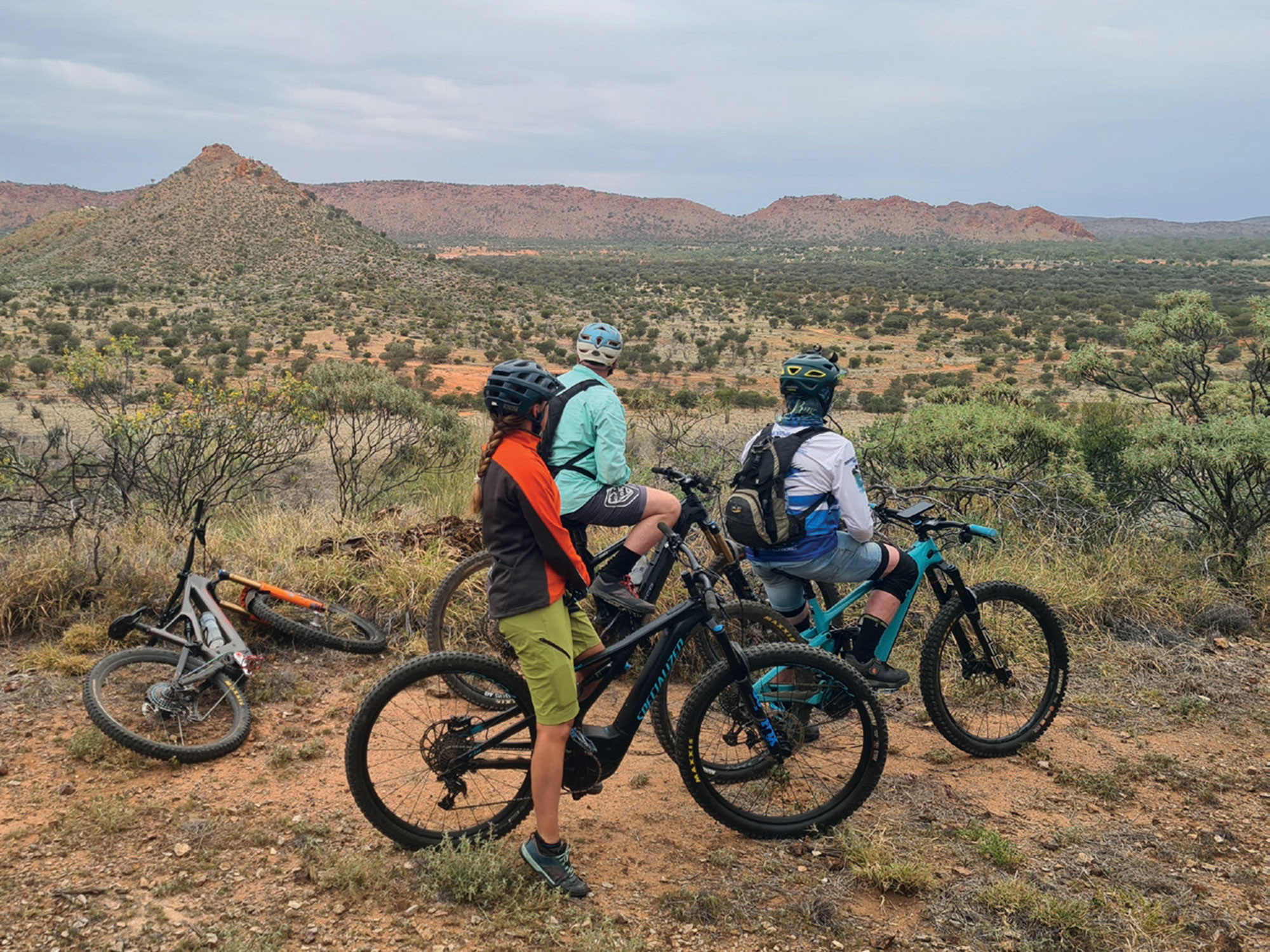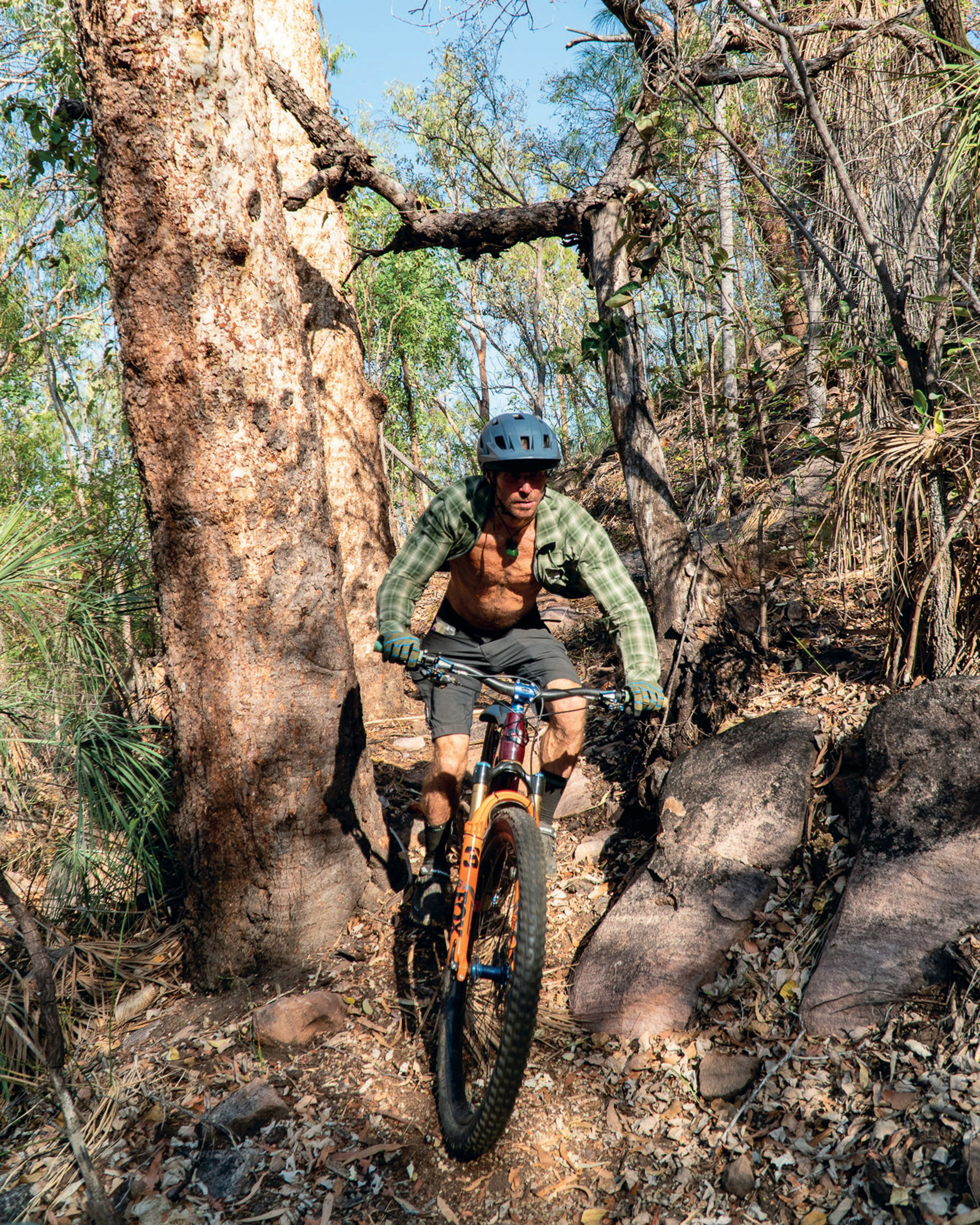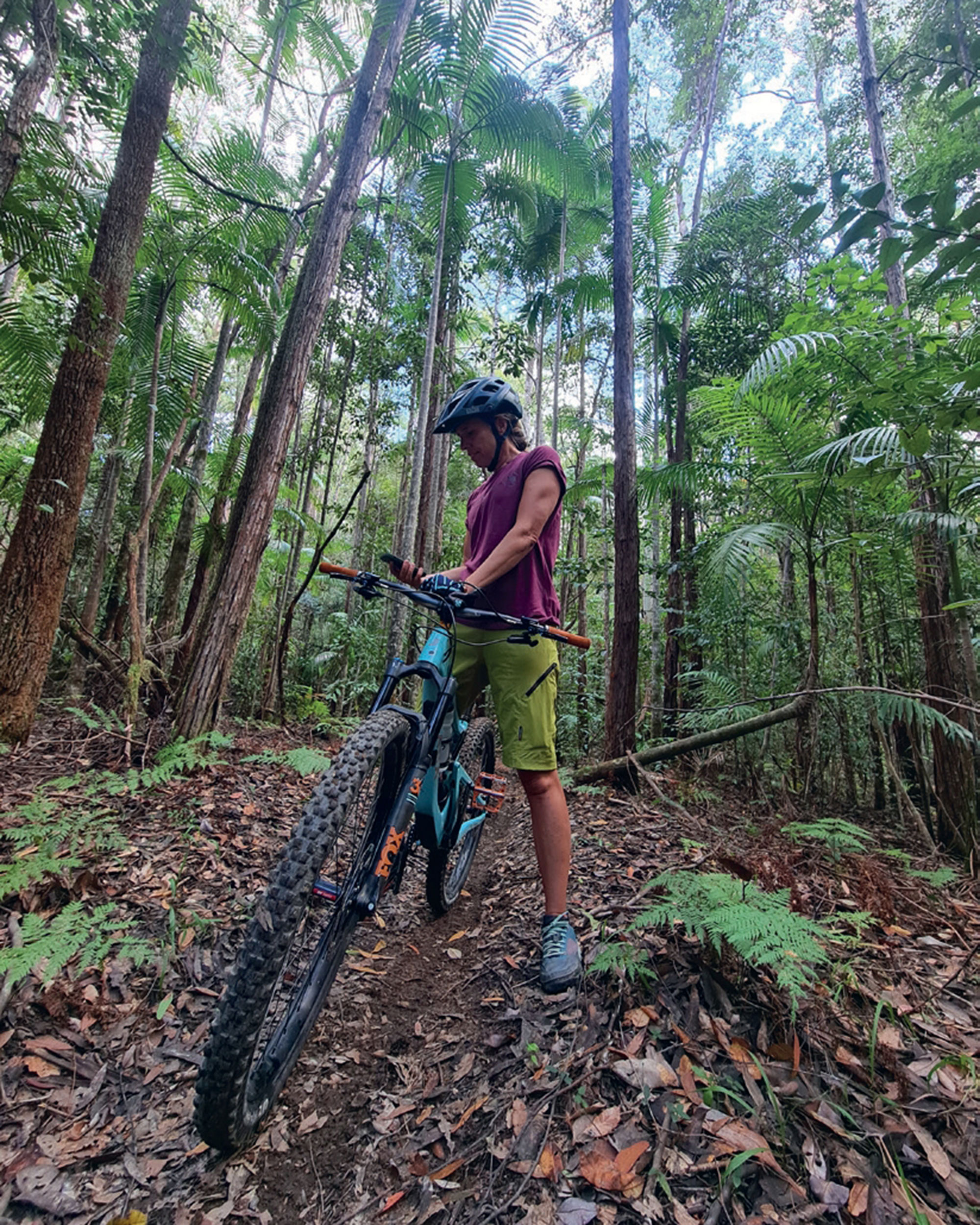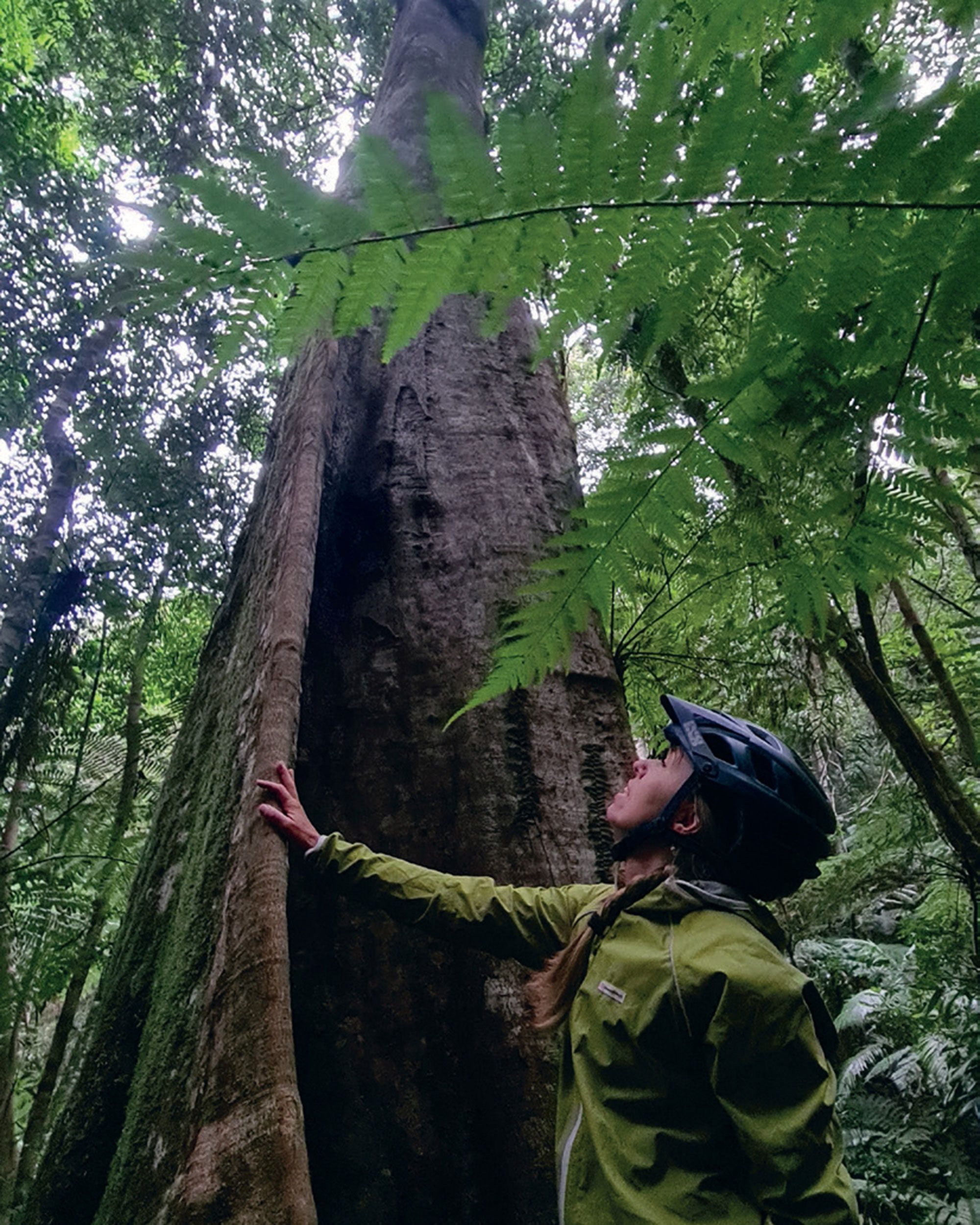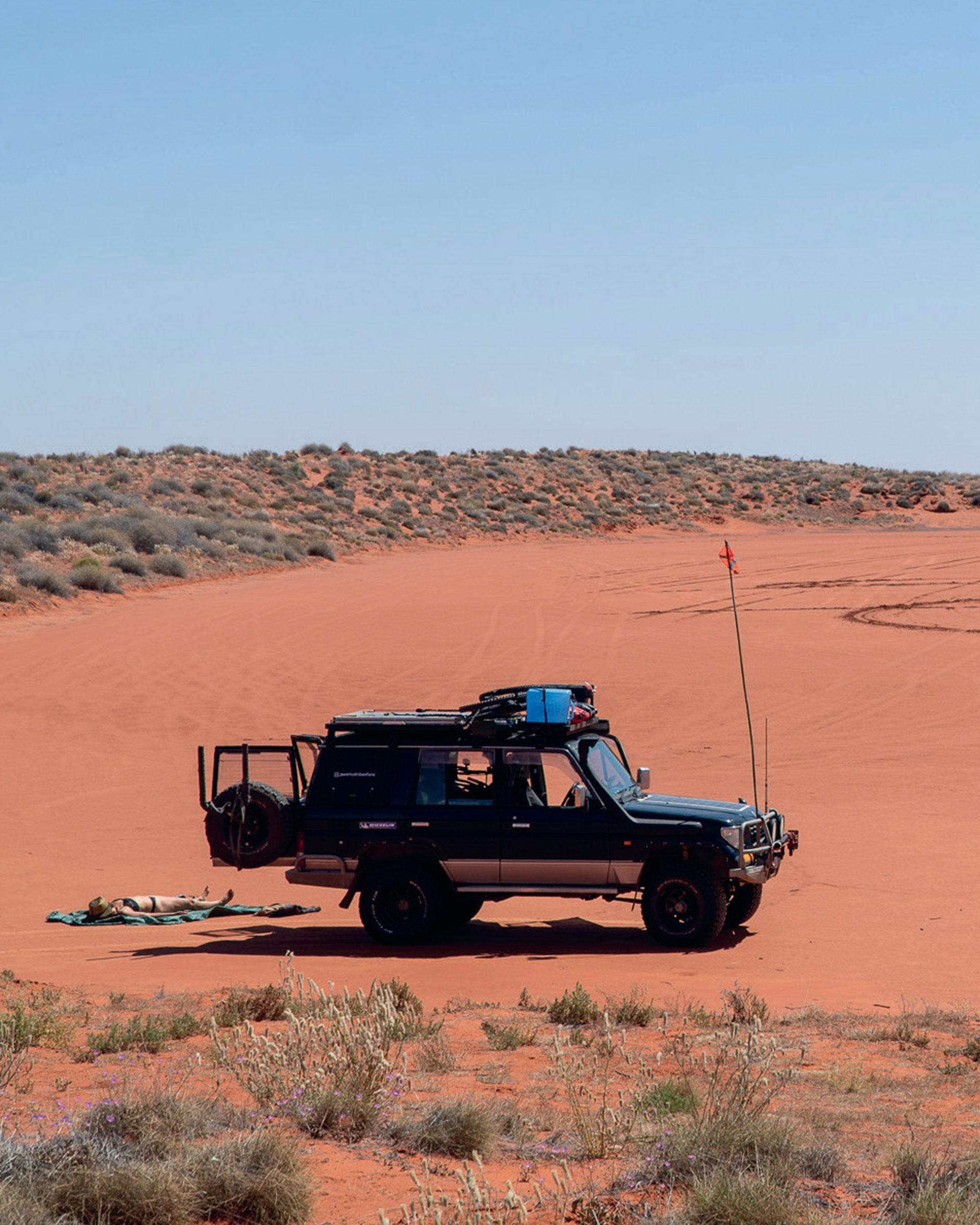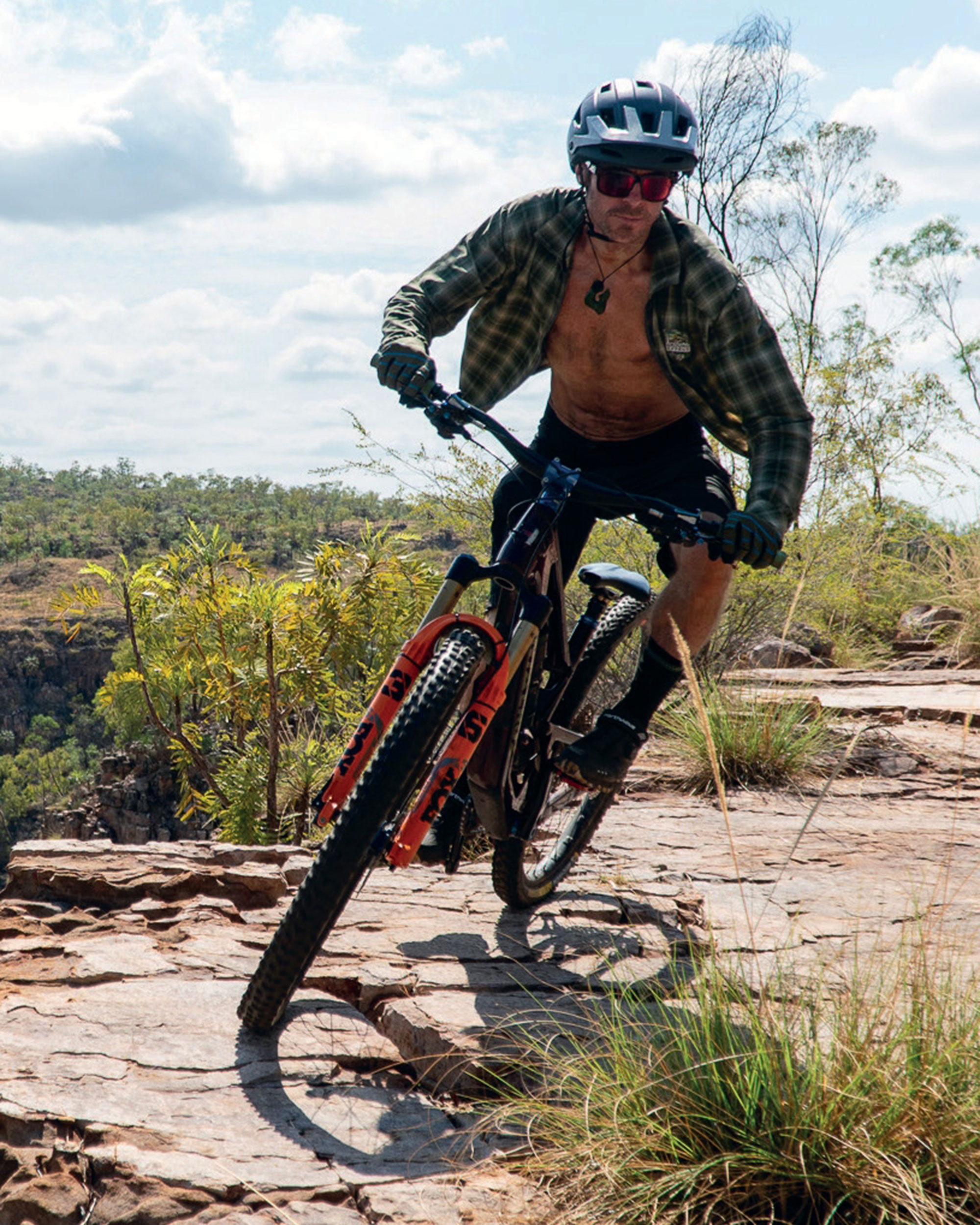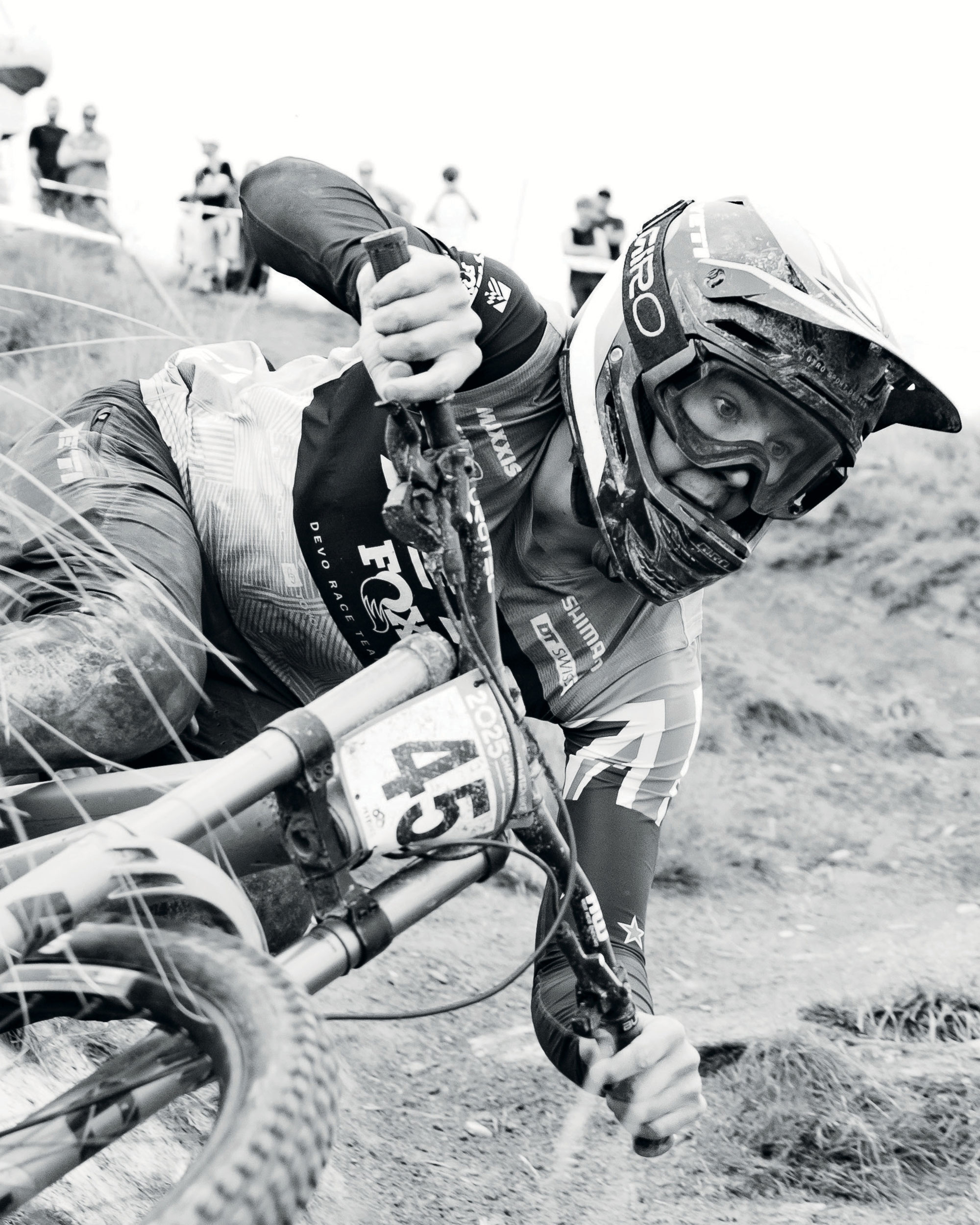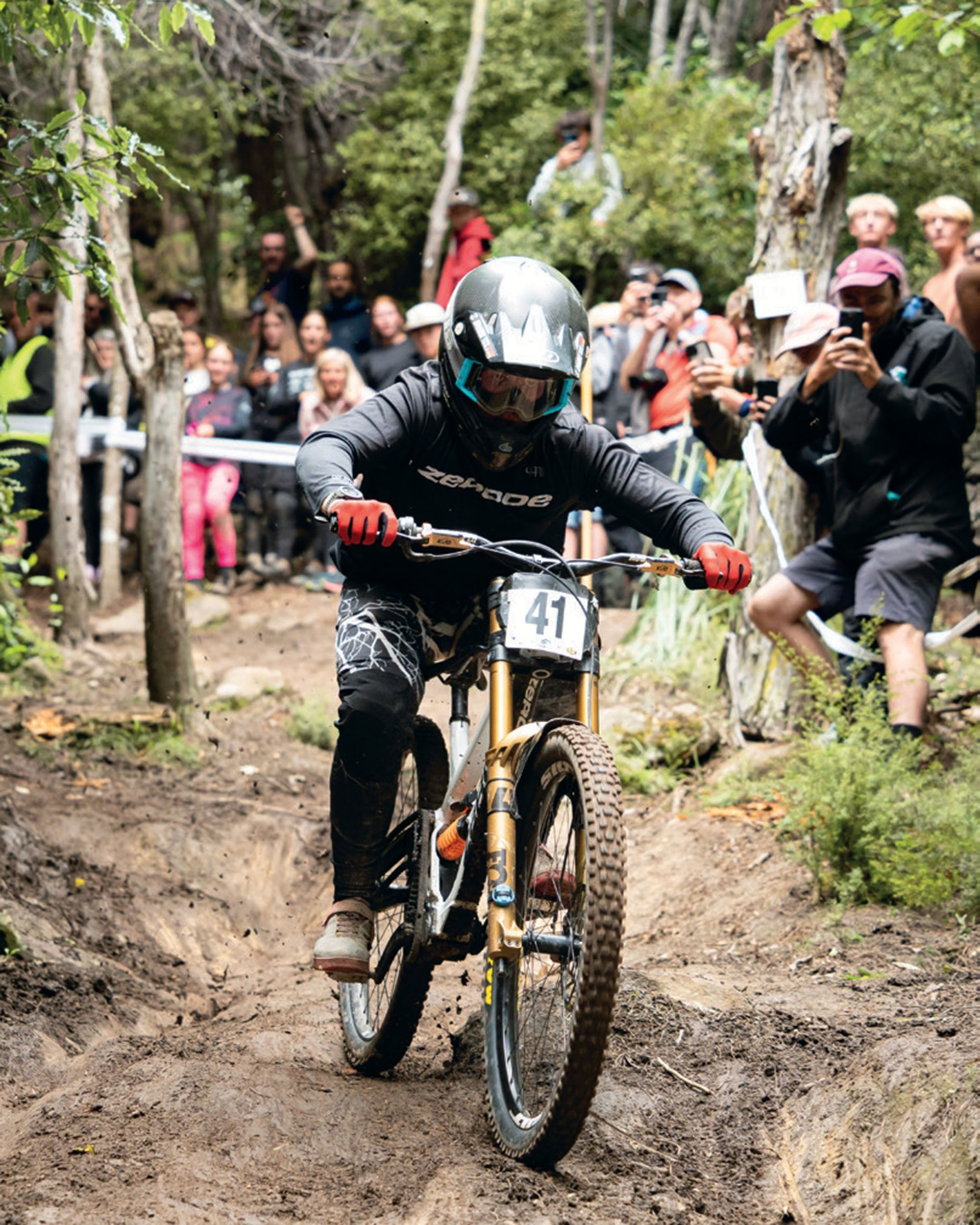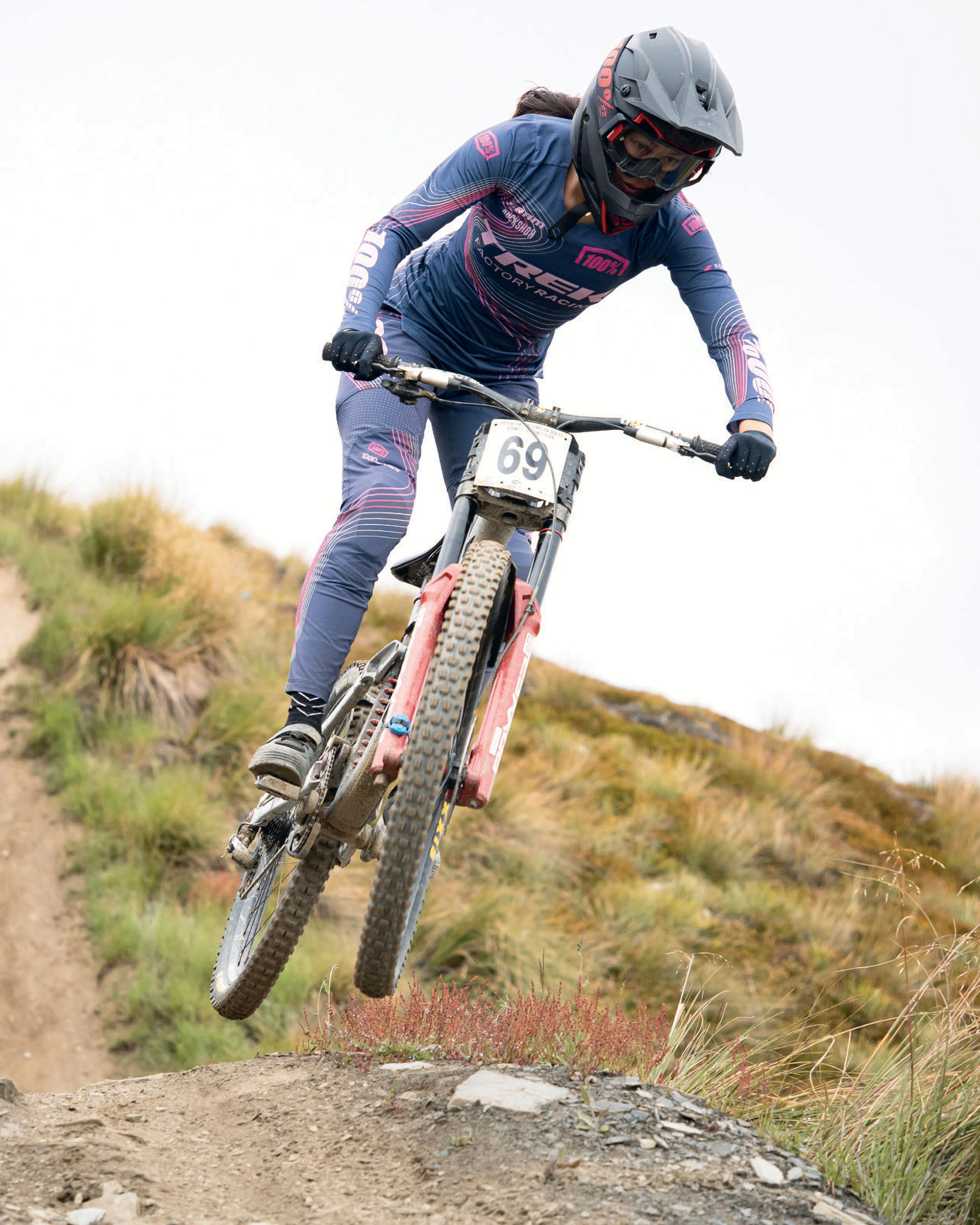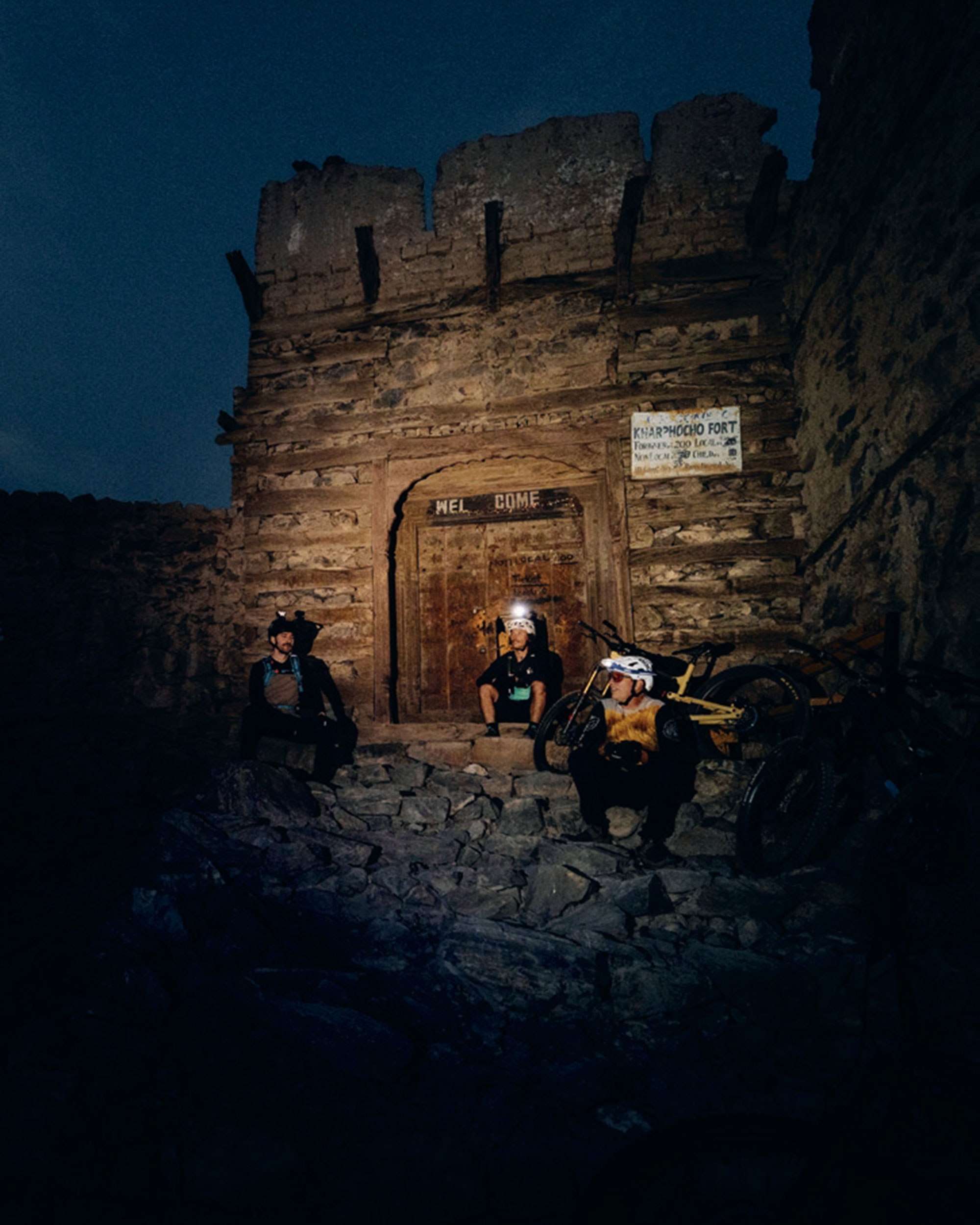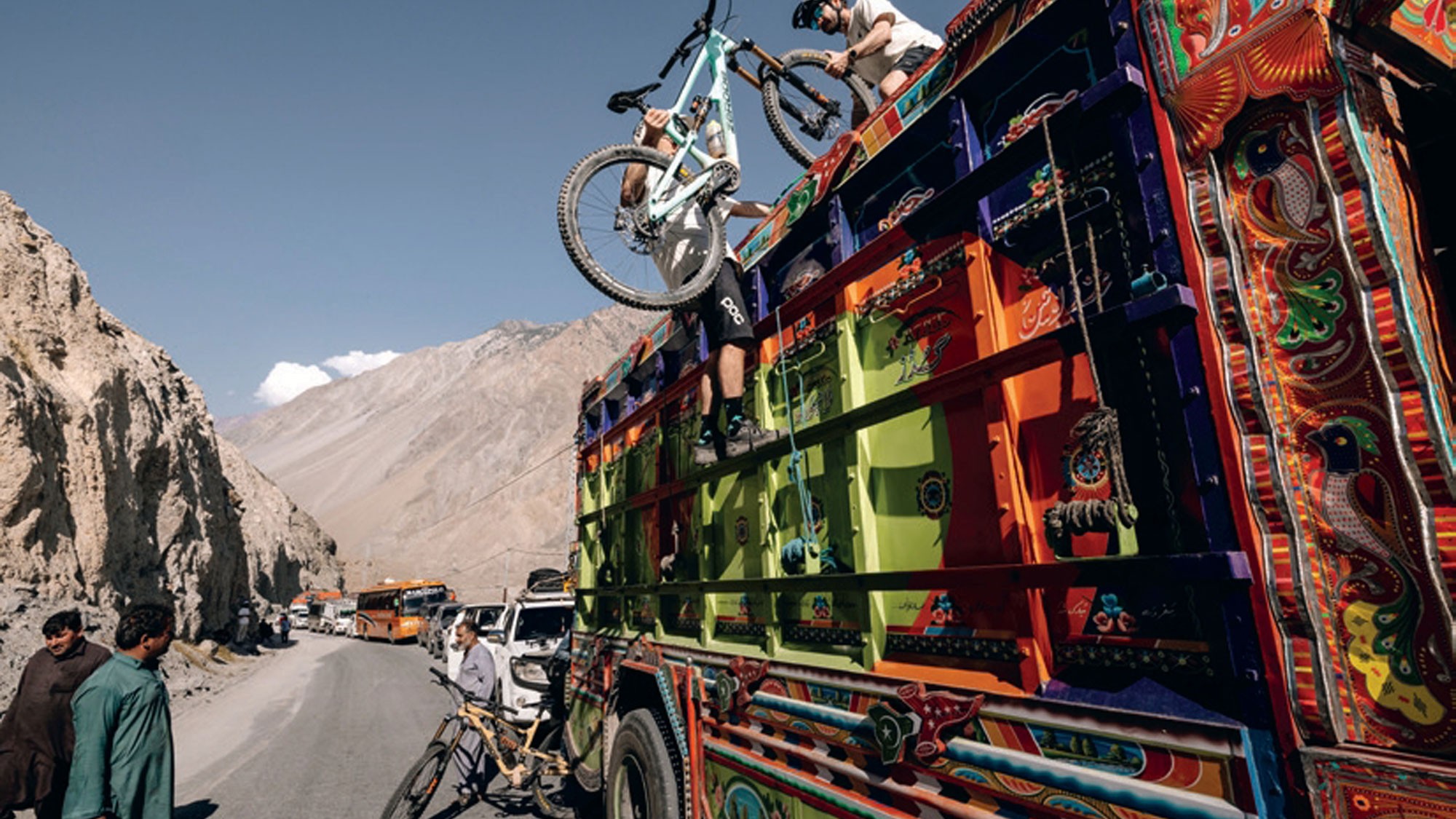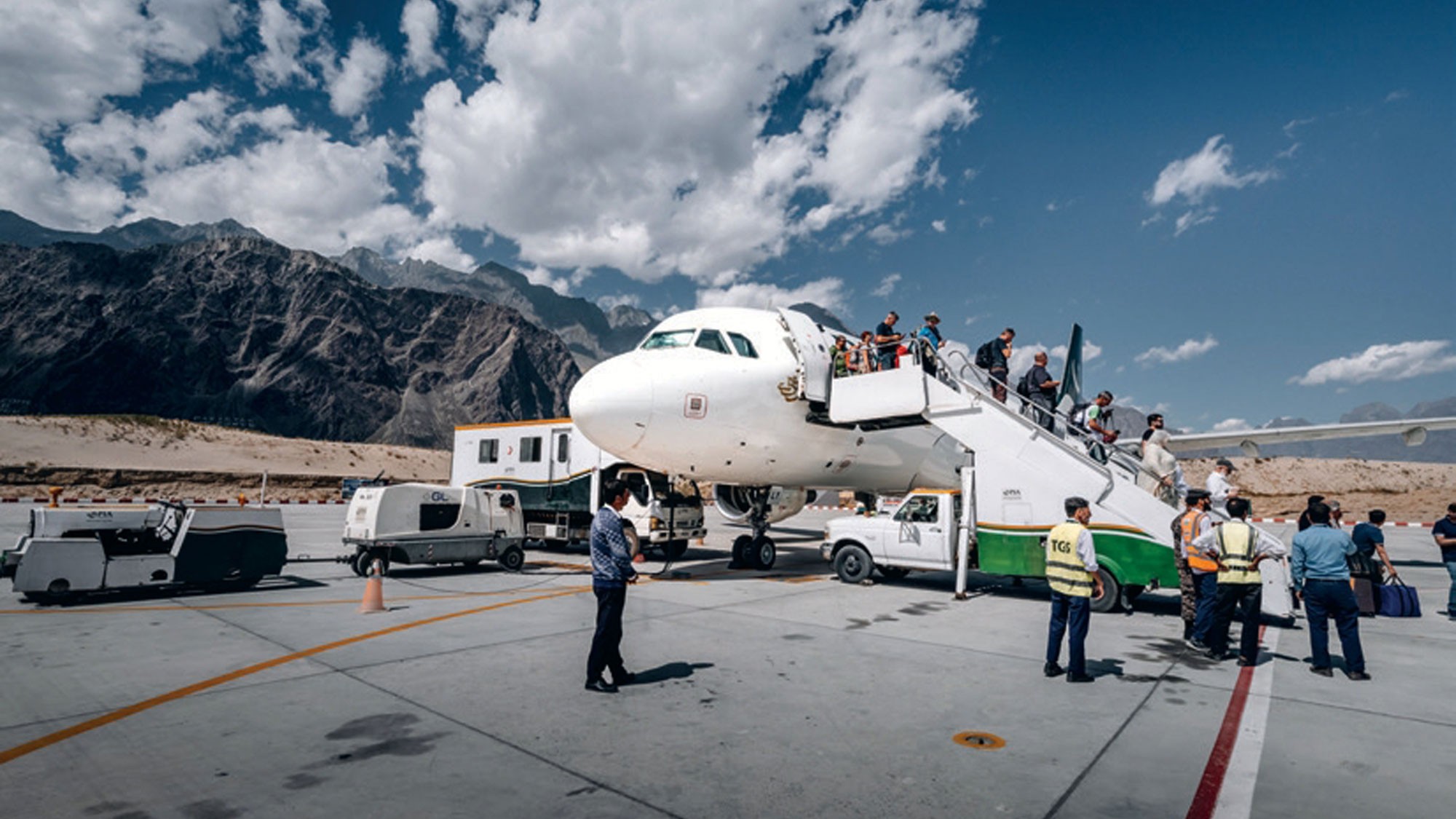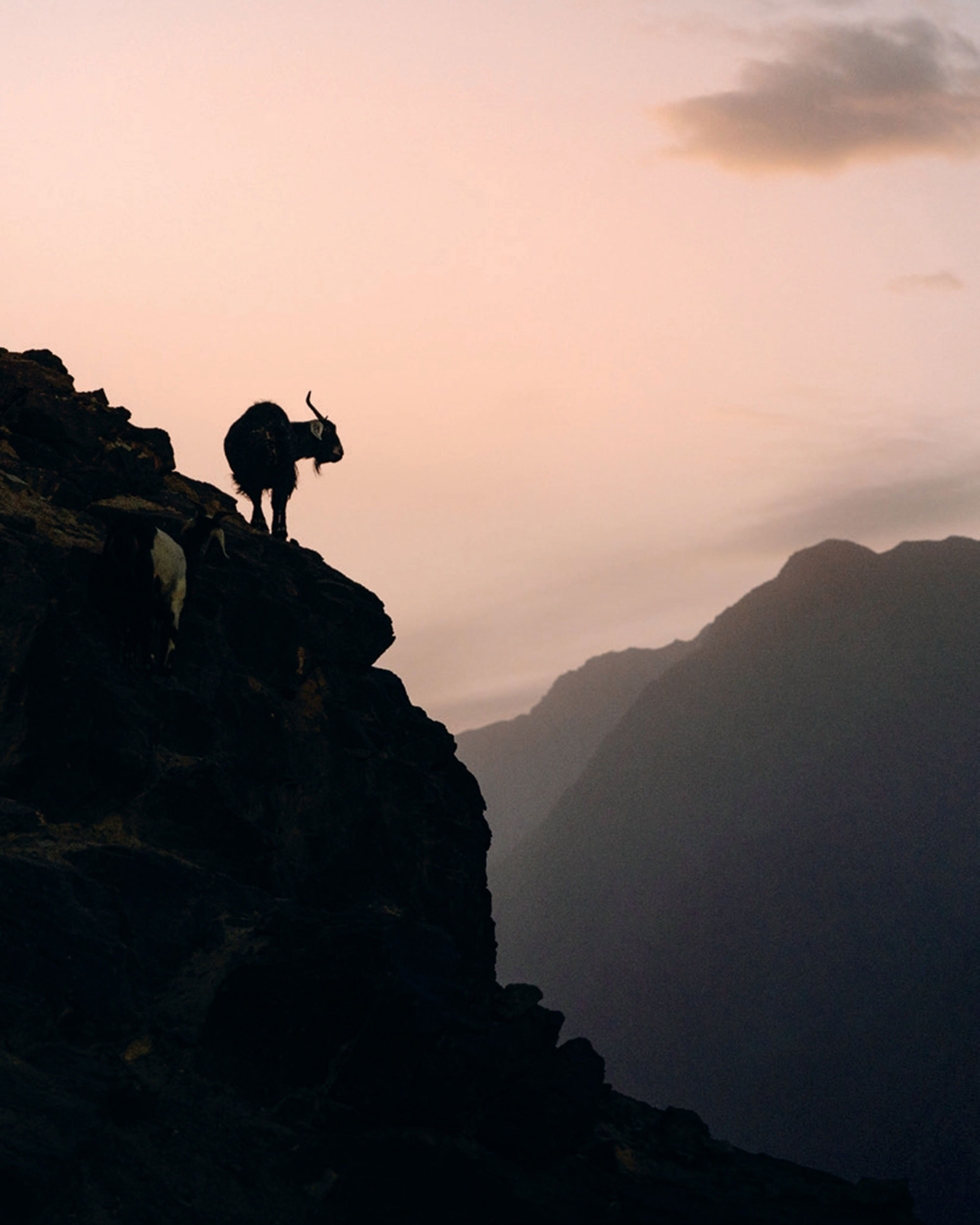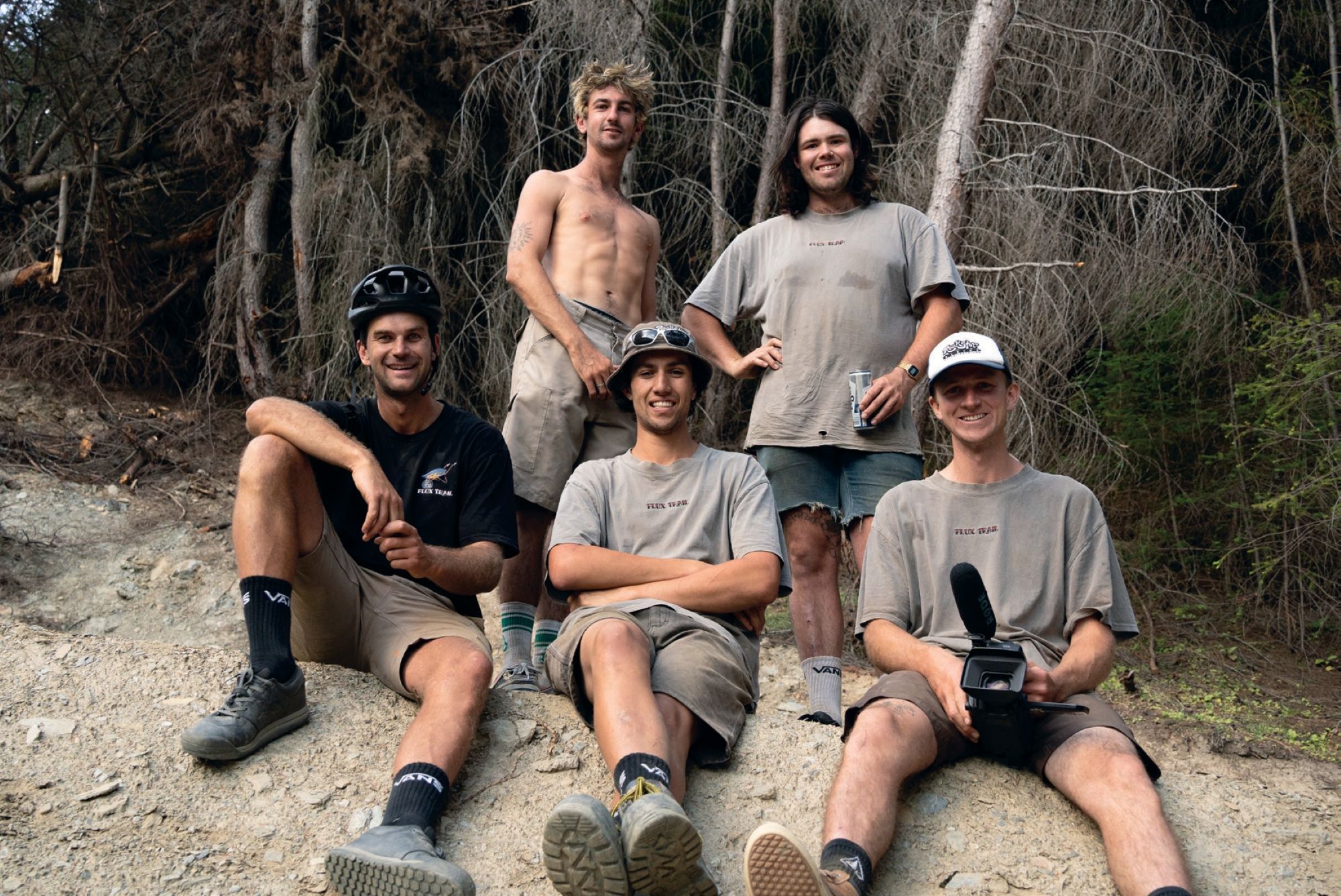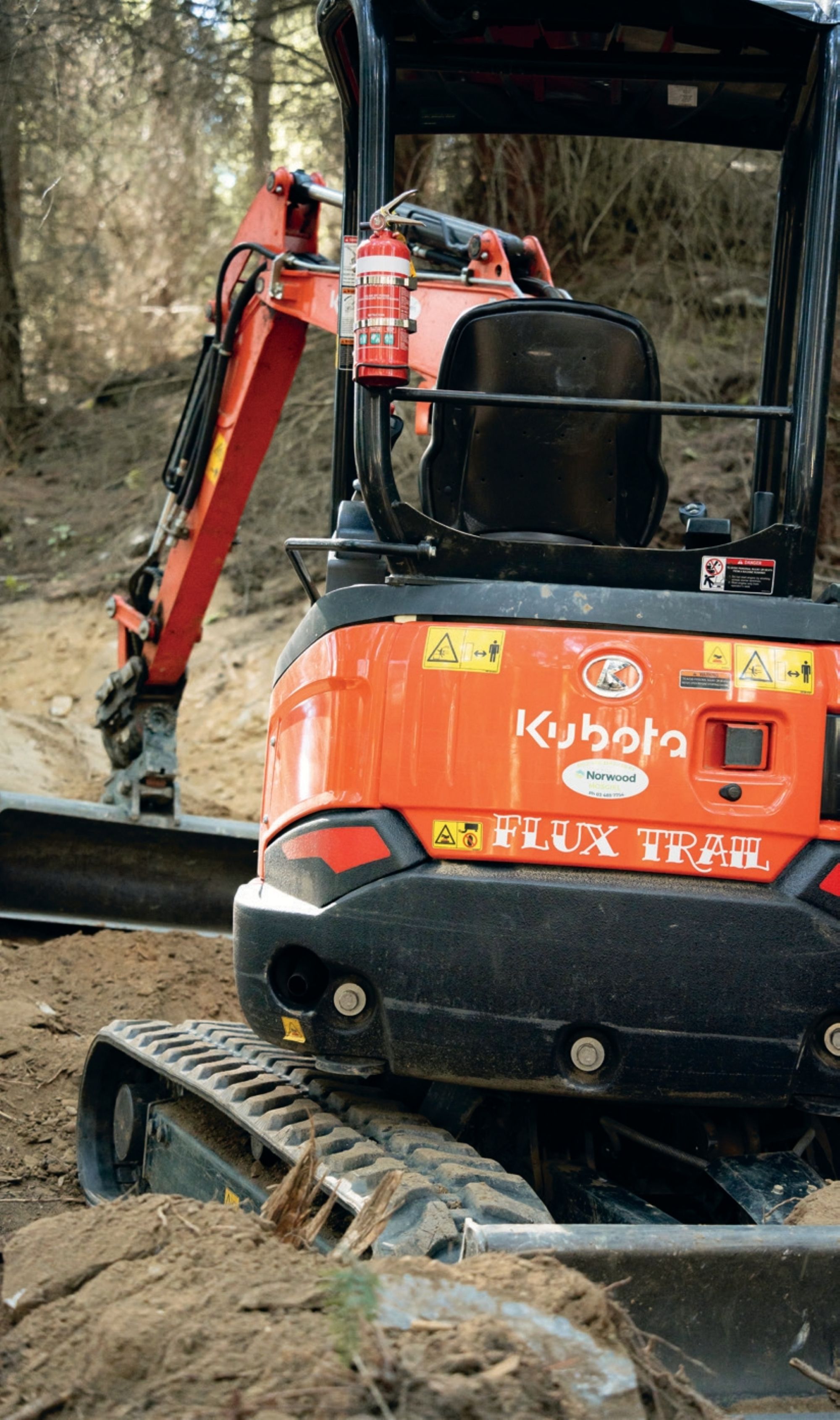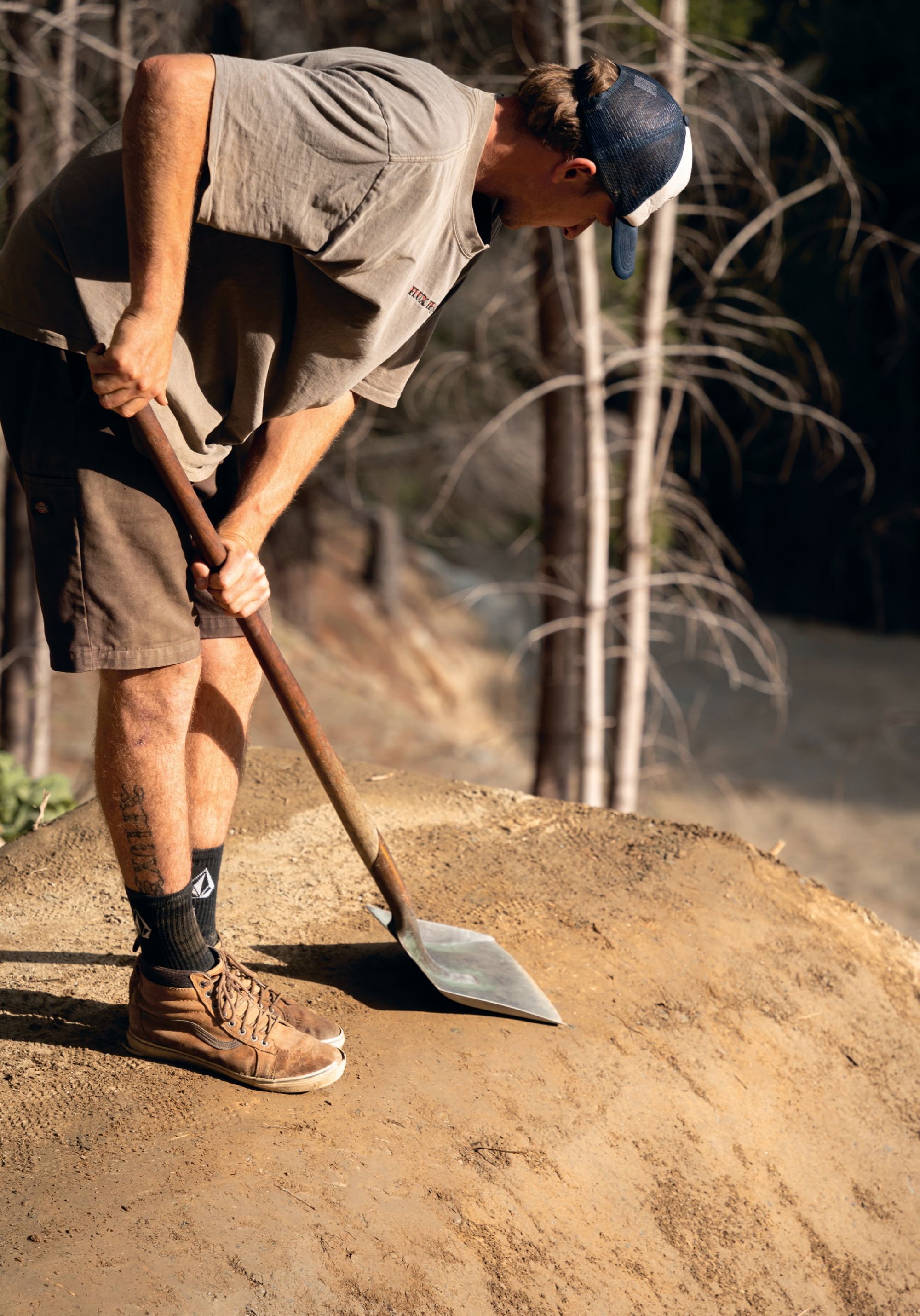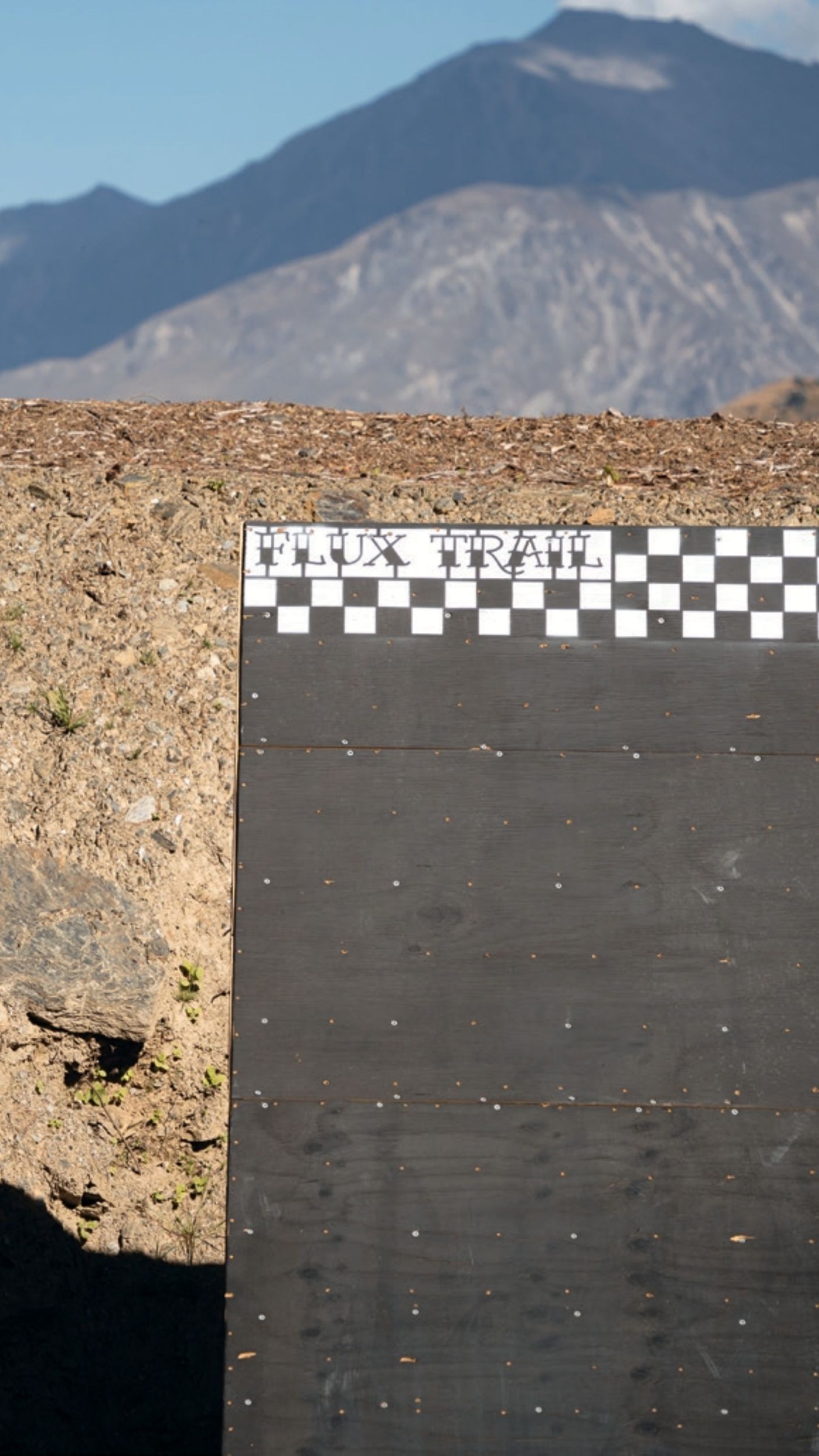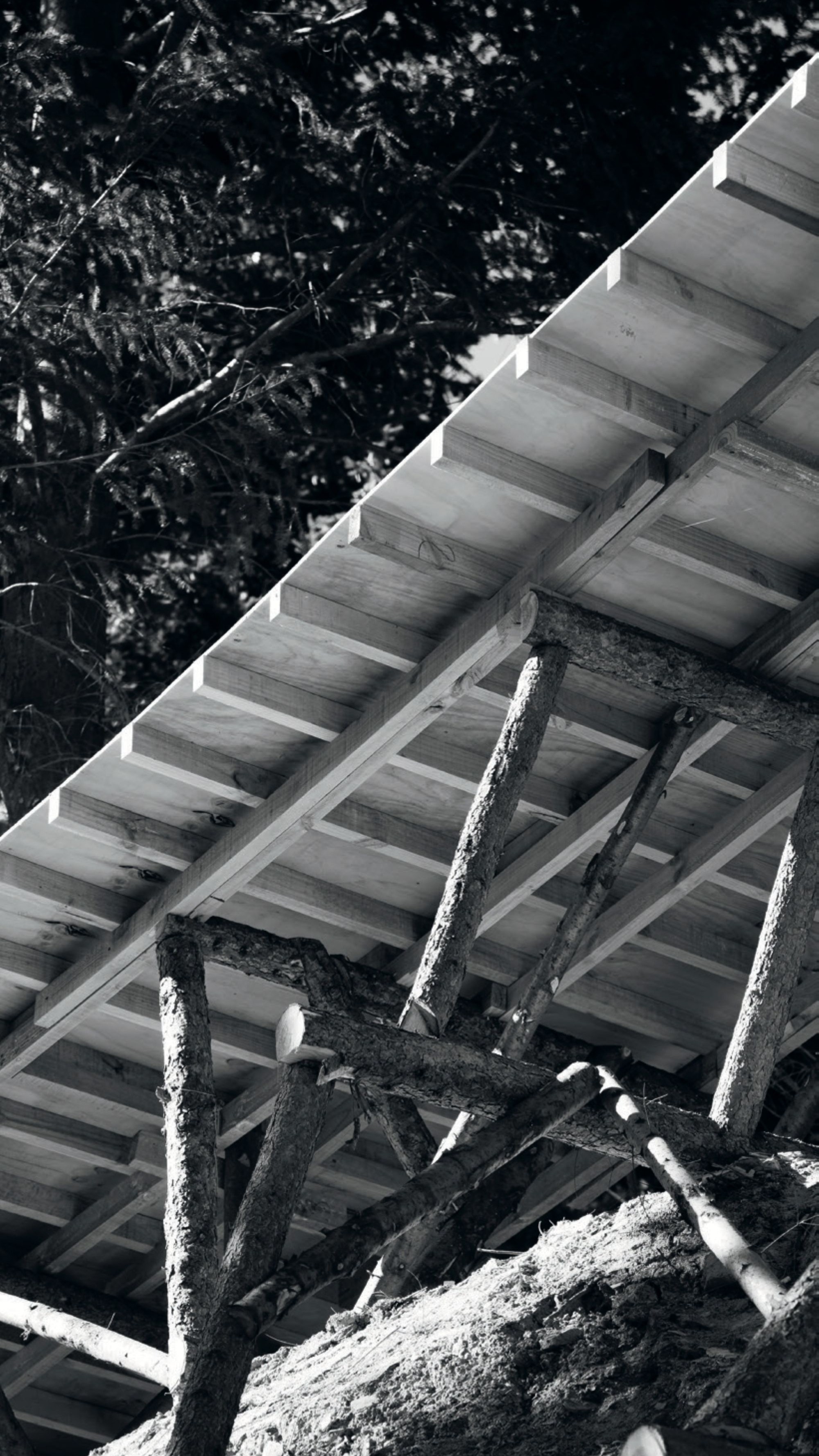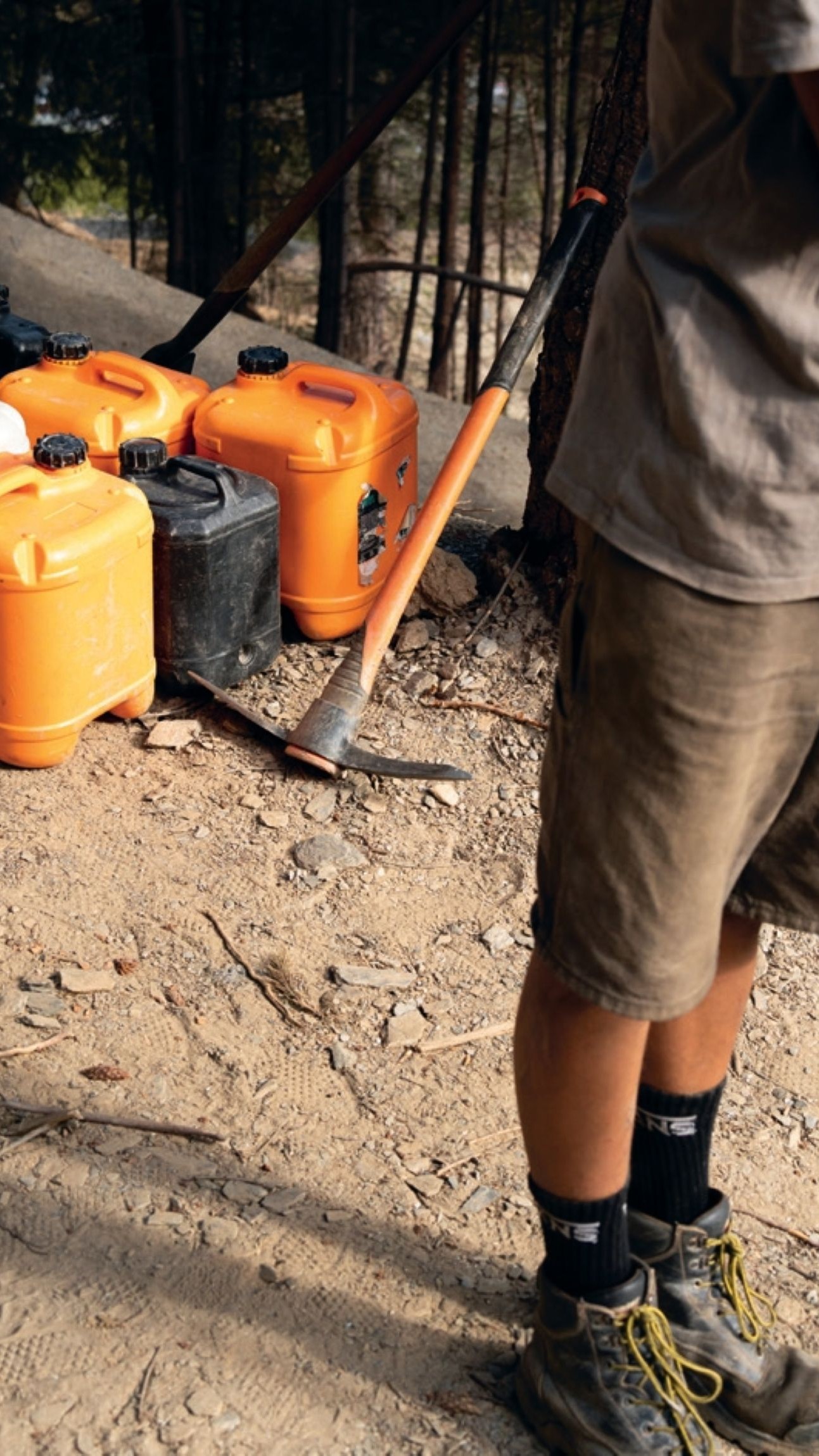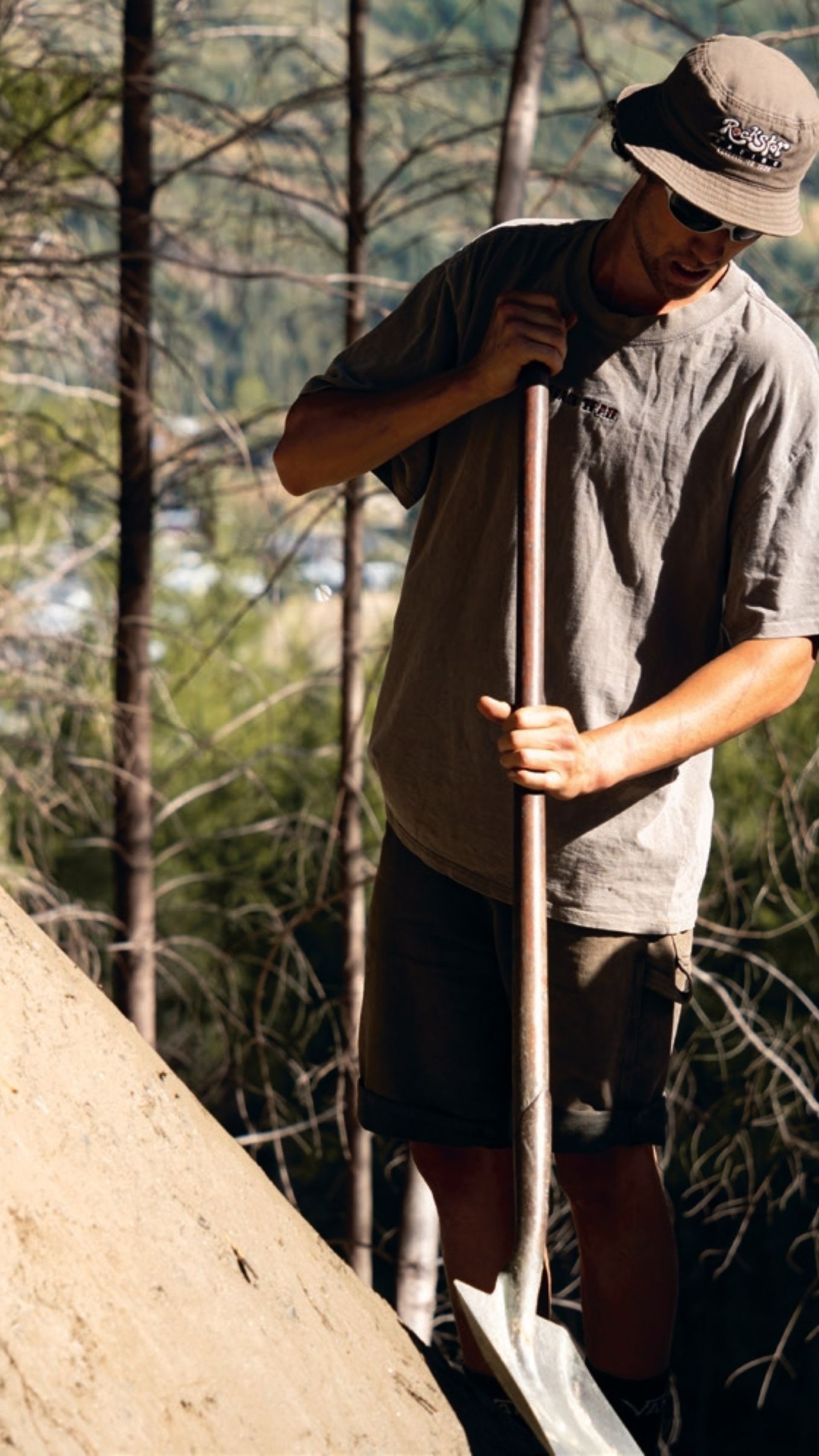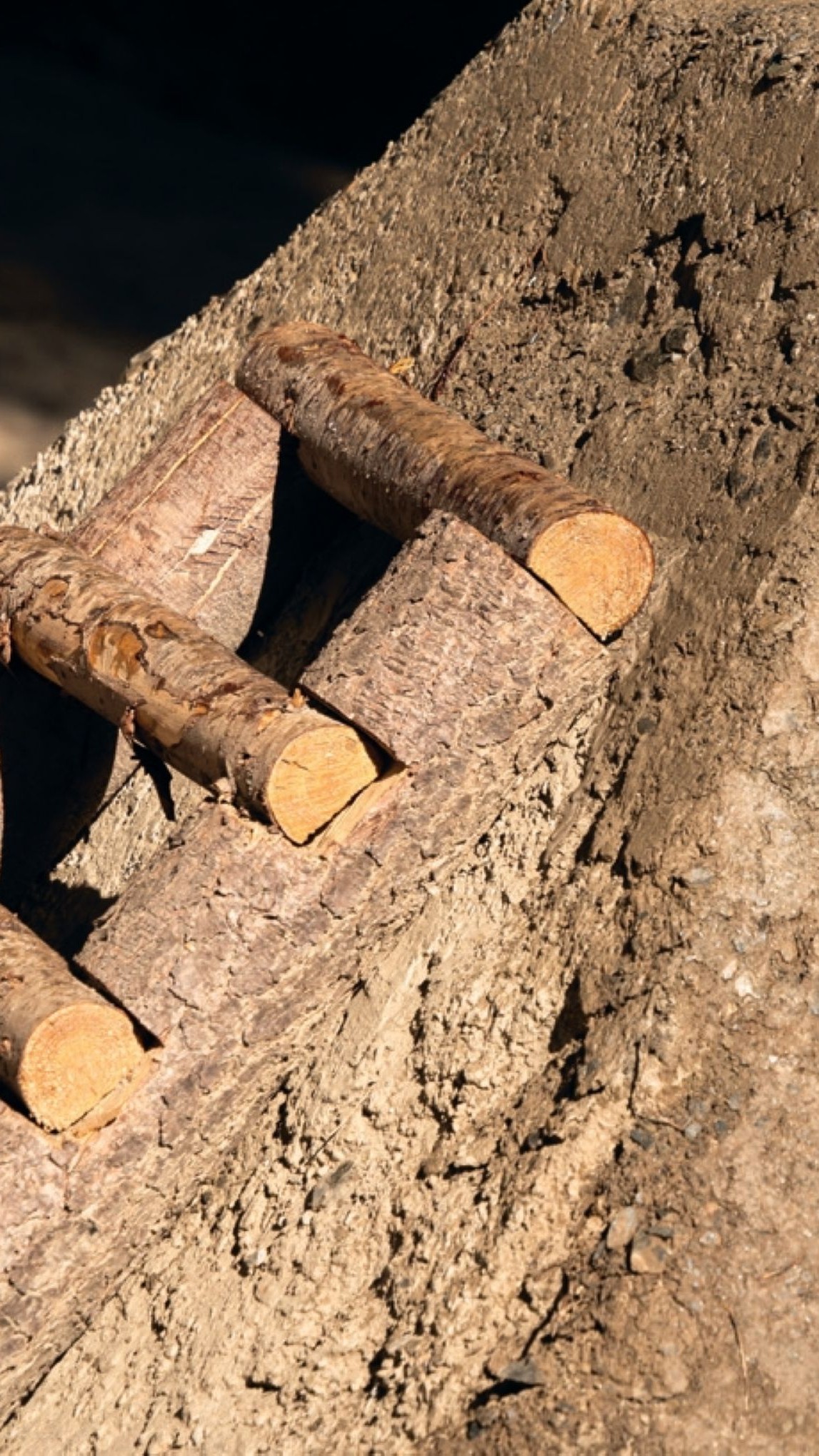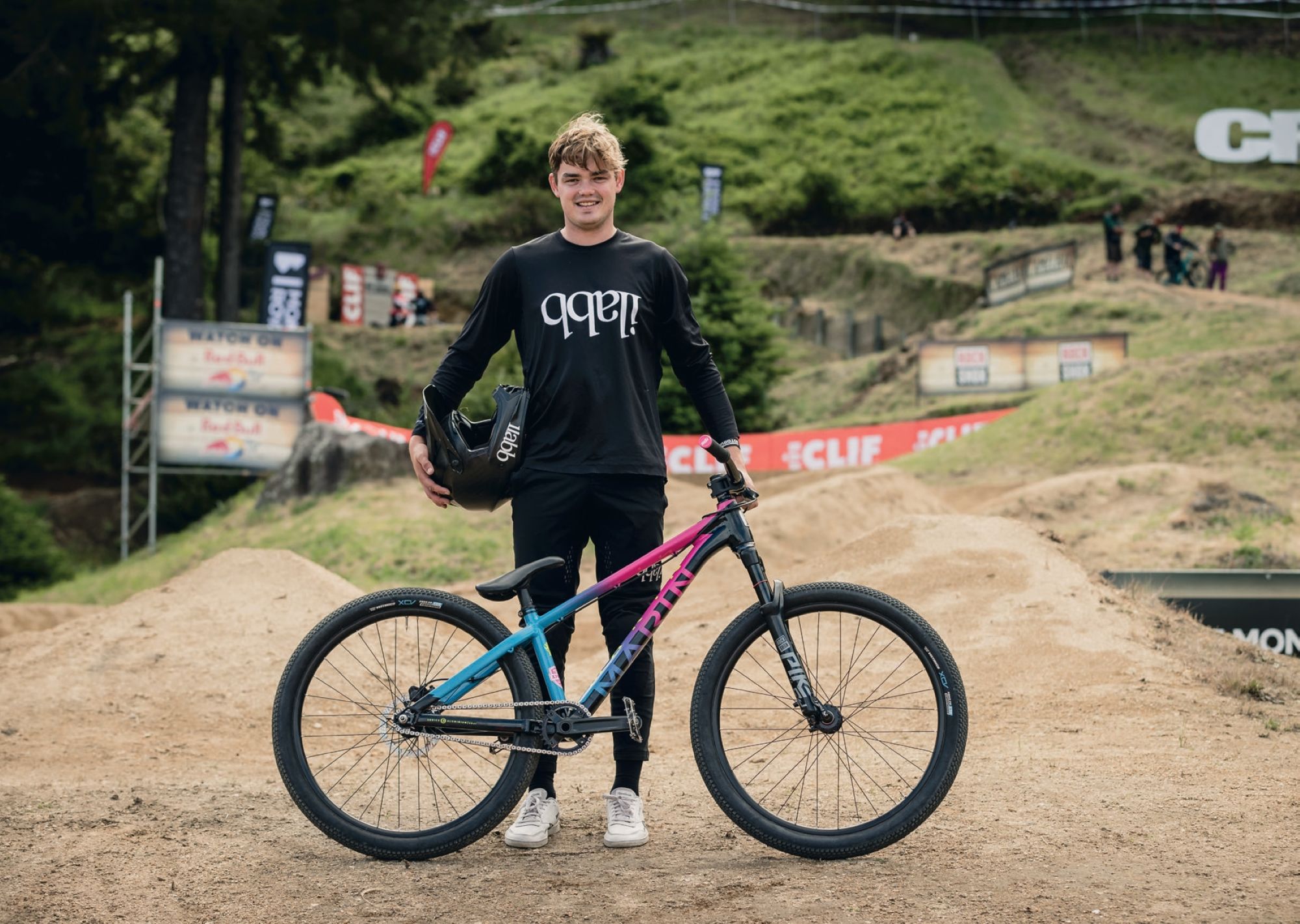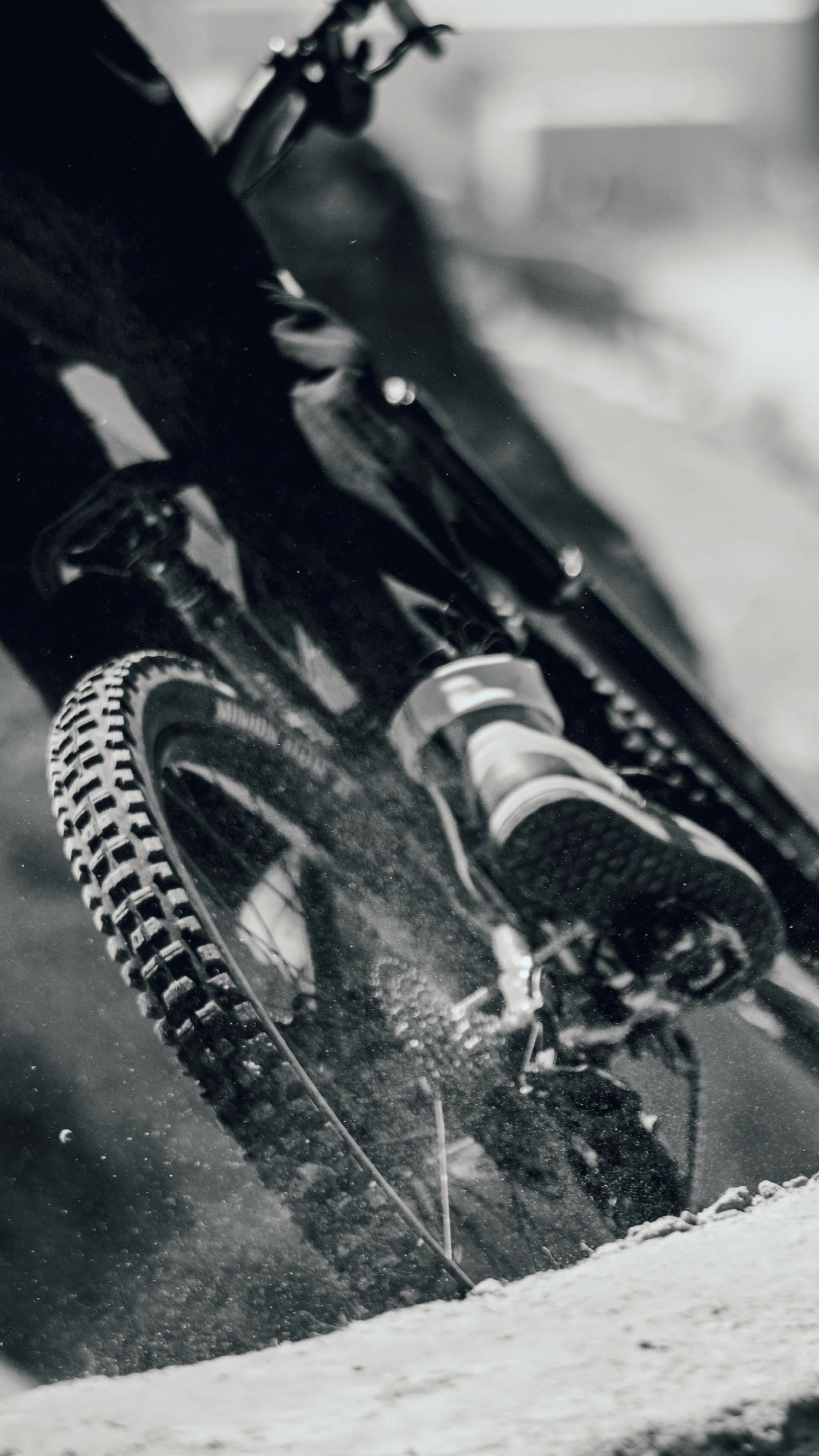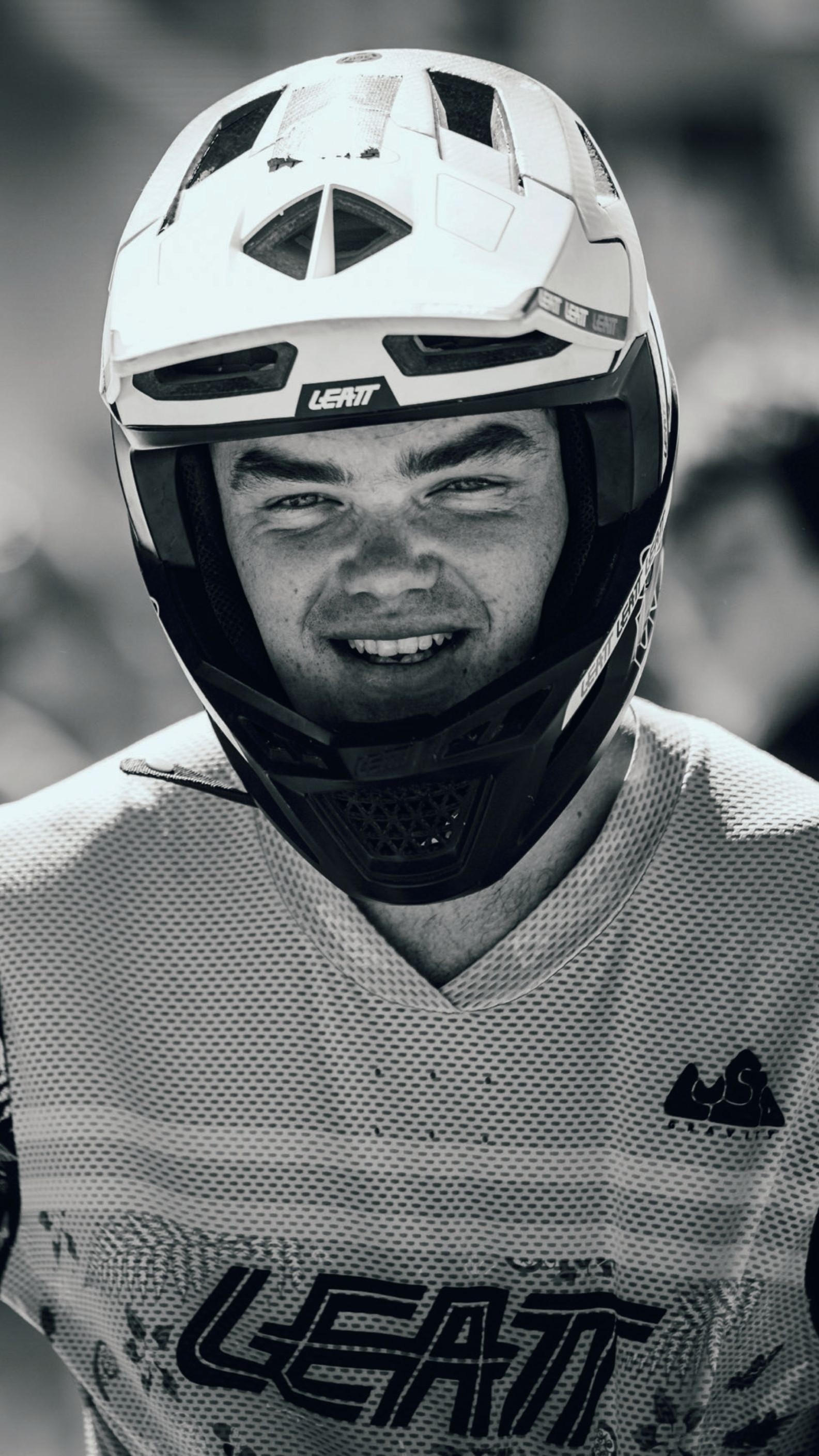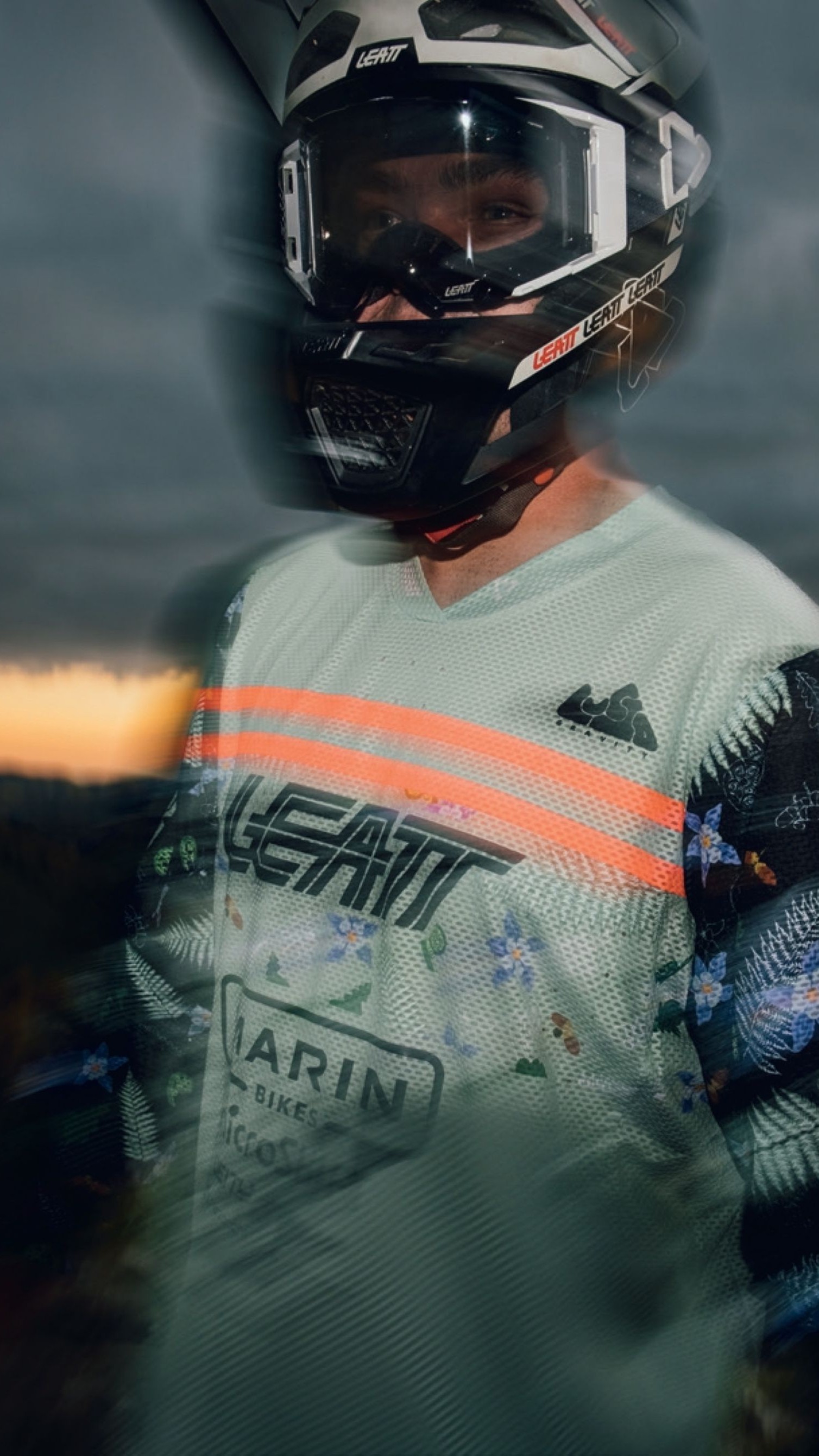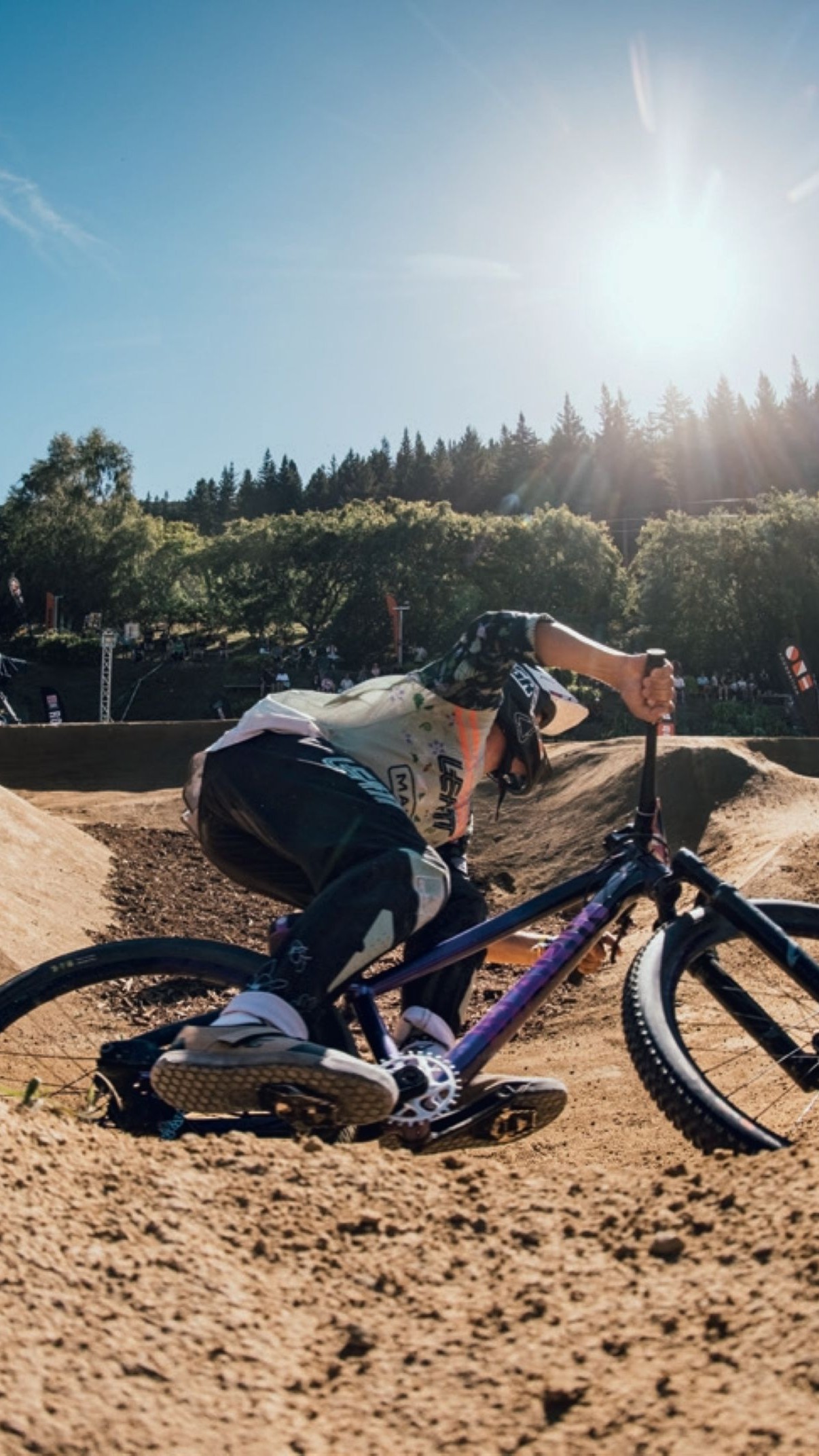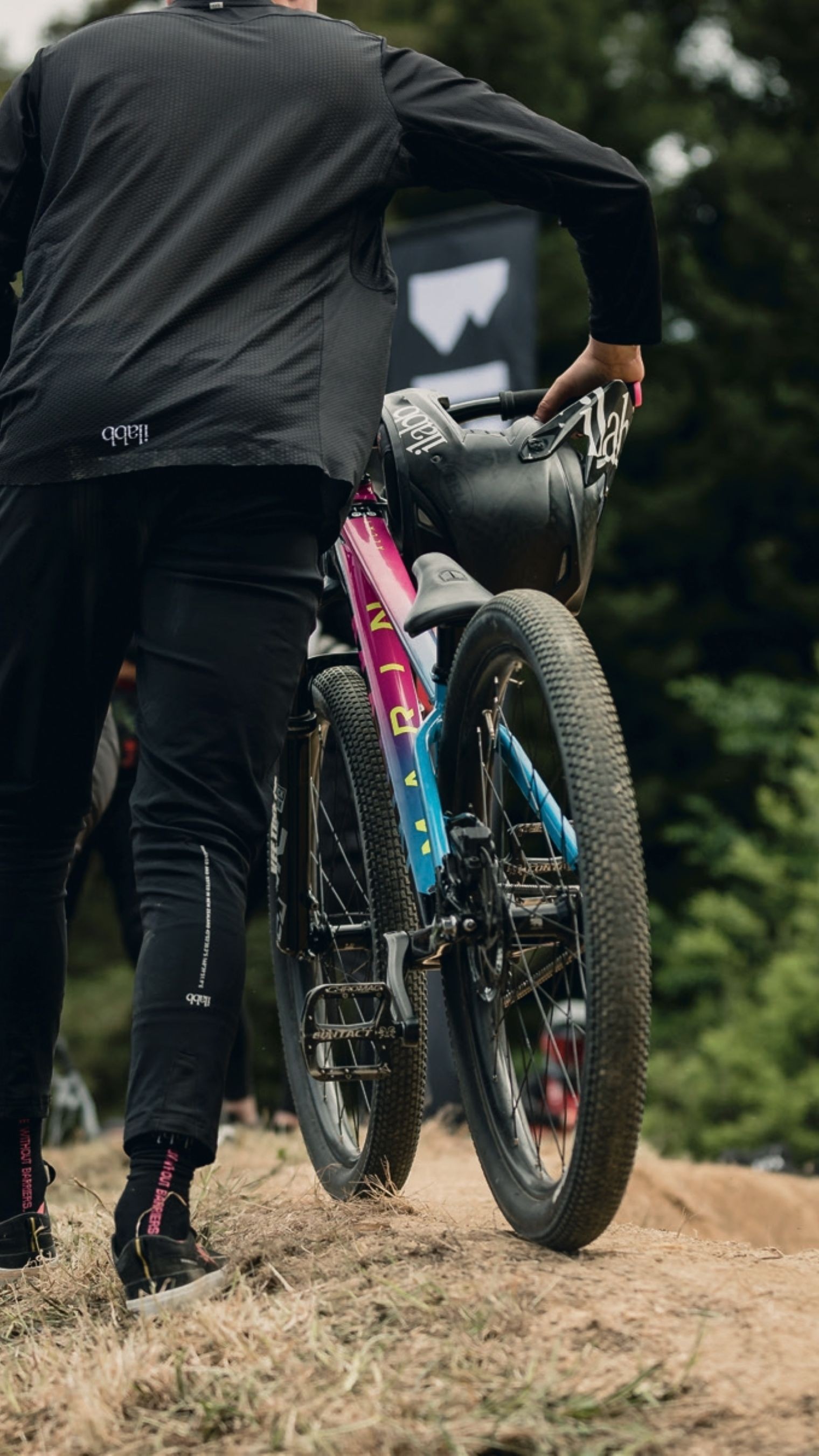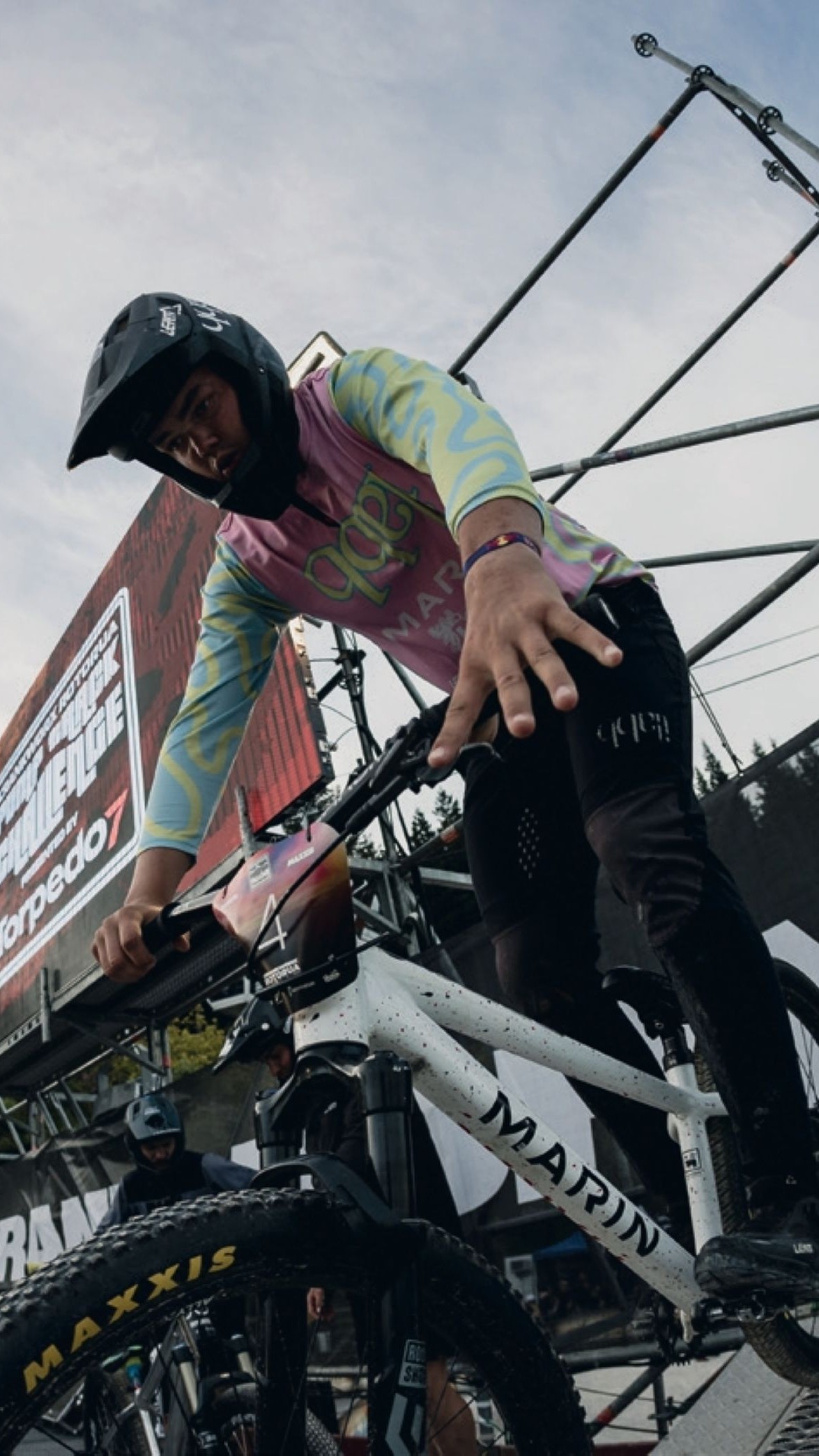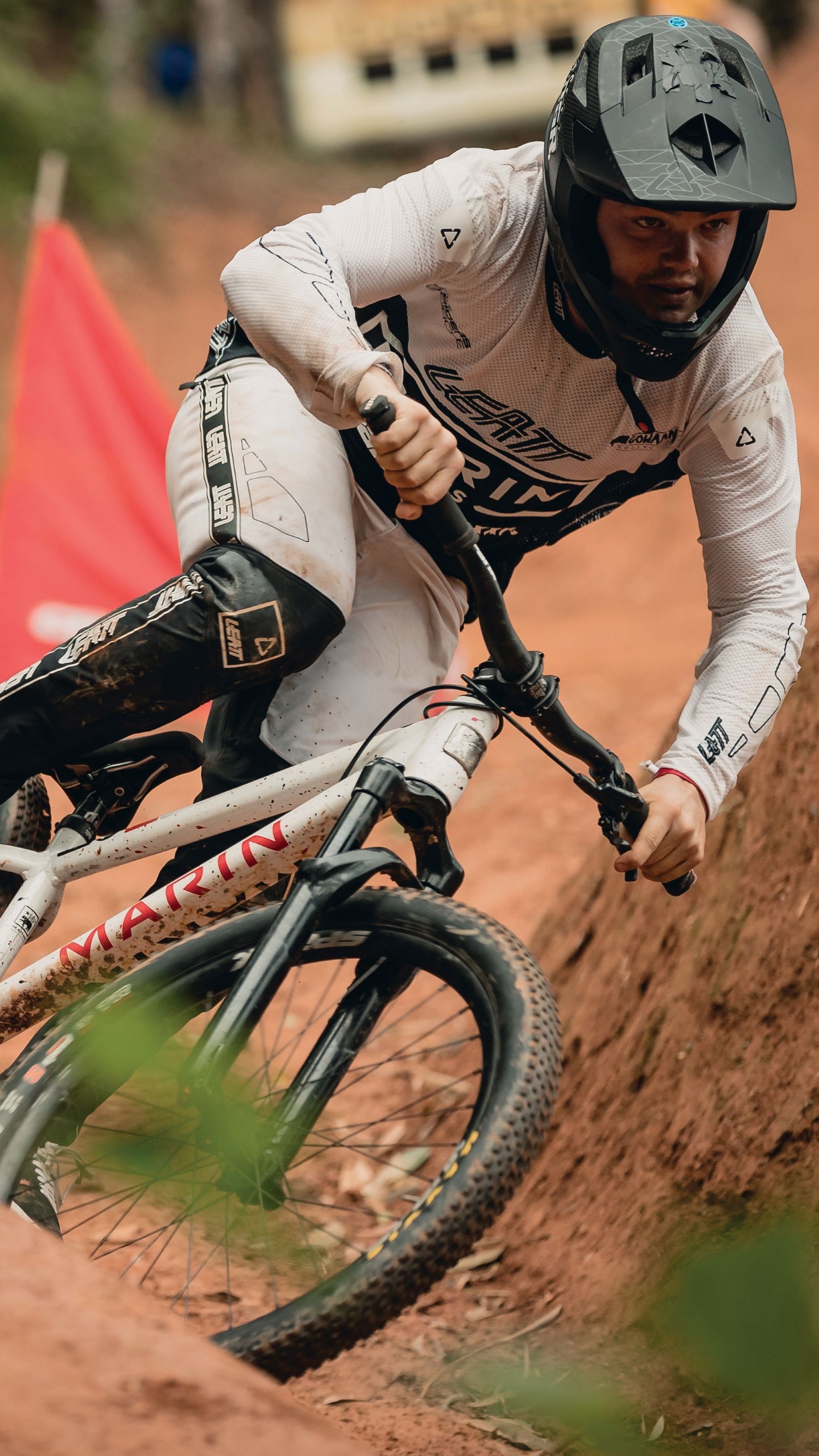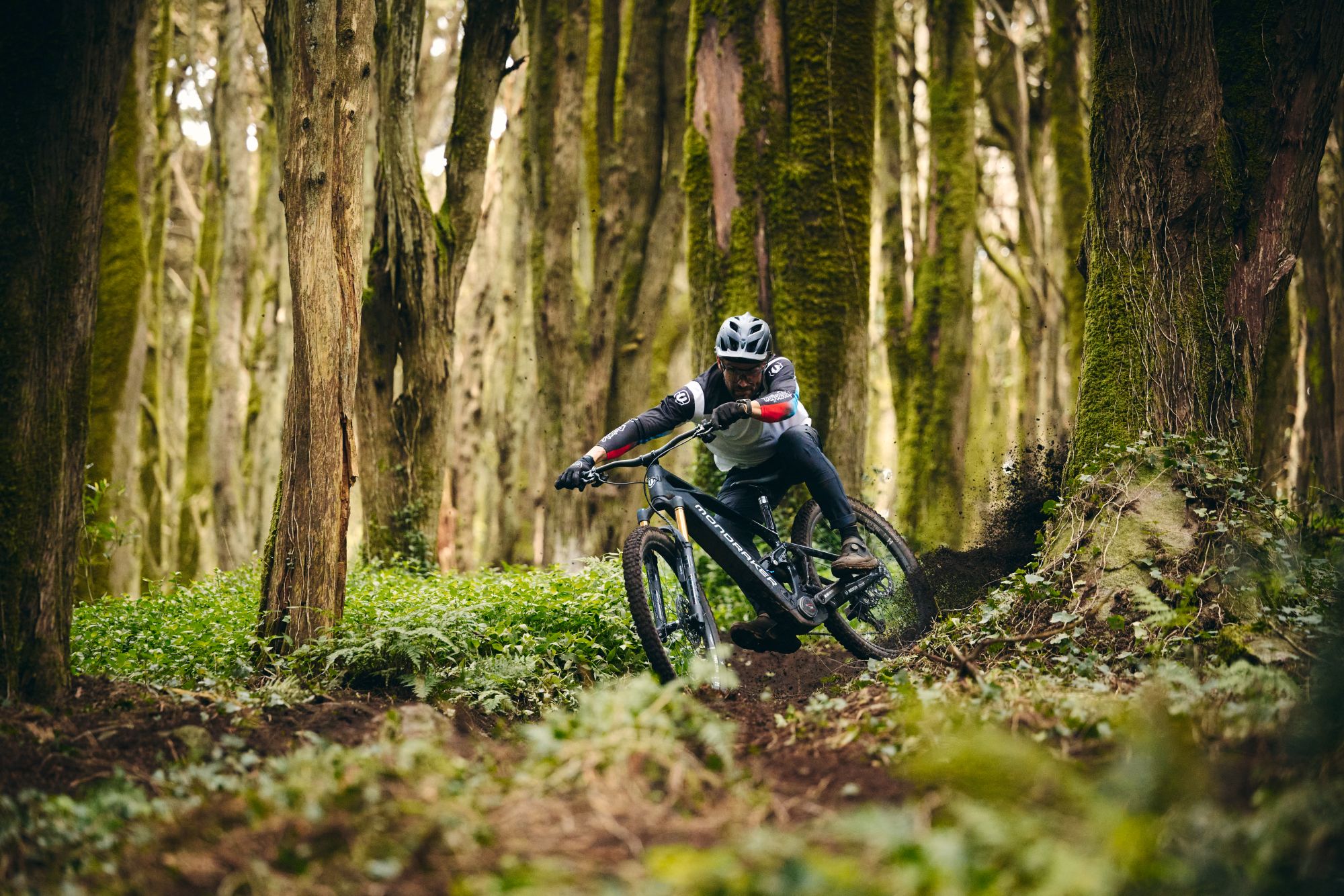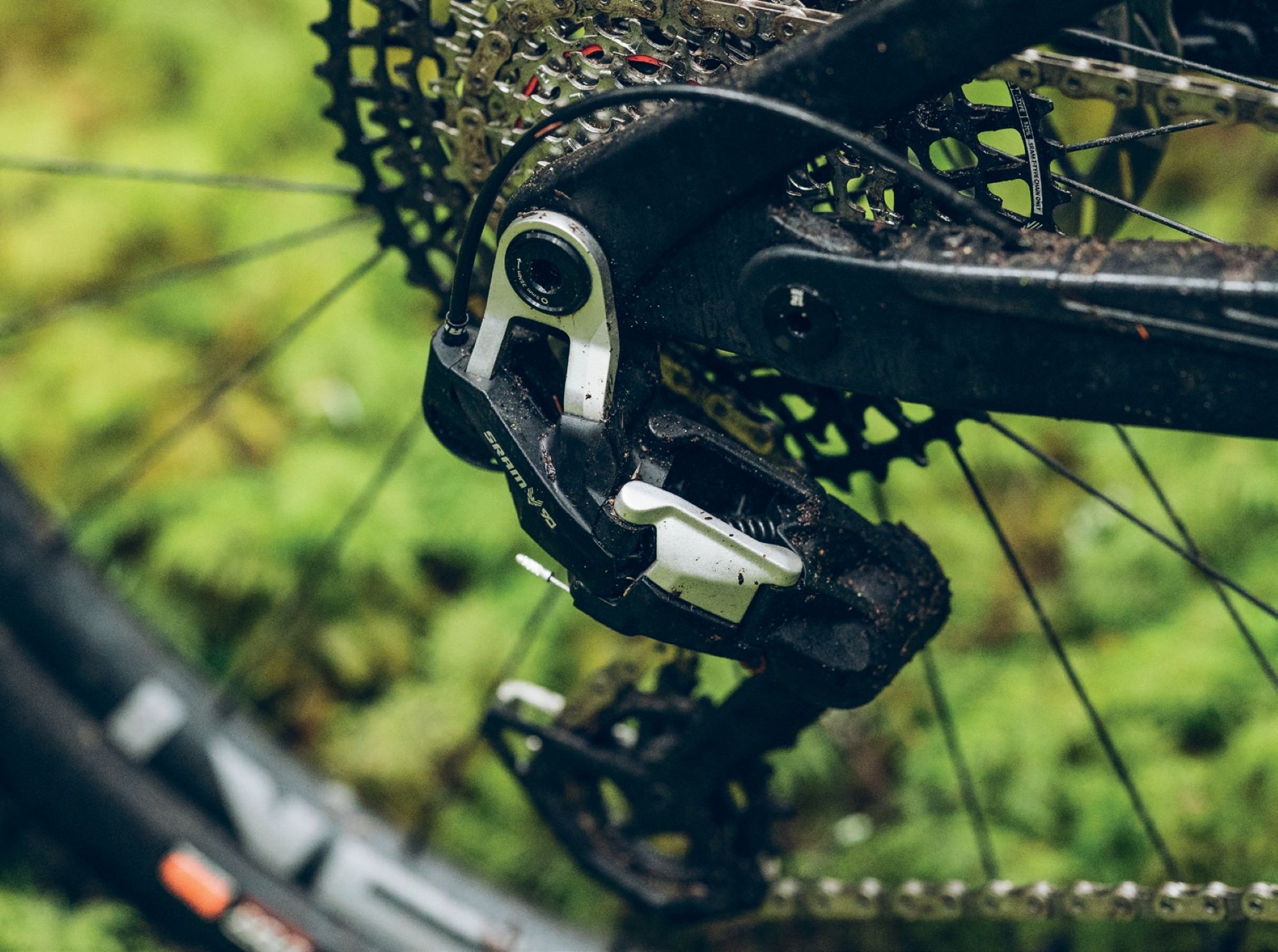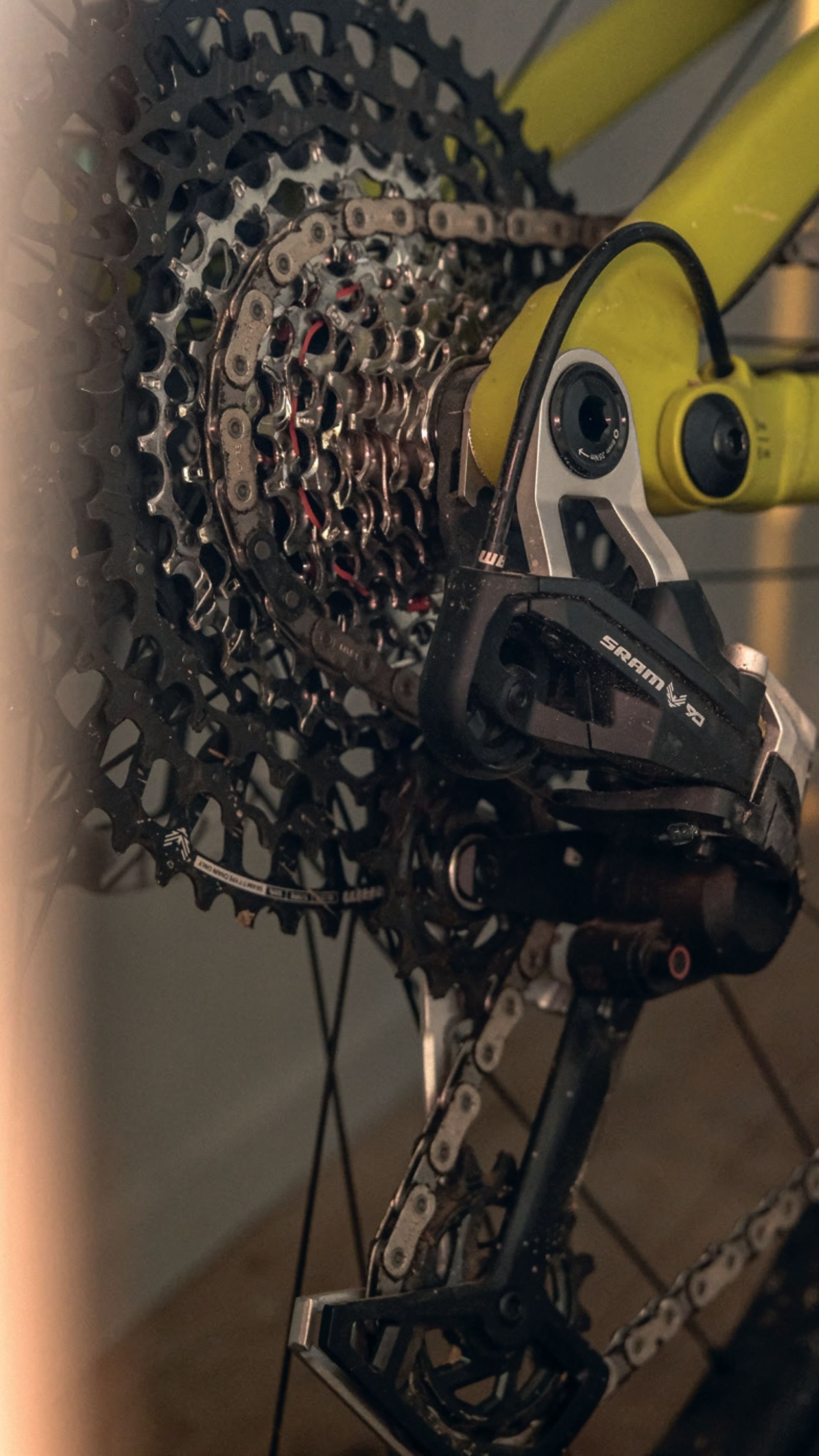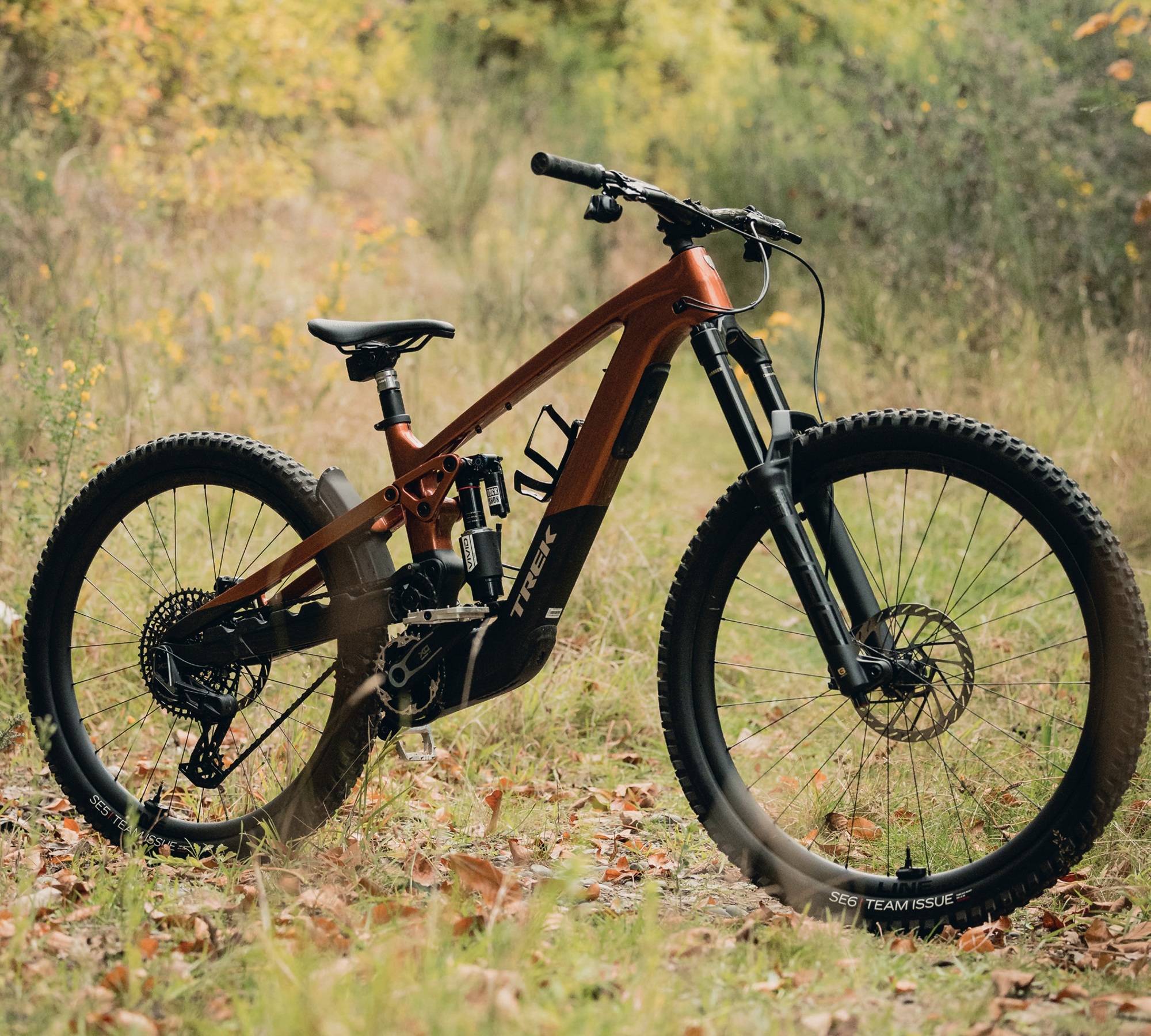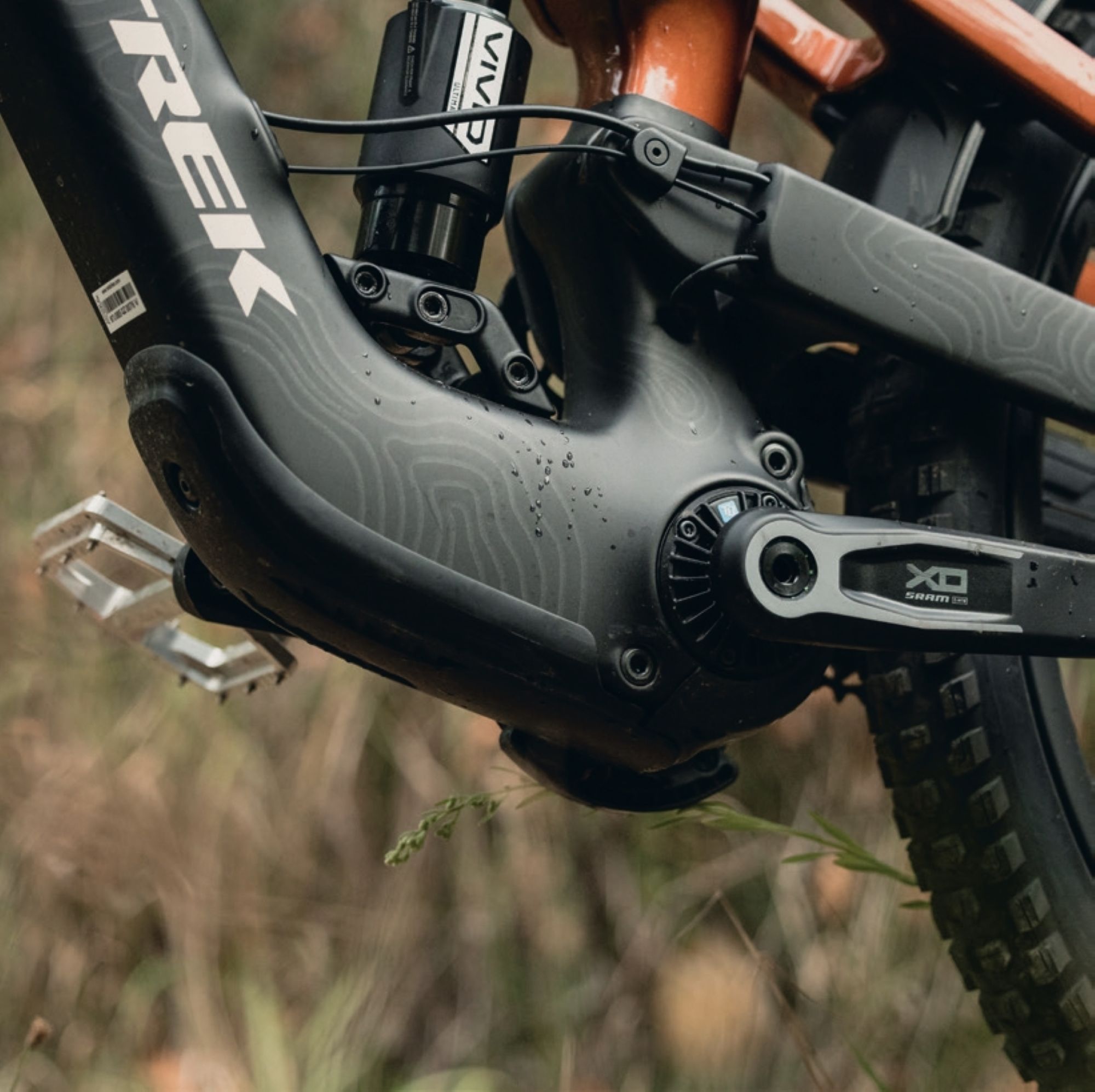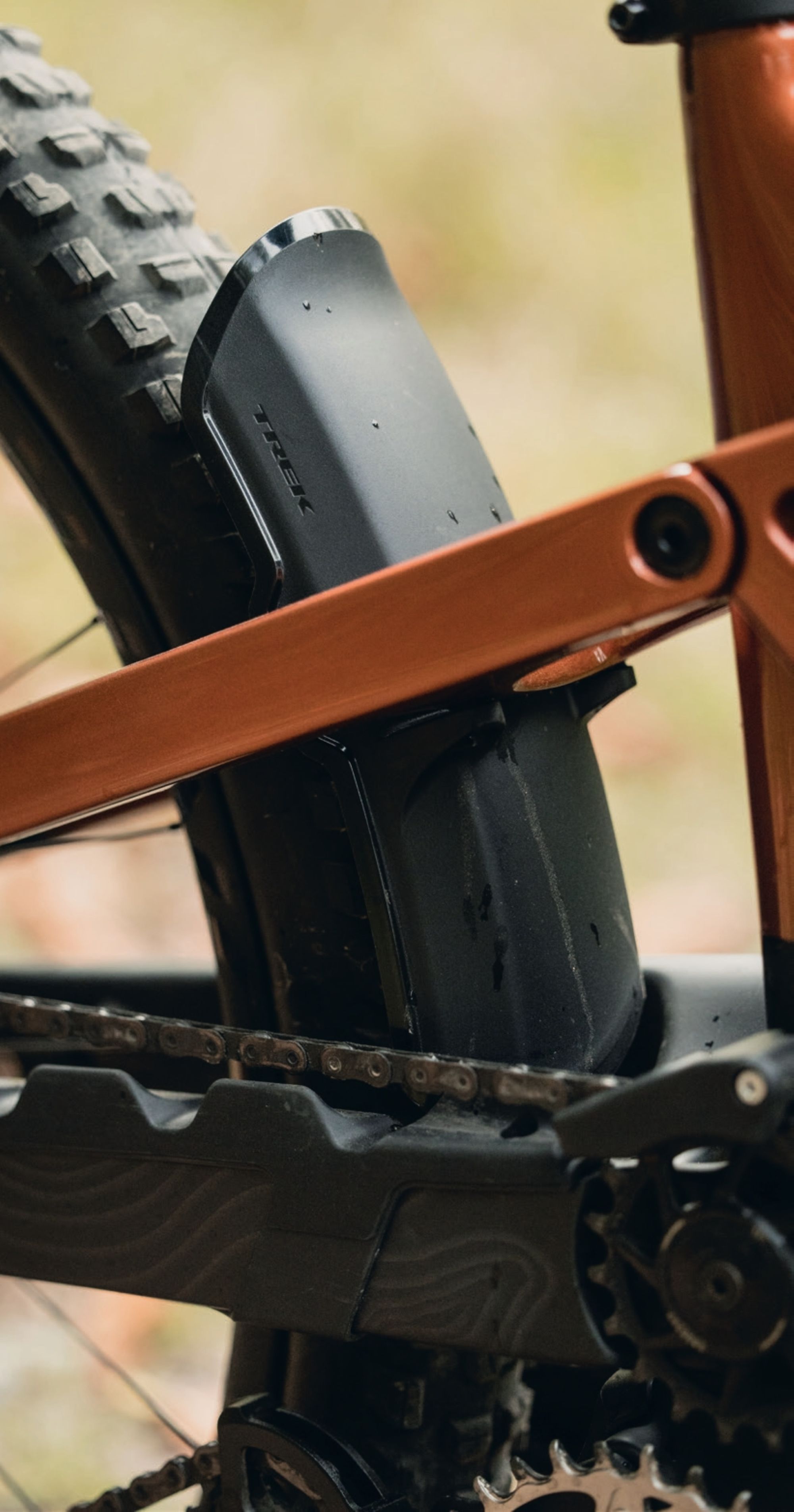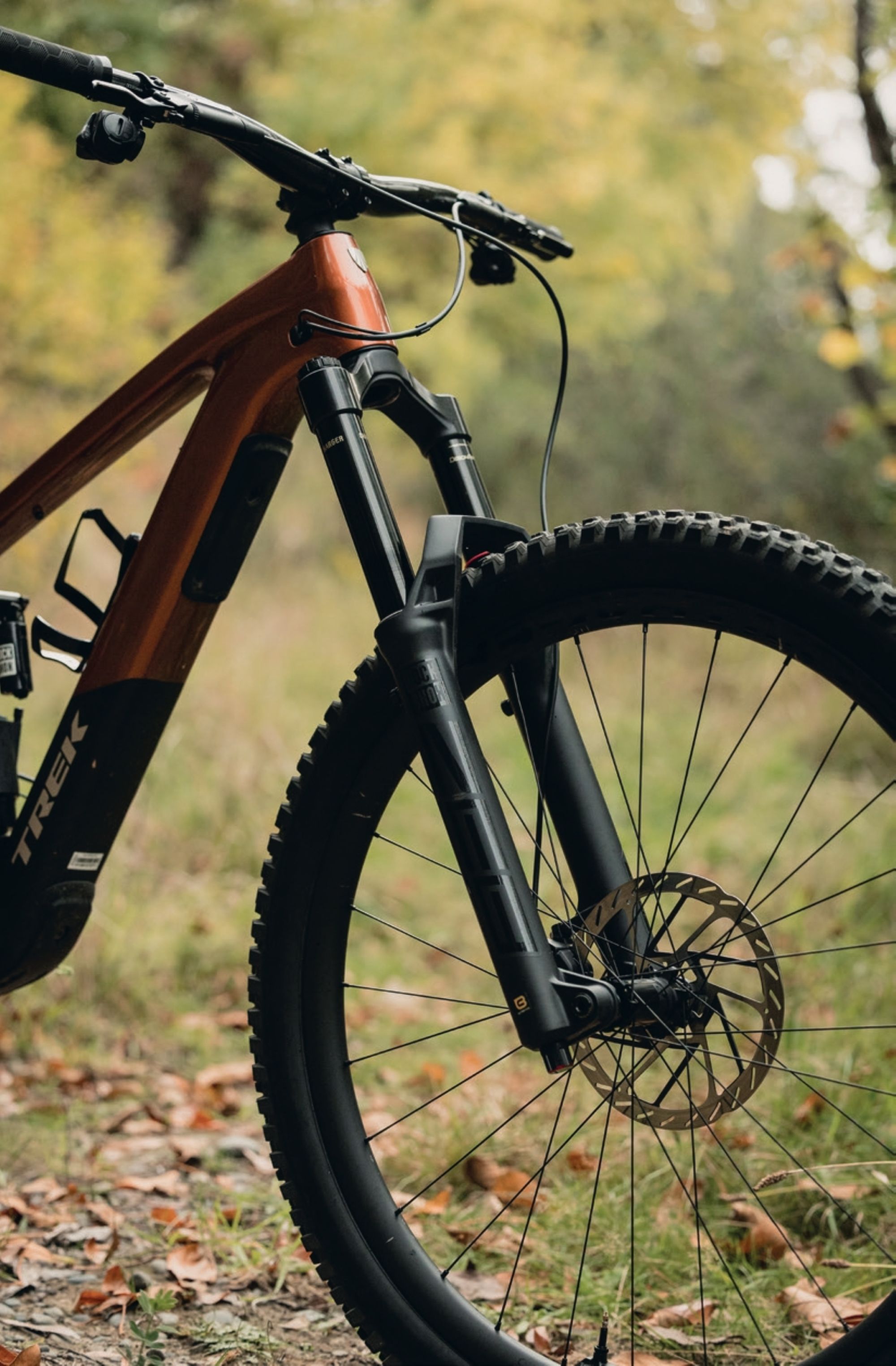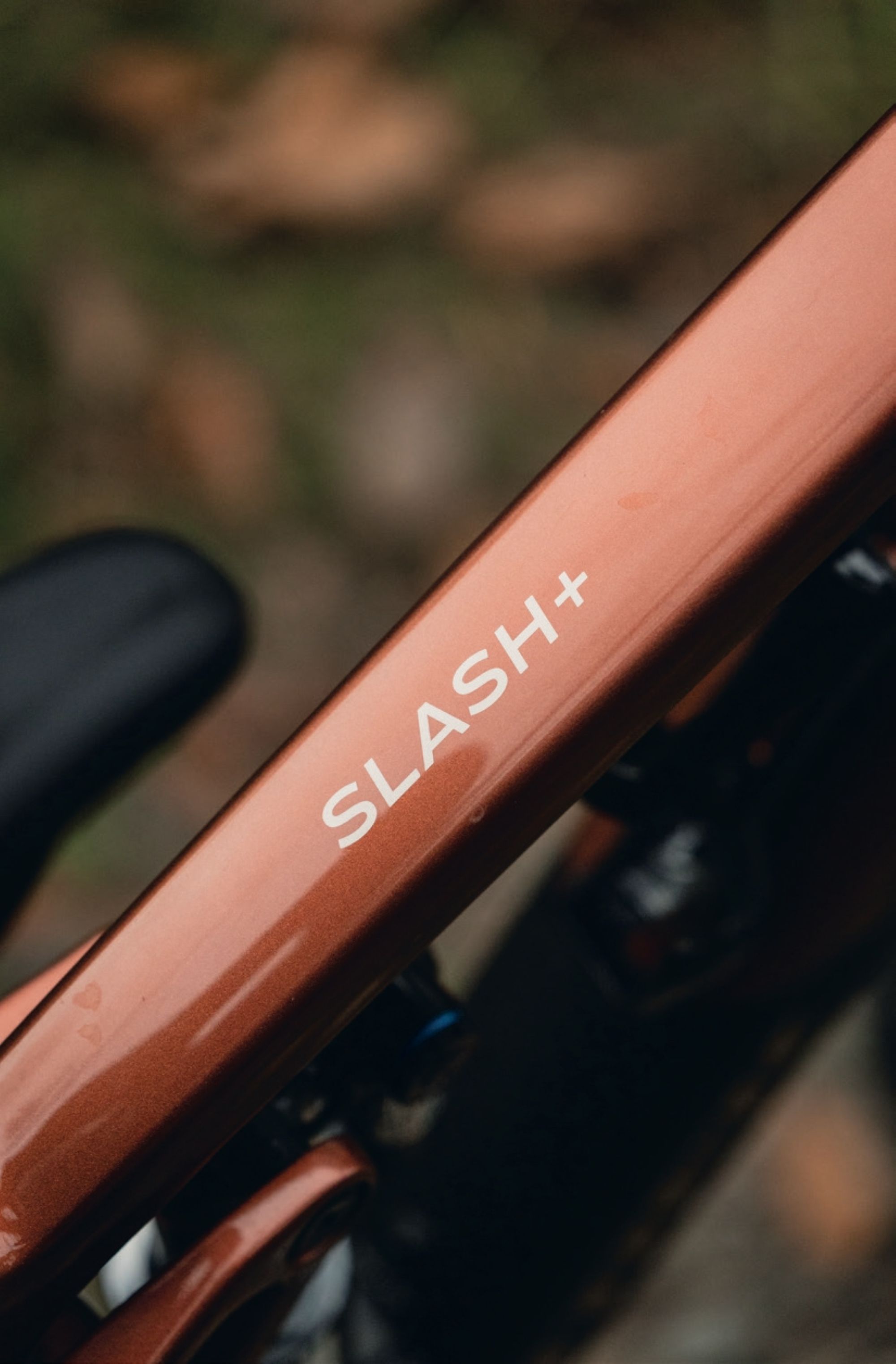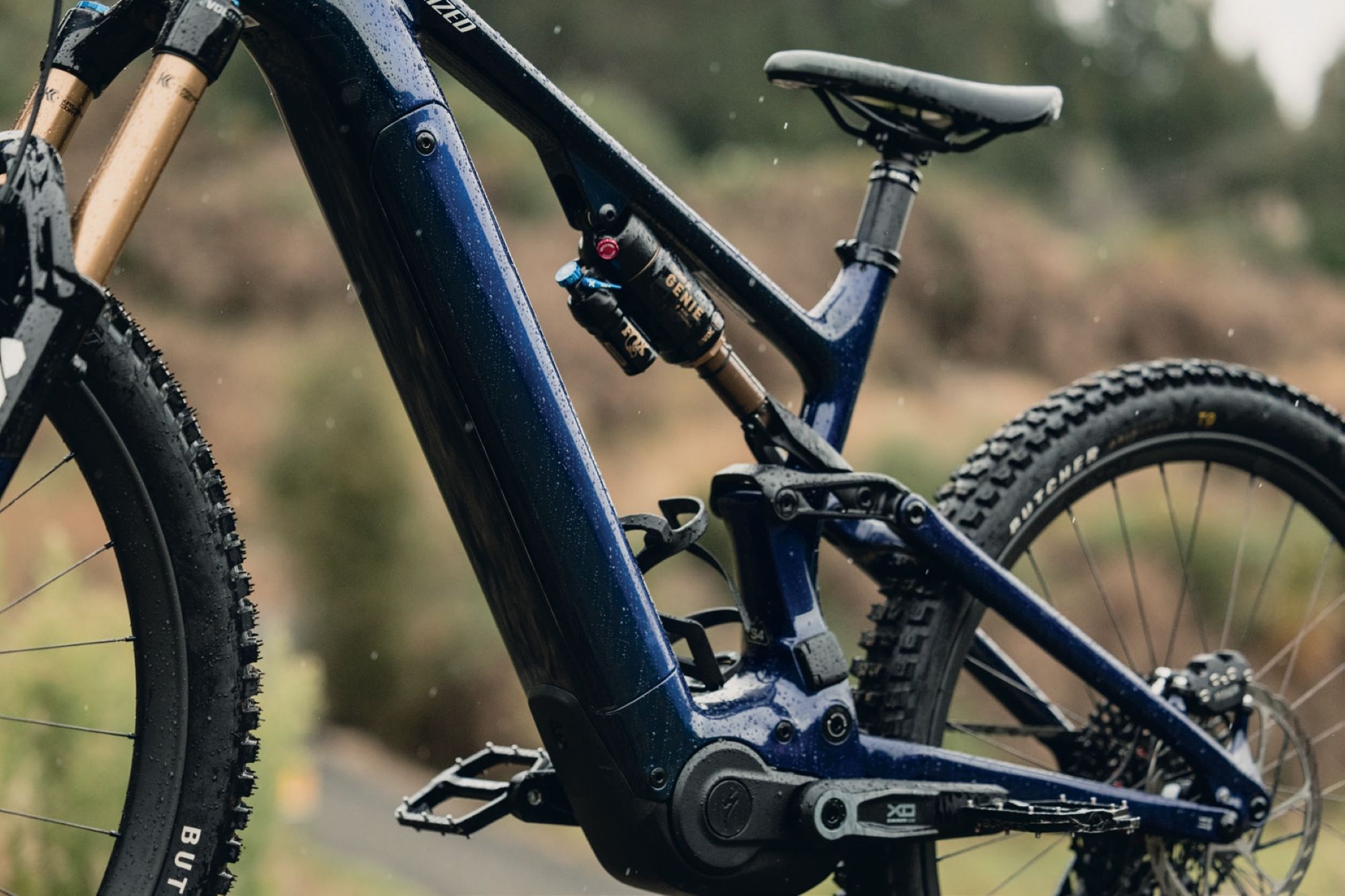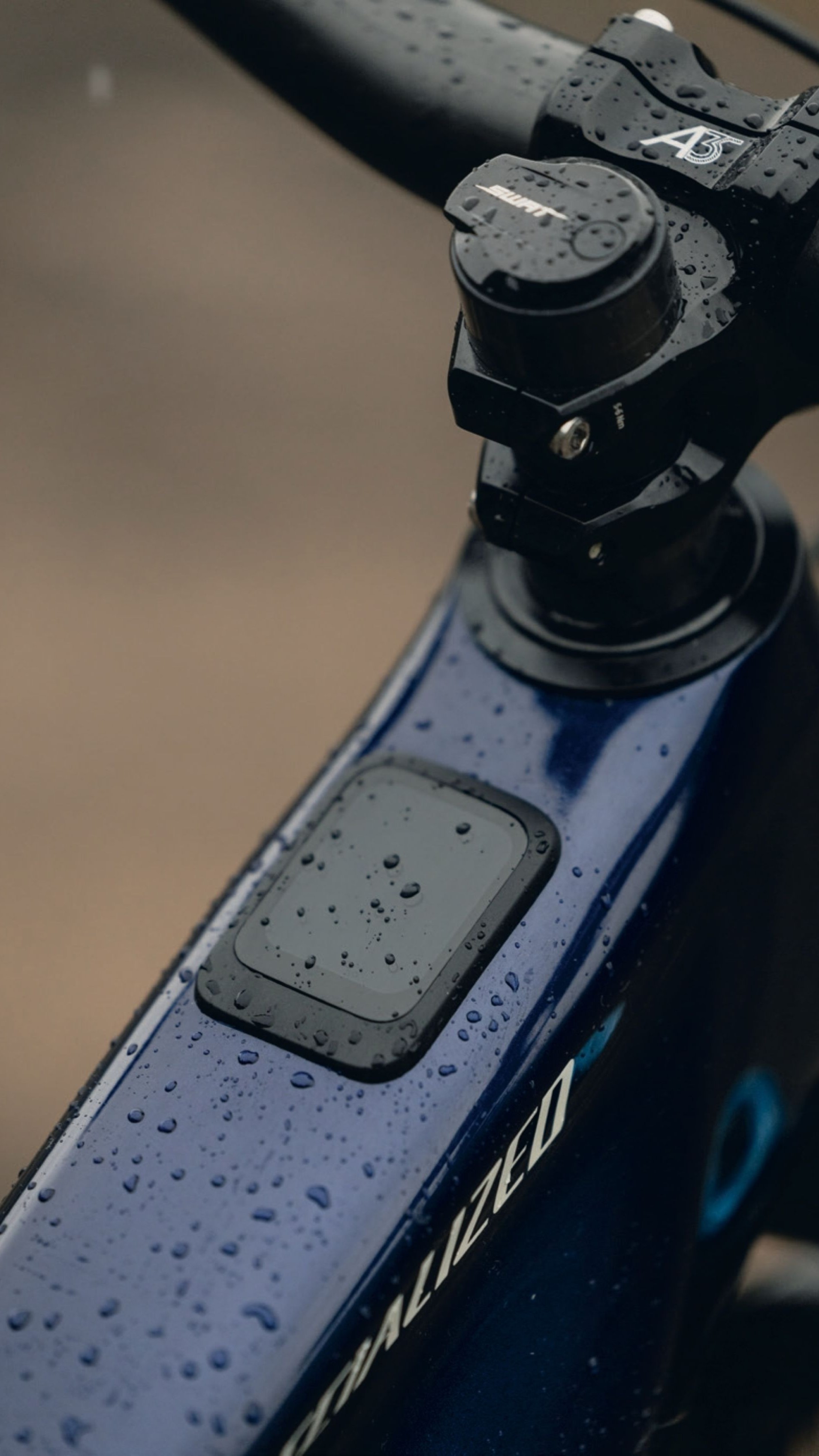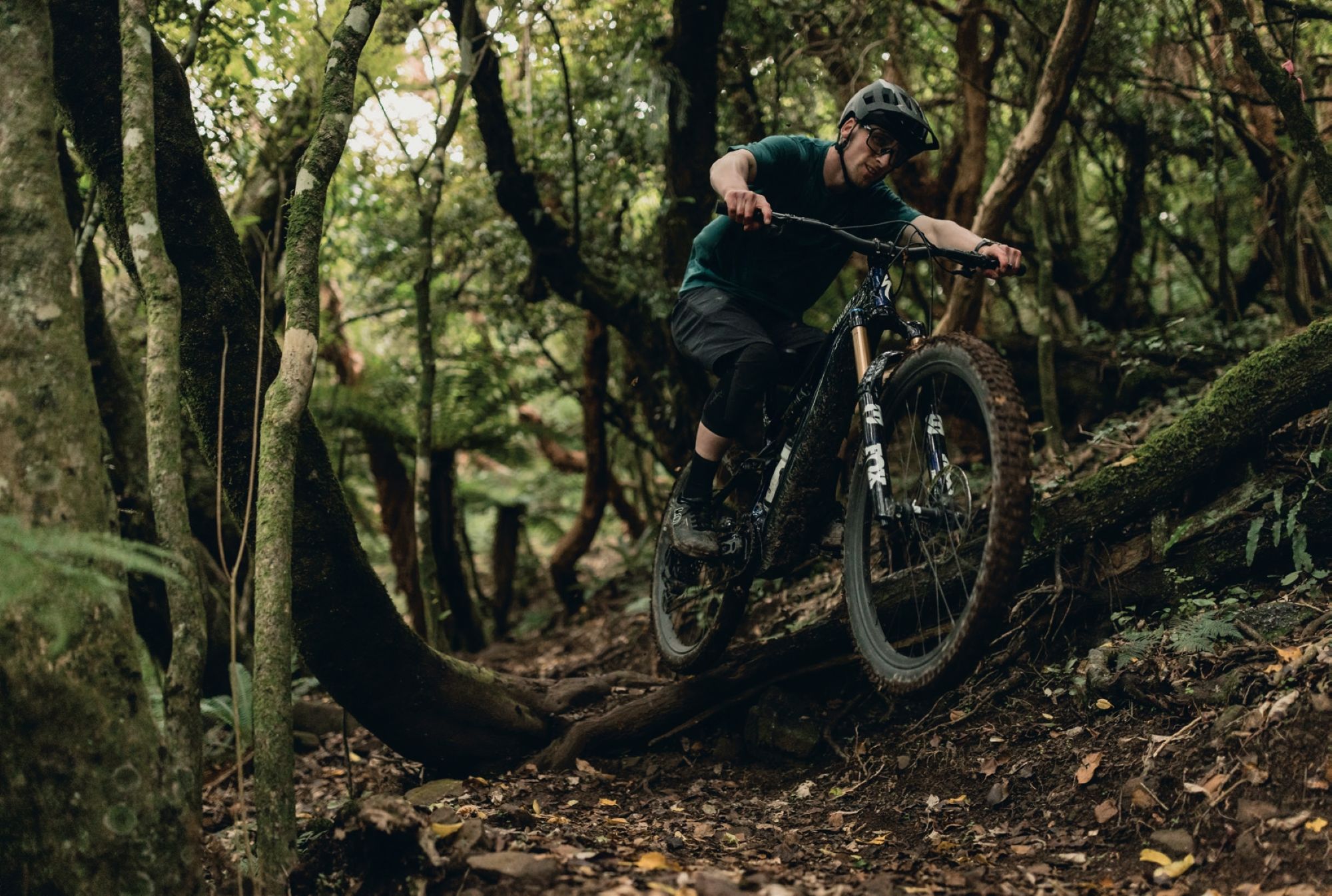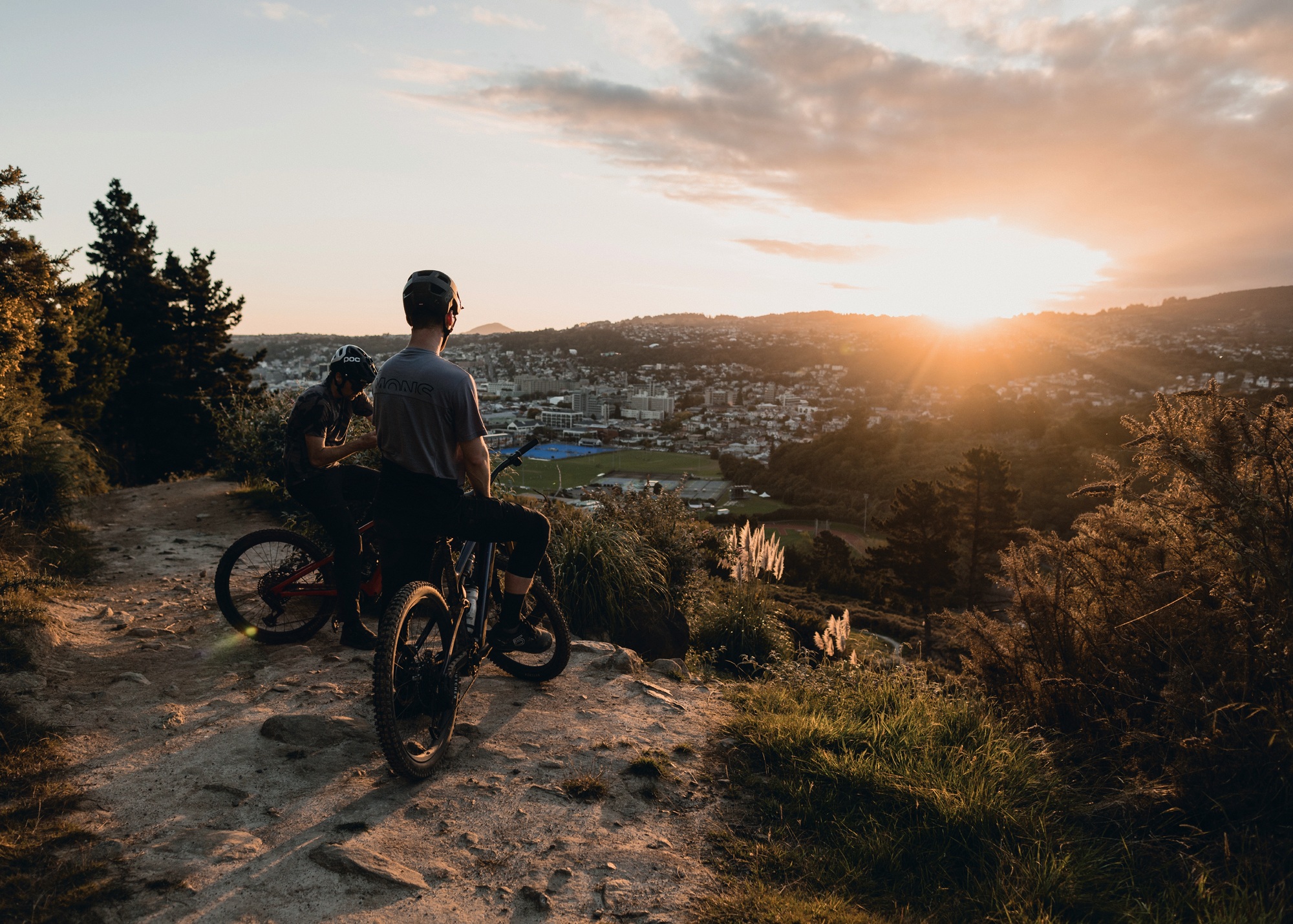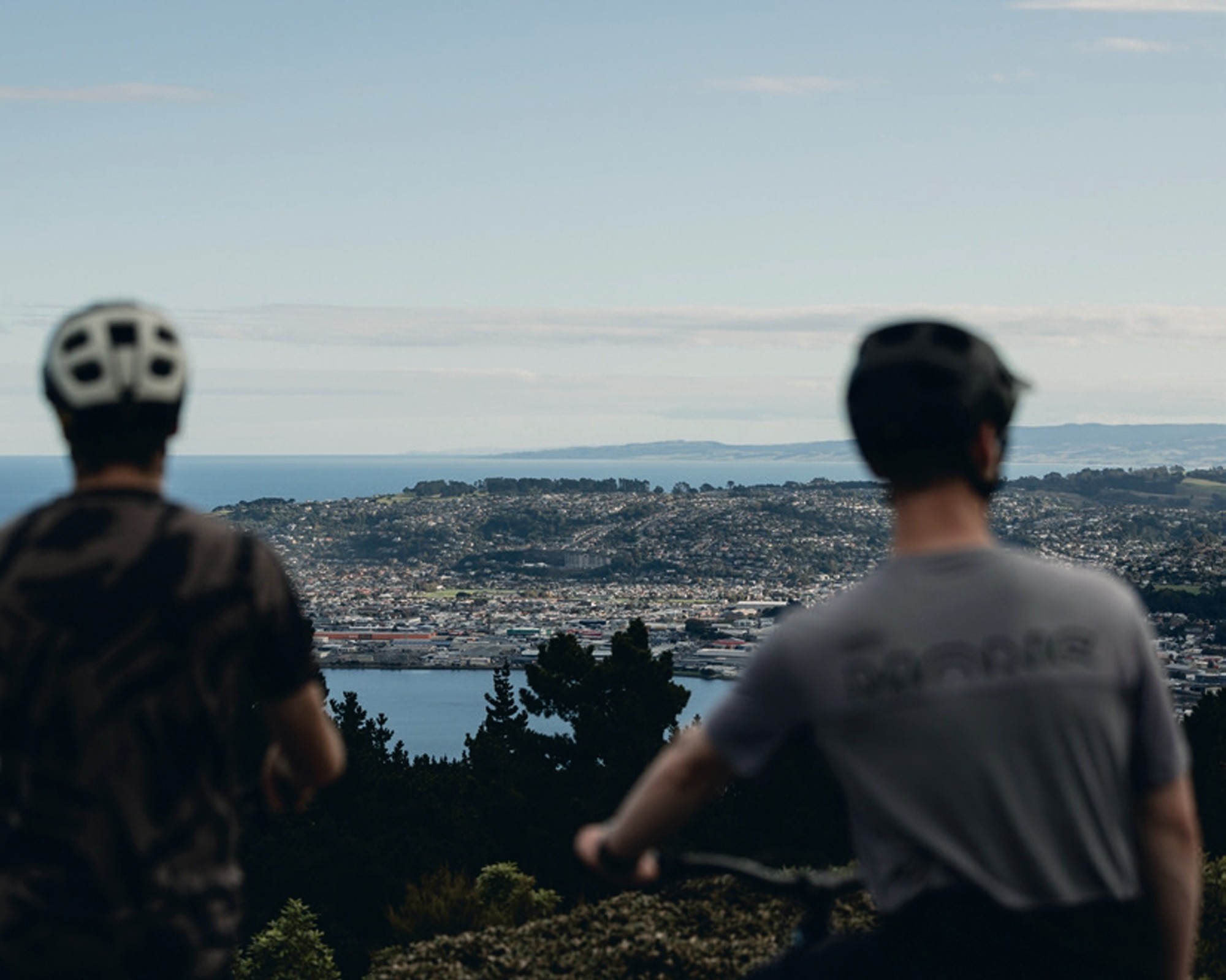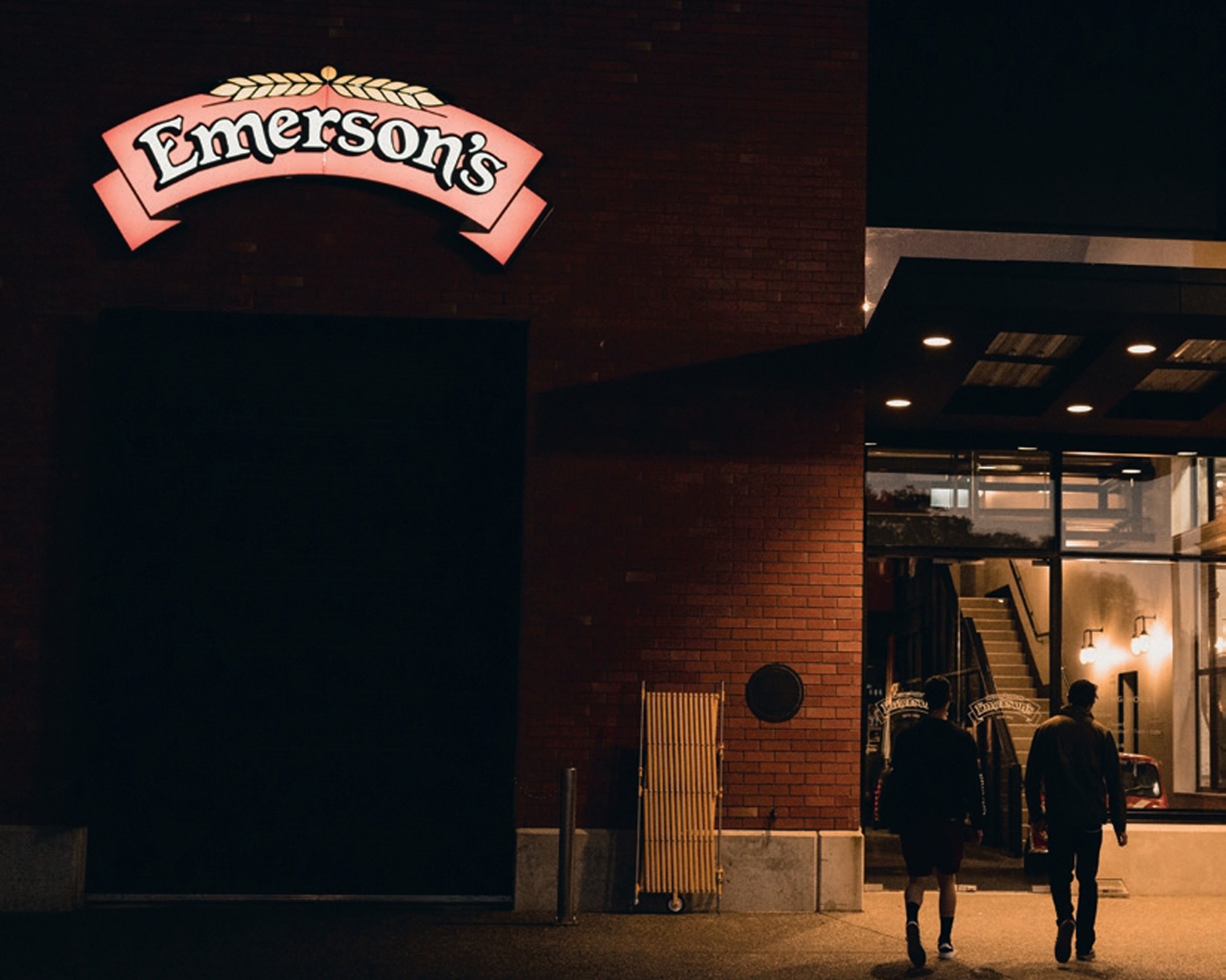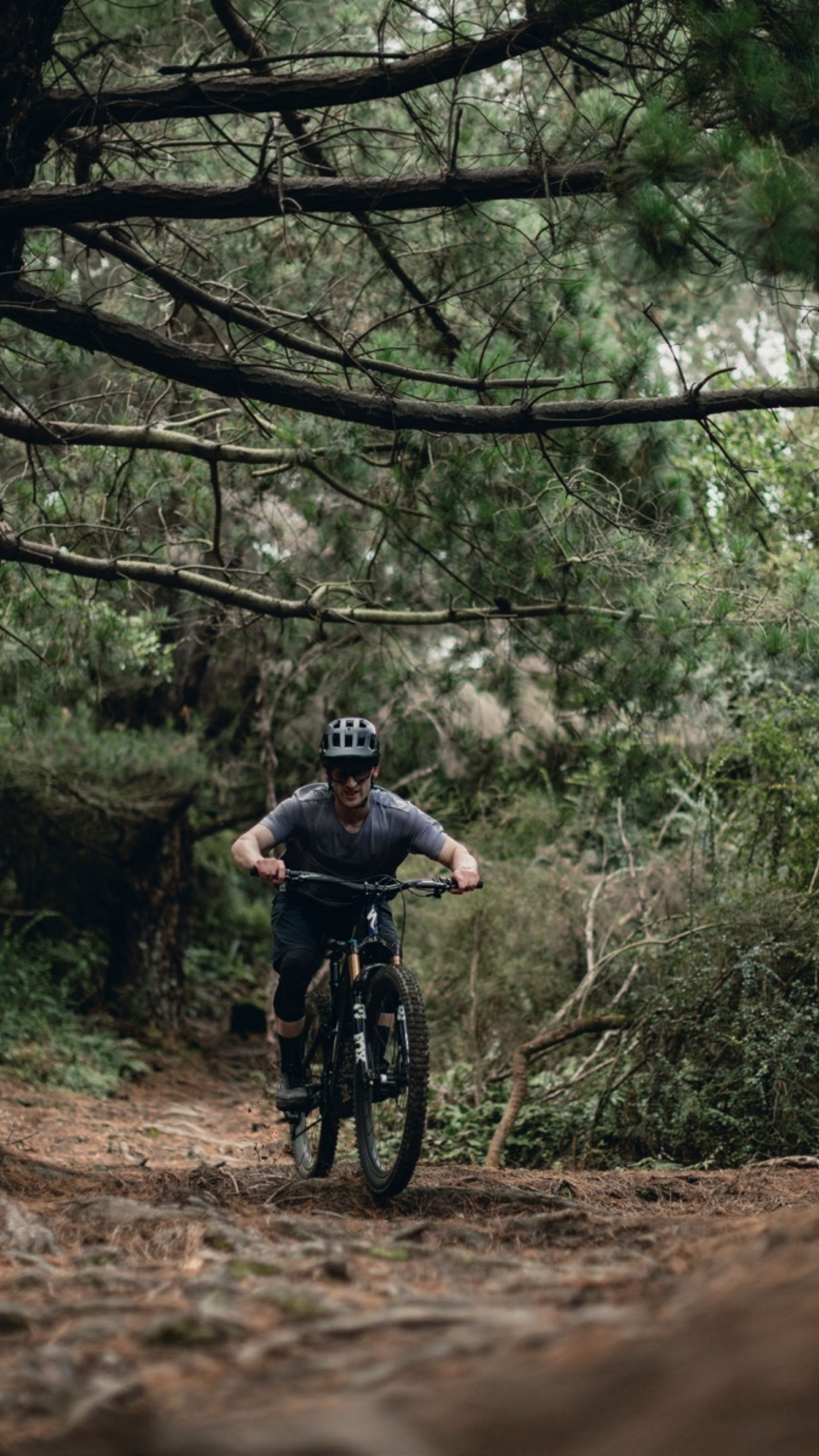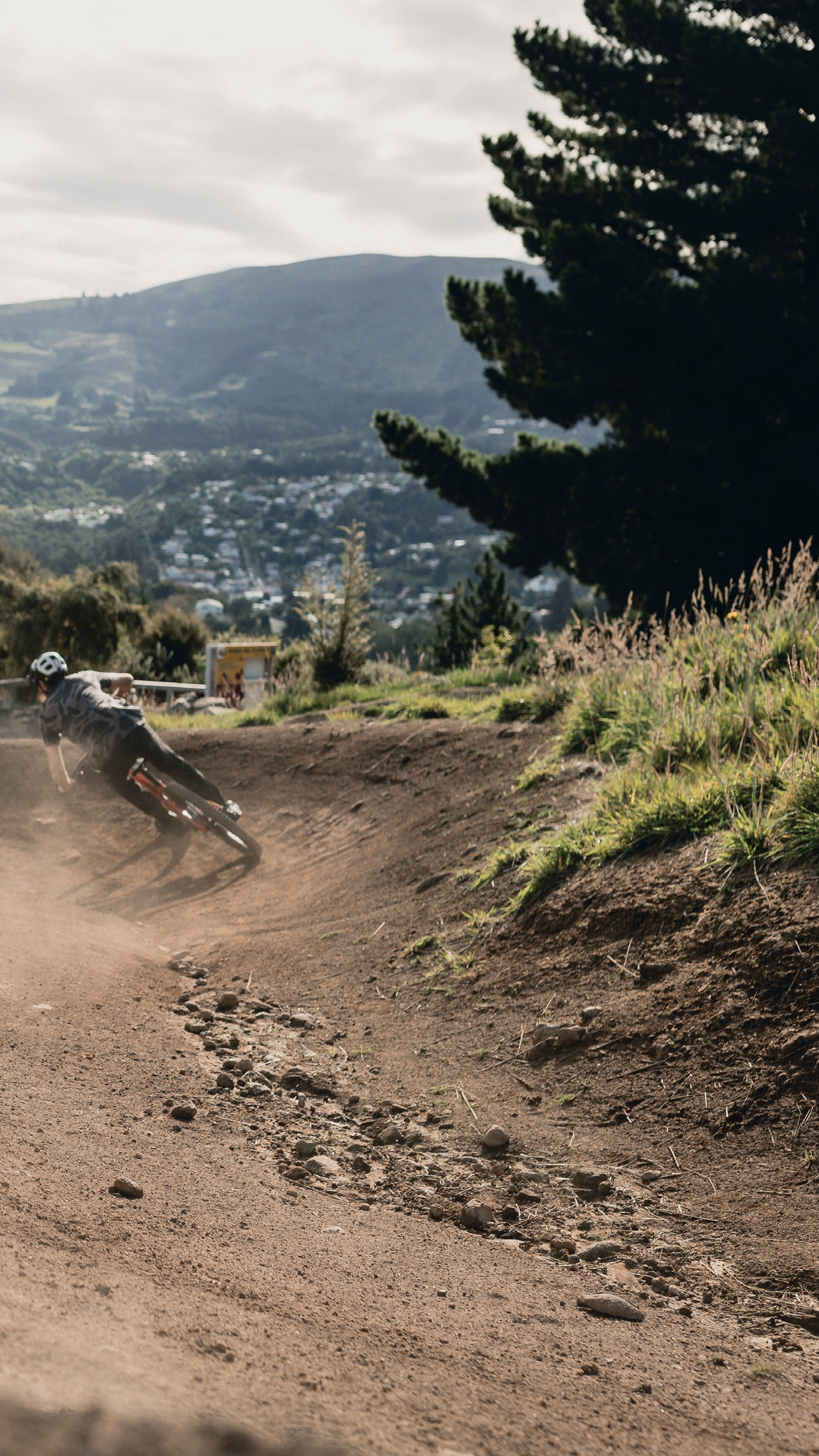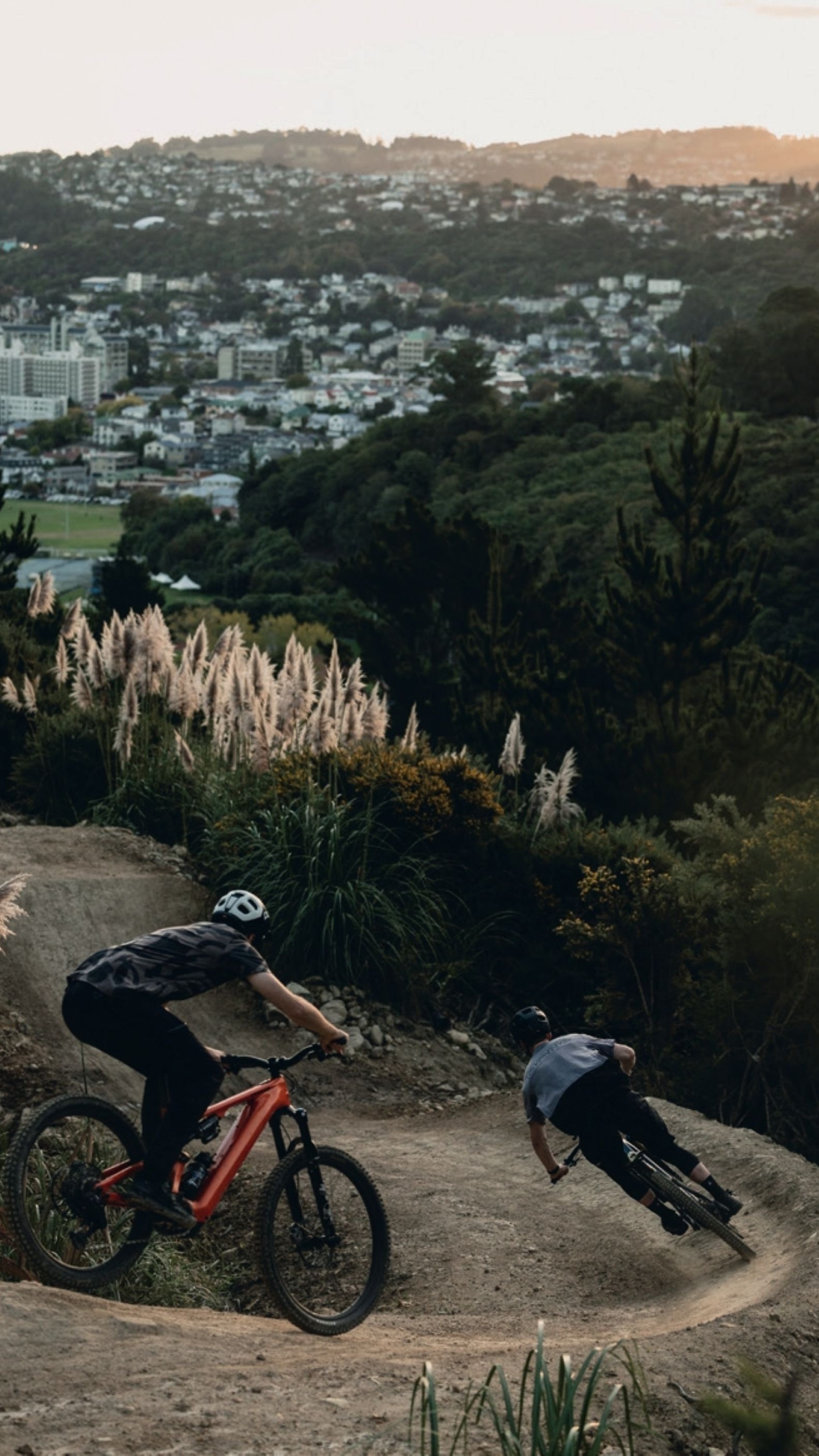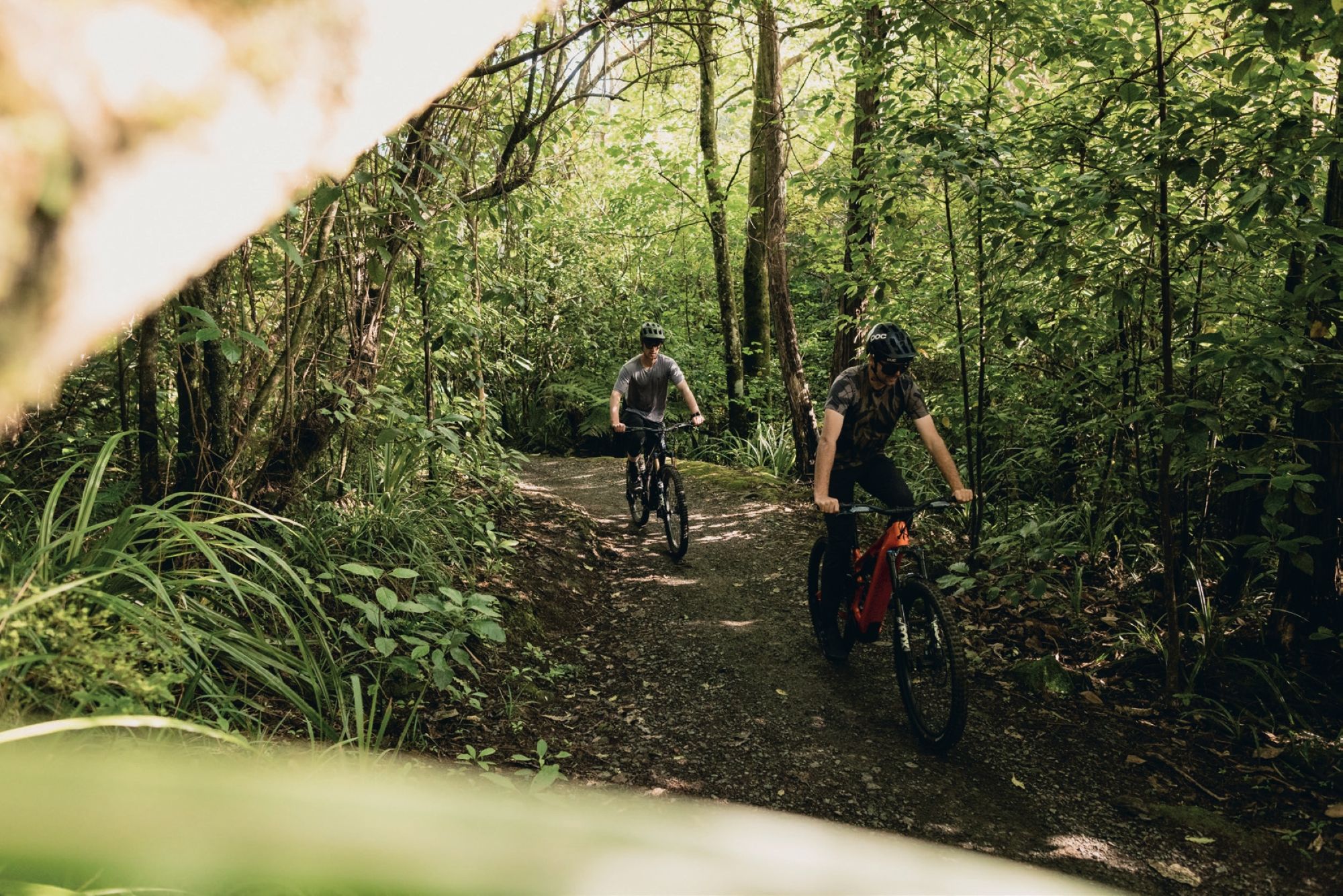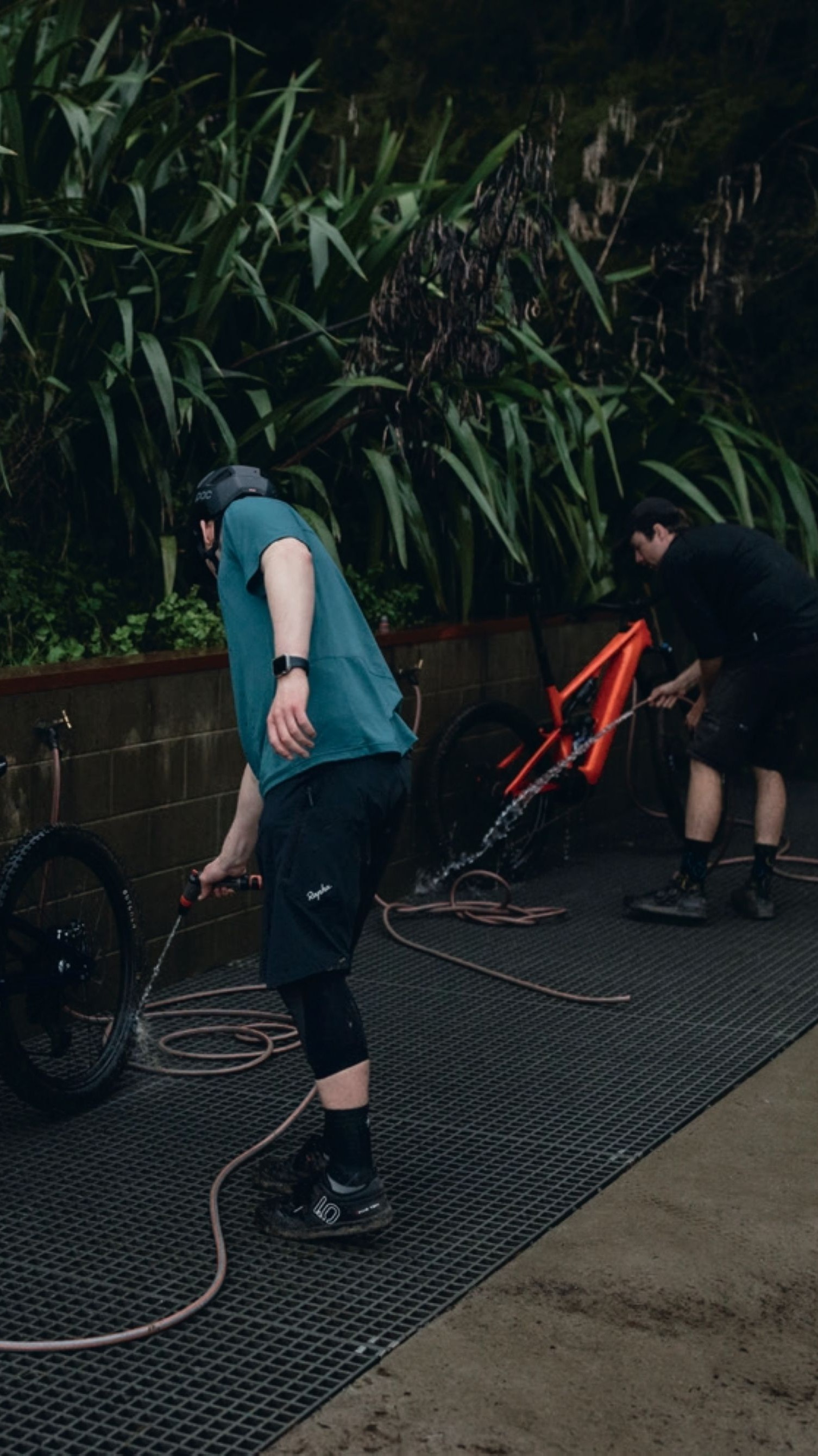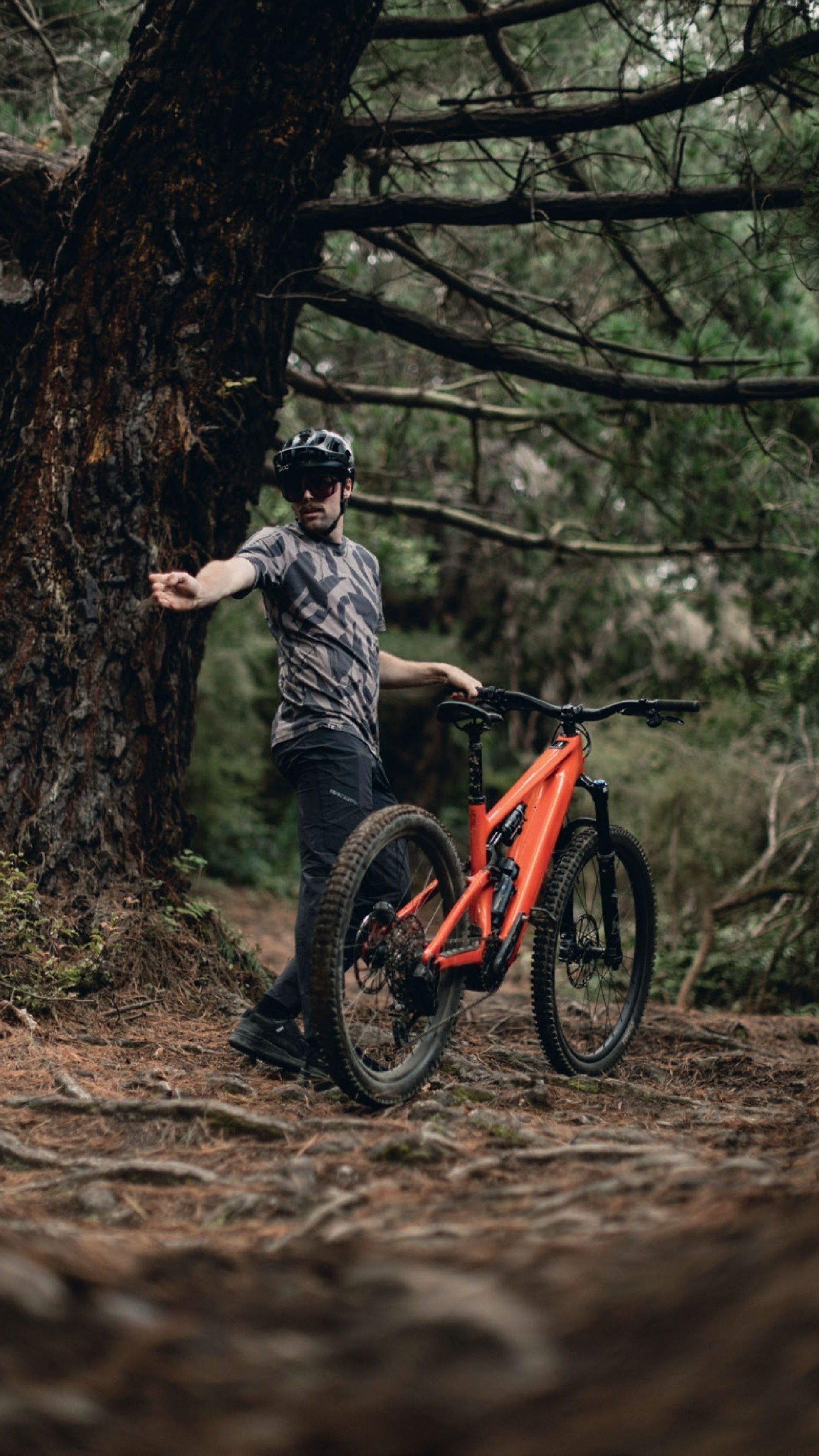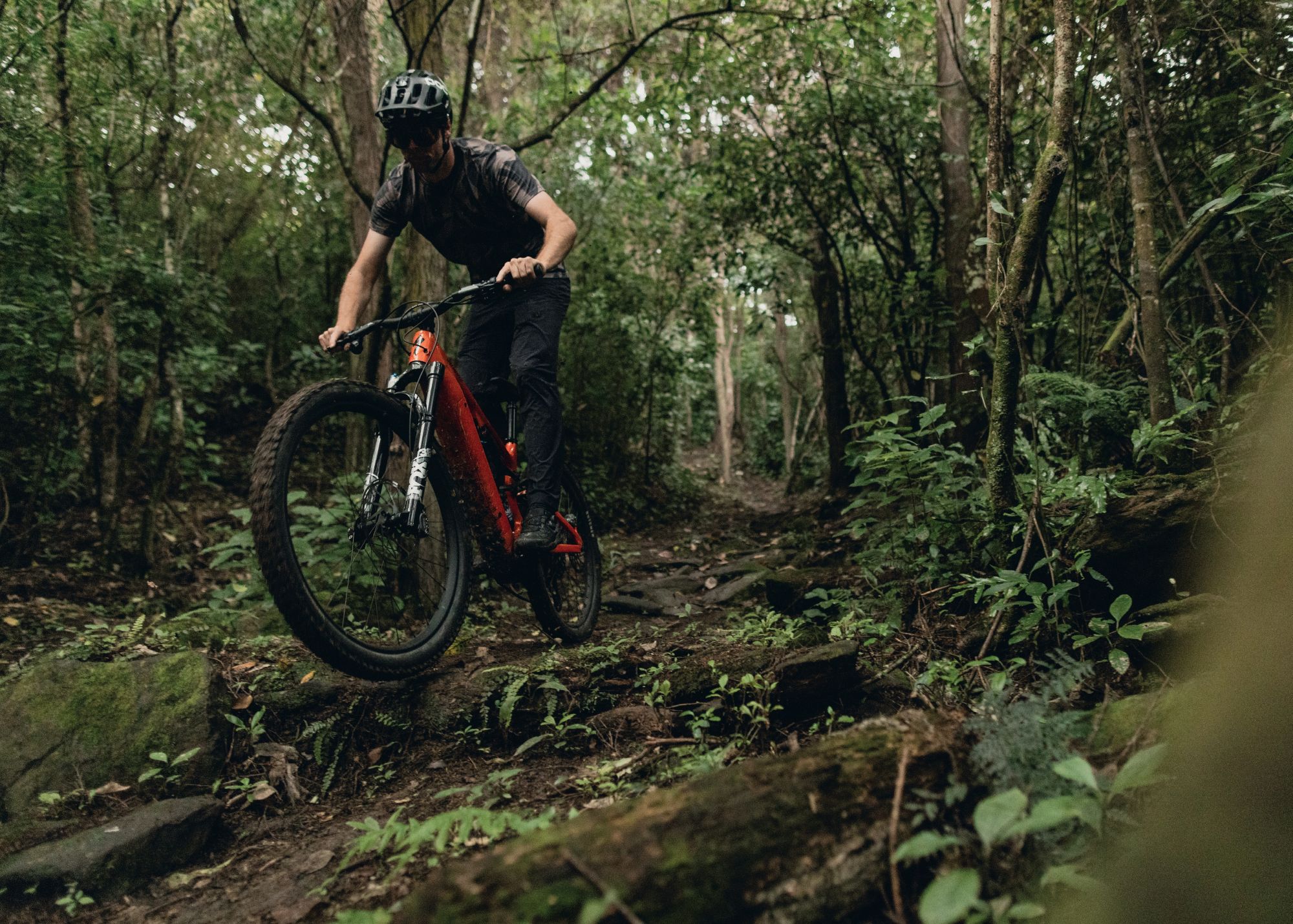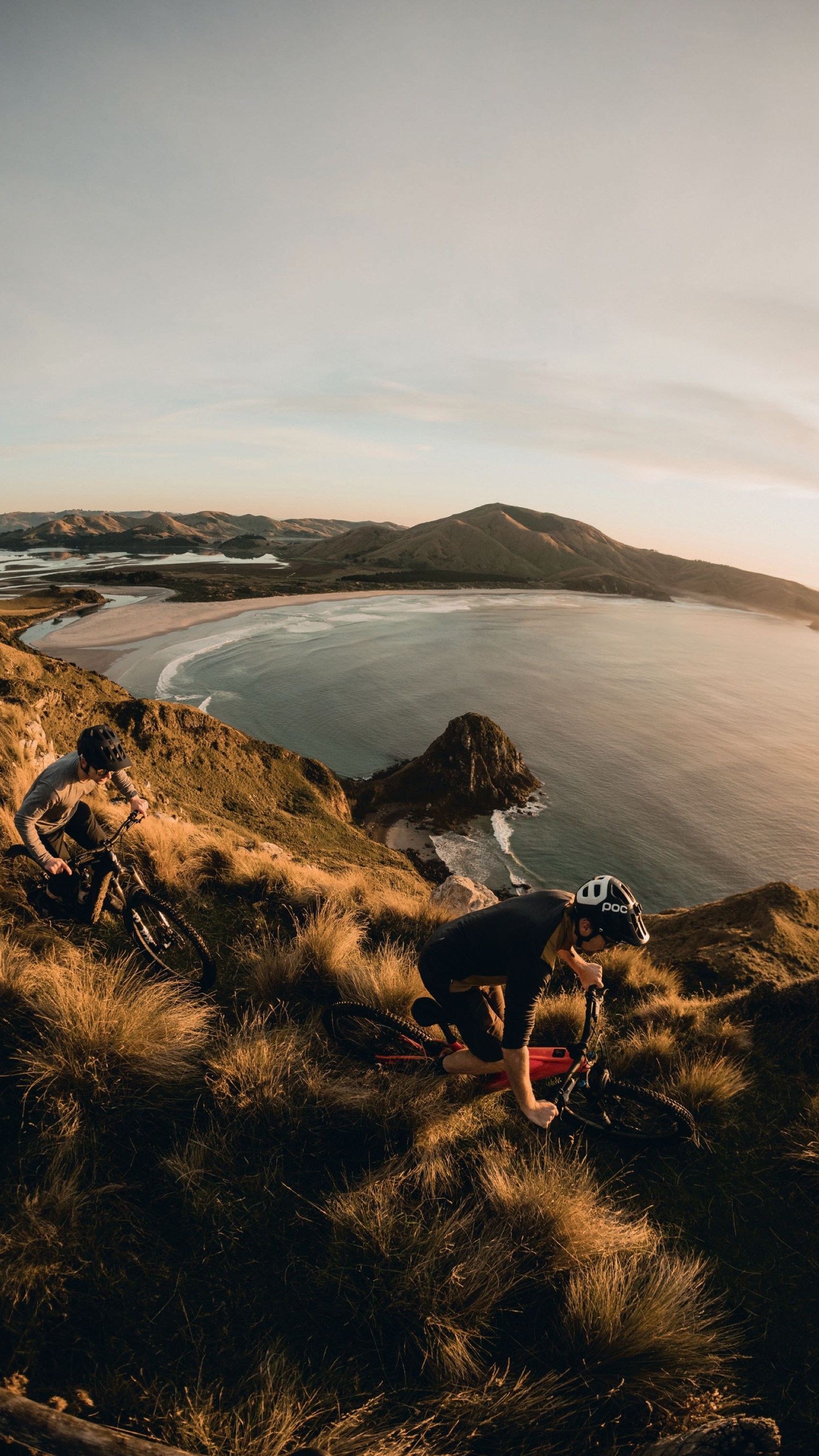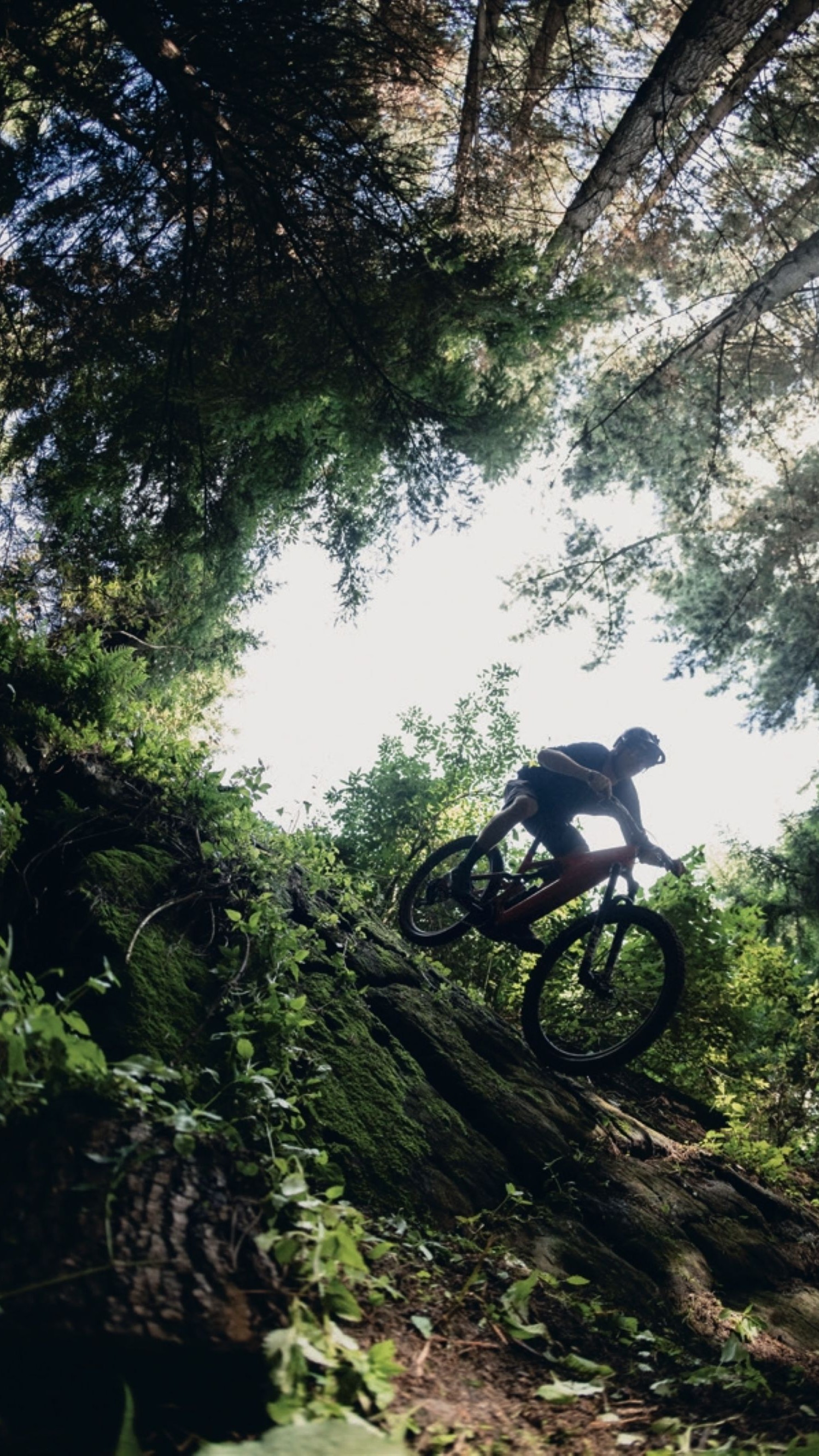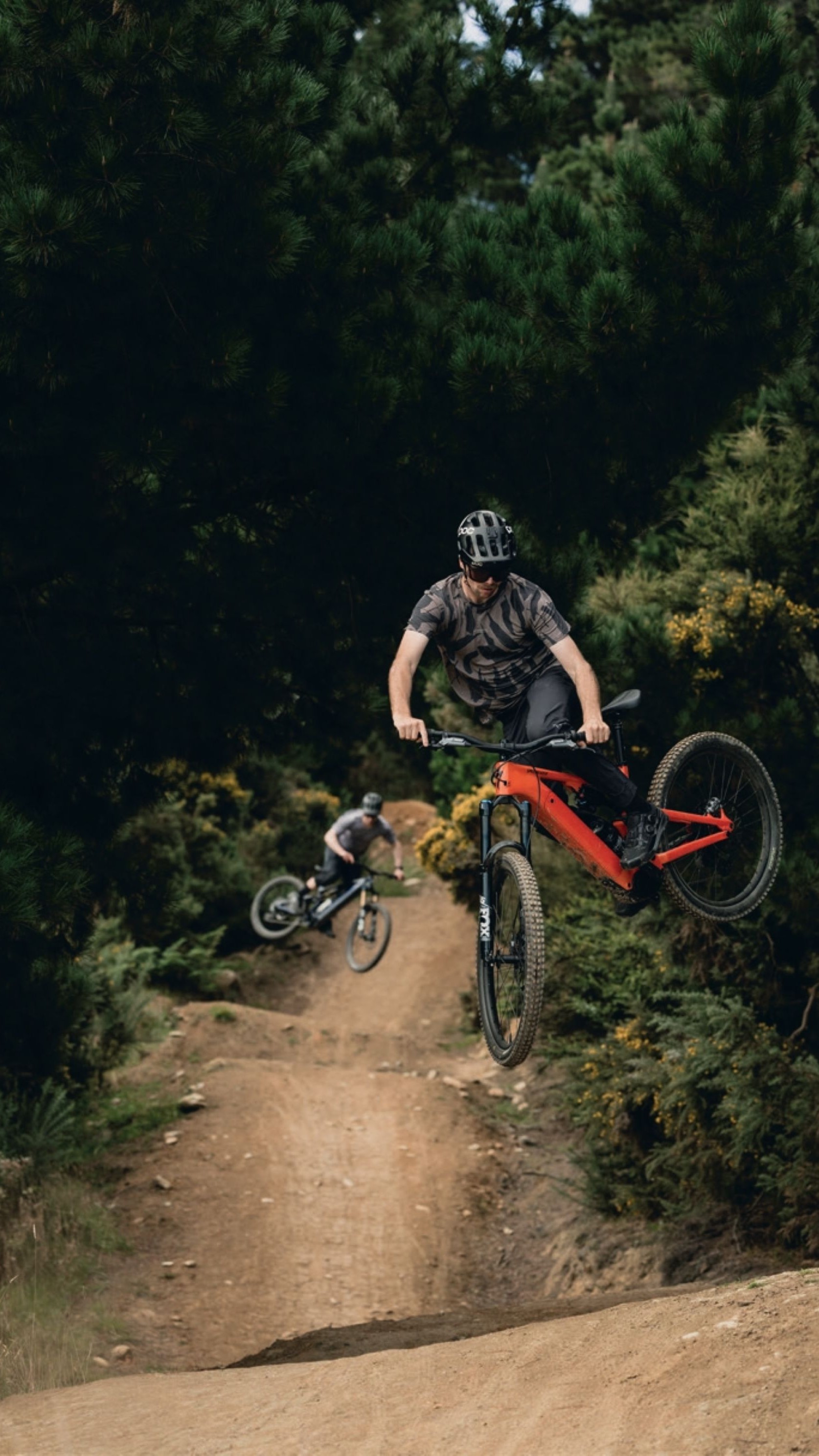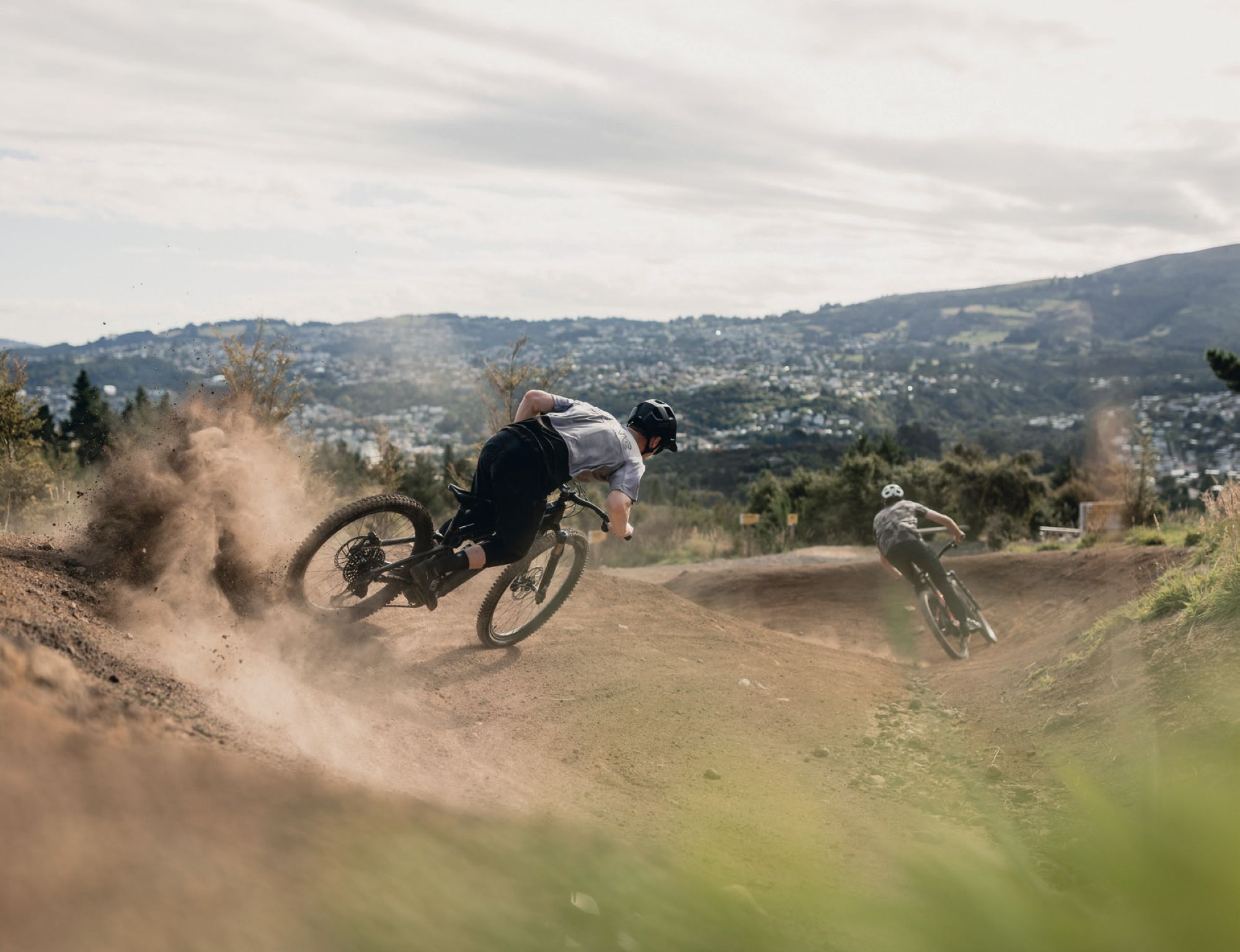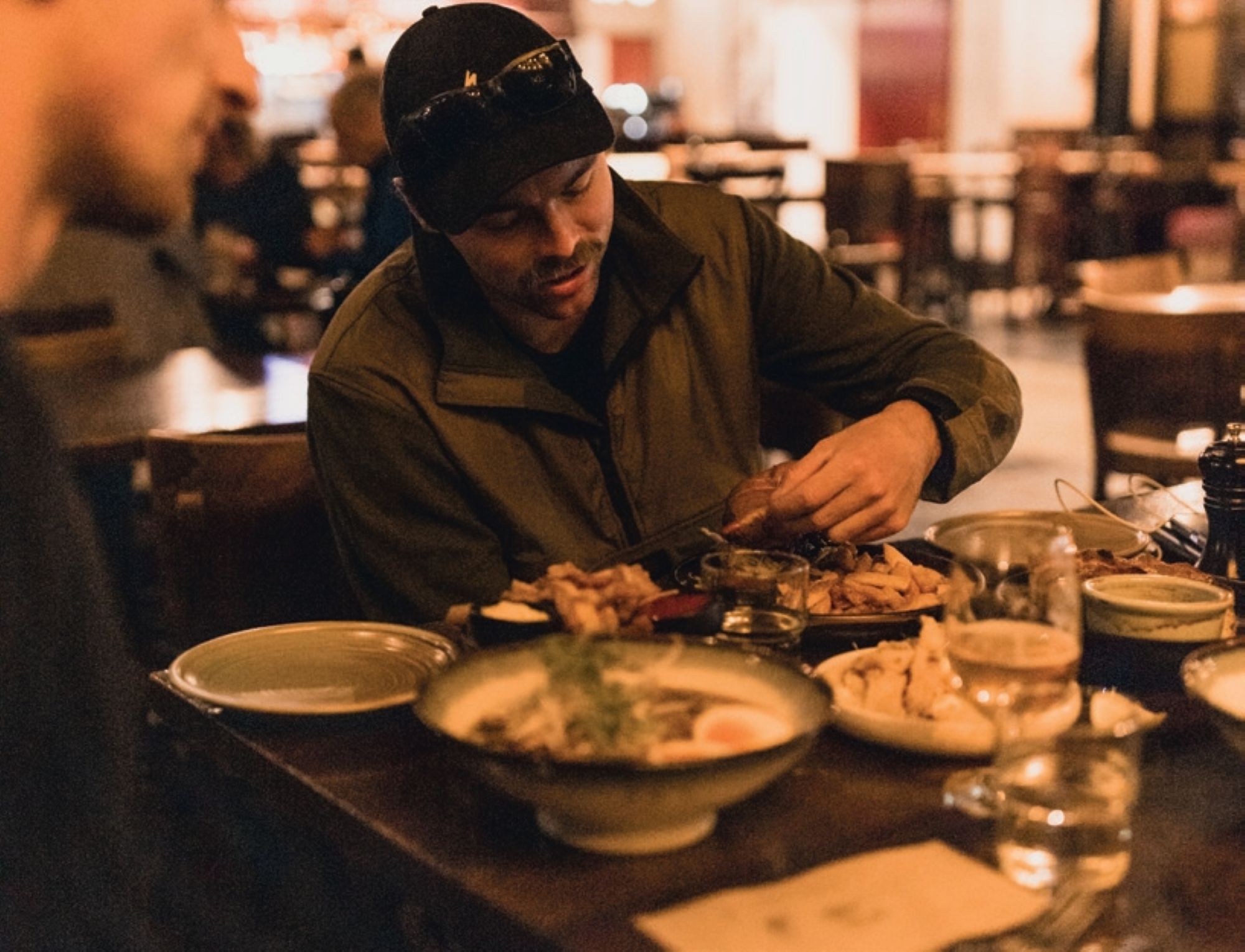Straya: Trails and tales from the Aussie Outback
Words & Images Jamie Nicoll & Anja Foley
Imagine: hot, red desert sand; endless horizons; crimson balls of sunset; hot springs; bike-length lizards; crocodiles and sea turtles cruising around the turquoise Timor Sea; flocks of green budgies; waterfalls crashing over bright orange cliffs; ancient Indigenous culture; camping under the stars–and stillness. “Castel like” serenity! This is Outback Australia. This is where our bikes have taken us.
Along with Collin the Landcruiser, we (Jamie and Anja) have returned to Australia for a second stint of overlanding adventure with the continued mission of riding in remote and unusual places.
Arriving at our friend’s place in Coffs Harbour, New South Wales, we were so excited to be reunited with Collin and rejoiced in the comforts of our all-in-one adventure vehicle—Collin had been parked at our friend’s place on the East Coast for the past six months. We immediately jumped on our bikes and headed out for a few rides at the local Saw Mill trails—a simple little park with sand-based trails. We enjoyed the nice flow and the fun log rides scattered throughout, but it was soon time to fuel up (a cool 250 litres), fill the water tank, restock our provisions and complete some maintenance before heading off. This year’s mission was to head into the Red Centre, crossing the Madigan Line, the most remote track in the Simpson Desert, before taking a northern course to Arnhem Land via Kakadu National Park just east of Darwin.
A day’s drive from the coast, we stopped at Durrigo National Park; a ride that feels like being transported back in time. We checked out the rainforest trails, sitting at roughly 1000 metres in elevation. Durrigo is known for its remnants of ancient forests that are linked back to Gondwana Land.
The Rosewood trail, a shared track, was a superb ride with its exhilarating fast flow and technical creek crossings. A speedy traversing descent on steep terrain made for high concentration, and staying wary of the numerous vines hanging across the track. We stopped so often, captured by the tall ancient trees with huge buttress roots. We climbed around waterfalls flowing down massive boulders and even jumped into the ice-cold river for a very quick morning dip.
A couple thousand kilometres later, we were at Tibooburra, a very remote outback town on the edge of the Strzelecki Desert. It is best known for its 450-million-year-old granite tors. This was a quick ride, but great to stretch our legs on the long drive. Heading up this loop track set amongst a field of ancient granite boulders, provided a mix of smooth track and very technical rock manoeuvres. It was scorching hot too and our daily cold banana smoothies were calling.
The riding was hugely spread out as we crossed the massive continent. We had already woven our way across the Strzelecki and Stuart Deserts using the abandoned Walkers Crossing to get us near to Birdsville, the edge of the next big nothing. As we wanted to explore more of the outback, we now had the huge Simpson Desert to cross to get to our next riding destination: Alice Springs.
The Madigan Line, our most direct route, also meant a lot of sand and over 1,100 dunes to scramble up. Red sand flew as the low-pressure tyres searched for traction, with low-range gears in full use and the right foot deeply engaged. Bouncing around for hours, and then arriving at camp, there is nothing quite like the stillness, the crimson sunsets and sunrises, and sleeping around campfires under the stars.
Pulling into Alice was a chance to restock and do maintenance after the extremely rugged outback crossing. It is one rough crossing that’s for sure, with uncountable bottom outs on our new and raised suspension and heavy corrugations battering everything for hours on end. Our mountain bike community was right there behind us, and we were able to use addresses to receive parts with others welding up cracked bike racks and providing us with a camp spot and hot showers. One of them, Chris, has been the most excellent man to know. He rang up and offered to show us around a new trail network while we were there.
Some 30km of trail, all built by one man, Mark’s network sits near Owen Springs, southwest of Alice. Many Alice Springs riders haven’t even heard about these trails, let alone ridden them. They’re well suited for eBikes as the additional speed creates a lot of fun on less gravity- orientated sections. Rocketing along on flat sections, and weaving our way through narrow stands of trees, we followed dry river beds up and down rocky outcrops, and long spinifex grass, constantly careful of tyre placements on the many abrasive slab rock sections.
Darwin sits on the coast, 1500km directly north of Alice. East of Darwin is a traditional Aboriginal area called Arnhem Land. On this route north, just outside of Katherine, we pulled into Nitmiluk NP – the bike trails here are built on the escarpments, high above the Katherine Gorge. The tracks weave between boulder fields and over playful slab rock sections, leaving us smiling, with descriptive chatter flowing. To finish, we dived into the sparkling thermal steam in town, leaving us stoked and refreshed. And, if that wasn’t enough, our new friend Andrew, the local MTB club president, turned out to be an ex-crocodile hunter who back in the day would jump on the backs of up to eight-foot-long saltwater crocs and bring them up to a boat for scientific research tagging. He regaled us with stories of his youth, diving—yes, diving not jumping—from 200-foot (61m) towers into the sea at Port Darwin, and even his time on the set of Crocodile Dundee. Being an ex-park ranger with excellent storytelling skills, Andrew is a walking encyclopaedia for all things nature-related. He was so entertaining that his stories distracted us on even the longest climbs.
Arnhem land and the Cobourg Peninsular, as a riding destination, are not mentioned anywhere that we found, so we thought it sounded like a great start. Once again, this meant filling the full 250 litres of diesel to make the distance there and back on these remote roads.
Arnhem Land has been an Aboriginal stronghold for over 65,000 years. British colonizers struggled to create a lasting presence here due to the extreme tropical conditions, leaving the indigenous population and their way of living comparatively undisturbed. Aboriginal elder of the area clan, Violet Smith, quotes; “Long ago we Jawoyn lived here. The old people have passed on. It’s okay for you to go around here. You stay maybe two nights, then you go back to your country”.
Our efforts to get the correct permits would test even the most tenacious administrator. Getting into Arnhem Land from the west means traversing the Kakadu National Park with its stunning rock gorges and deep plunge pools. Even the accepted swimming spots are somewhat “at your own risk” as from time to time a saltwater croc has made its way into these pools undetected, avoiding the purpose-built traps and monitoring. Oh, but these pools are so delightfully refreshing—we were now well into the 40-degree zone with high humidity which makes any type of exercise, including a leisurely bike ride, feel like a workout.
The border to Arnhem Land is via the famous ford at Cahills Crossing on the East Alligator River, most famous for its large saltwater crocs swimming around on either side of the vehicle—as you can imagine, it is not a place to get stuck that’s for sure. We counted 12 crocs in the water around us as we drove across the river, all waiting for the fish to come over the rocks with the tidal shift. From our camp, there was a sweet 40km bike ride around Smith Point, the northern tip of Garig Gunak Barlu National Park on the Cobourg Peninsula. With the vastness of the Timor Sea in the background, Olive Ridley sea turtles coming on shore to lay their eggs, and an epic UNESCO wetland, the ride became a well-rounded experience.
After an epic trip through the most remote parts of Australia, Jamie and Anja are planning on shipping Collin over to South Korea, to access Russia, Mongolia, and many of the Stans, en route to Europe. Stay tuned for more adventures.
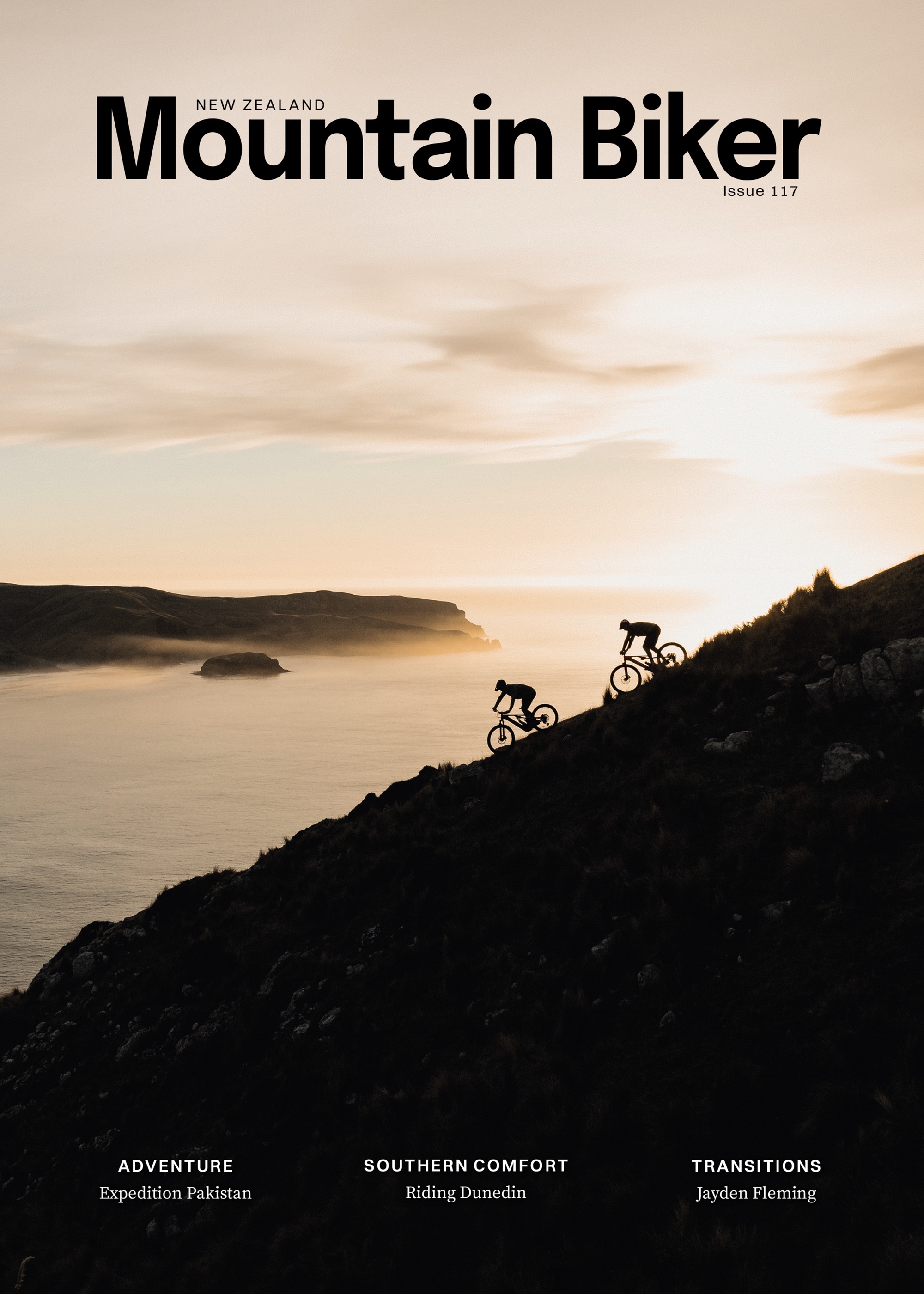
Leaders of the New School
Words & Images Riley McLay
New Zealand has recently experienced a golden age of downhill racers, putting our small country on the map as a powerhouse of talent. Originally, it was riders like Brook Macdonald, Sam Blenkinsop and Wyn Masters who stood out for their raw speed mixed with a relaxed outlook on racing, creating an international reputation that showcased the spirit of New Zealand’s mountain biking culture.
The torch was then passed to the VANZACS, where the talent pool increased with the likes of Eddie Masters, George Brannigan and Matt Walker redefining what was required to find racing success. This was the era of incorporating the DIY mentality of getting the job done by any means necessary with a lifestyle-based approach to building their careers. While both cohorts of talent found success at the World Cup level, New Zealand has since experienced a noticeable gap in racers transitioning from juniors to elite success. Now, however, New Zealand is home to an influx of junior talent already making waves globally.
Aotearoa has always had a strong racing scene at the grassroots level, but breaking onto the international stage comes with significant challenges. Kiwi racers have consistently faced two major barriers to competing internationally. One being the fact that, as you can imagine, chasing the World Cup circuit isn’t cheap; and two, our geographical isolation, making travel something of an ordeal. With the sport largely based in Europe, traveling back and forth from New Zealand isn’t practical for most people. Instead, riders must base themselves there for most of the season, which can be three to four months. The financial burden is high even before racing begins, not to mention when you factor in race fees, insurance, spare parts and essential nutrition. The mental strain of just getting to races isn’t ideal when a racer is chasing good results. This is why external funding and sponsorships are so crucial for success.
As the sport becomes more professional, privateers are increasingly being pushed out of competition. This makes securing a spot on a factory team more important than ever. Recent UCI rule changes have made it even harder for privateers to qualify for a World Cup, so riders must now earn UCI points through a new feeder series called the Continental Cup. Finishing in the top five of any Continental Cup Series grants access to the next World Cup on the calendar. Alternatively, winning their country’s National or Continental Championship guarantees automatic entry for the season. Confusing, I know. And yet another hurdle for Kiwi riders, making strategic race planning more critical than ever.
New Zealand riders have been fortunate to hone their skills on some of the world’s best downhill tracks, contributing to the development of top-tier talent. Over the years, as mountain biking’s popularity has grown, there’s been a collective effort to expand and improve existing networks to meet increasing demand. As a result, New Zealand has become a go-to destination for the world’s best riders to train during the Northern Leaders of the New School Hemisphere off-season. We’ve all seen clips of the likes of Ronan Dunne and Jackson Goldstone going full throttle down the Coronet DH track. With social media being so accessible, having the world’s best riders on our shores not only provides incredible exposure for mountain biking in New Zealand, but it also inspires a new generation to take up the sport. As more kids get into biking, many want to try racing and push their own limits—so much so that the Secondary School Nationals have been sold out year after year.
Honing talent at an early age is the best way to develop habits for success, but balancing race results with the need to play into the social media game to get noticed, can be tricky. Marketing yourself as a junior rider has always been challenging, but the landscape has shifted with new changes to the UCI World Cup format. Now, junior riders not only have their runs televised on race-day broadcasts, but their UCI points are also valued equally to those of elite racers. As a result, teams see greater value in including junior riders—not just for long-term development, but also for securing enough points to qualify their team for the season.
Talent seems to come through in waves, and a new generation of Kiwi downhill racers is already making its mark on the world stage. It all kicked off with Jenna Hastings bursting into the spotlight, winning the Junior World Championships in Les Gets in 2022. Then, in 2023, New Zealand stole the show once again with a clean sweep of the podium at World Champs, thanks to Erice van Leuven, Poppy Lane, and Sacha Earnest. Erice went on to become a back-to-back Junior World Champion and overall series champion in 2024, securing a sought-after contract with one of the biggest teams on the circuit, Norco Race Division. Sacha’s impressive efforts didn’t go unnoticed either—she was picked up by Trek Factory Racing. Young phenom, Eliana Hulsebosch, impressed by securing a deal with the Santa Cruz Syndicate after a breakout season in 2024 on The Union. Eliana consistently finished in the top five and clinched her first World Cup win in Val di Sole, Italy.
In the junior male category, several Kiwi riders have been making a strong impact on the World Cup stage, with Oli Clark and Rory Meek standing out with a number of impressive top 20 finishes in 2024. After missing over half the season due to injury, Tyler Waite made a strong comeback, finishing fourth at the World Championships, second at Loudenvielle, and third at Mont-Sainte-Anne to round out the season. Being part of a powerhouse team like Yeti Factory Racing, with the experience of riders like Richie Rude and Camille Balanche to learn from, he will undoubtedly have plenty of eyes on him in 2025. Finally, Luke Wayman was the epitome of consistency last season, securing second place in the UCI World Cup junior overall and never finishing outside the top 10 in any race. In 2025, Luke will be riding for Continental Atherton Racing—a team led by a legend of the sport, Gee Atherton. Also, becoming teammates with 2023 World Champion, Charlie Hatton, will provide the perfect environment to build into his first year in the elite ranks.
Development race teams are not a new concept, but Envision Racing aims to expand its rider’s opportunities—not just in racing, but by helping them build connections for careers beyond the track. Founded by Cam Cole and Liam Jackson, the team provides industry support to help riders compete while also teaching them the expectations of becoming professionals in the sport. Cam’s experience and connections as a former World Cup racer, and Liam’s marketing expertise, helps mentor riders to understand their value to sponsors while still being appreciative of the opportunities given. While raw speed gets you on a team’s radar, Envision Racing values a combination of attitude and work ethic above all else. Envision Racing’s goal is to minimize upfront costs for their riders by supplying them with a bike and gear for the season. Riders can then sell their previous setups to fund travel and chase races. The 2025 race season has already delivered strong results for the team. Rider Cole Hulsebosch claimed victory in the Under 17 category at the National Championships in Rotorua, a perfect way to kick off the year as he prepares for his Northern Hemisphere season. Meanwhile, Jonty Williamson’s standout performances have earned him a contract with Yeti Factory Racing for 2025. This marks a major success for the Envision Racing team, whose mission is to serve as a steppingstone for opportunities like this. Inspired by top development programs overseas, Envision Racing remains committed to identifying and nurturing young talent, helping them reach their full potential.
The NZ MTB Academy offers a fresh alternative to the traditional development team model, bridging gaps in an athlete’s progression to help them succeed on the international stage. Founded by Sam Thompson, the academy draws on his extensive experience running mountain bike programs and coaching in the gravity space, equipping Kiwi riders with the knowledge and support needed to navigate the World Cup racing scene more effectively. What sets the academy apart is its flexibility. It works with riders, whether they are on a team or not, fostering lasting relationships for the future. It also provides opportunities for senior riders, such as Tuhoto-Ariki Pene, to take on mentoring roles, passing down firsthand knowledge that they have learnt to the next generation. Being competitive in New Zealand is one thing, but succeeding internationally requires a deep understanding of training, nutrition, and sports psychology to gain an edge. The academy primarily targets junior riders who demonstrate the right attitude, a genuine willingness to learn, and a passion for racing—not just the lifestyle that comes with it.
This past October, the Academy hosted one of its largest camps yet, with around 40 kids in Rotorua. Their future goal is to support as many riders as possible as they progress in the sport, not only during the off-season but also by providing logistical support on the ground while they compete overseas. This structure will ensure that future waves of young Kiwi riders can continue to make their mark on the world stage, and carry forward the legacy of those who came before them—proving that New Zealand will remain a force to be reckoned with for years to come.


Expedition Pakistan: Riding Gilgit - Baltistan
Words by Mike Dawson
Images by Adam Kadervak
The idea for this mission kicked off in classic style; a post-ride beer session in Rotorua, talking big dreams and wild ideas. Ideas like:
What if we rode Pakistan? The thought of biking a region bordering the Himalayas, Hindu Kush, and Karakorams, with its mind-blowing scenery and raw, undiscovered trails, was too good to ignore. Fast-forward months of meticulous planning, permit wrangling, and local connections, and we were on a plane bound for Skardu, ready to ride where few had ridden before.
Pakistan is rarely the first place that comes to mind when you think of world-class MTB destinations. But that’s exactly what made it so intriguing. This wasn’t a place packed with bike parks and guidebooks—it was terra incognita, a place where every trail was a new discovery and every ride an exploration. This was adventure riding in its purest form, with no safety net.
Our dream team was made up of a killer crew of riders from Rotorua, New Zealand, bringing the perfect mix of skill, stoke, and a positive attitude. Leading the charge was Jamie Garrod, mastermind behind New Zealand Mountain Biking, whose guiding expertise was invaluable.
Matt Miller, the tech wizard and founder of Brake Ace, pushed gear performance to the edge, while Jeff Carter, a world-class trail builder, had an unmatched eye for perfect lines. Adam Kadervak, the cinematic genius, captured every insane moment through his lens, ensuring the adventure was documented in all its glory. Rosie Clarke, a Rotorua ripper, was ready for the ultimate challenge, bringing fearless energy to the group. Rounding out the squad was Mike Dawson, a whitewater kayaker turned MTB explorer, diving headfirst into the unknown.
Rolling into Skardu, the gateway to the world’s highest peaks, was the moment it all got real. The town buzzed with life and rich culture, dwarfed by 7,000m+ peaks standing like ancient giants. Local hospitality was next-level—warm welcomes, endless chai, and curious smiles on weather-hardened faces set the tone.
We loaded a couple of old Toyota Hiluxes, using a little local ingenuity (plus some sleeping pads and carpet), and had the bikes strapped in. The road to our first trail was an adventure all on its own— leaving Skardu, we ascended onto the Deosai Plateau in a chaotic mix of dust, rocks, and sheer drop-offs that kept us white-knuckled the whole way. Our local crew, Taju and Hamish, navigated the hairpin bends with the casual confidence of people who’d done this a thousand times, dodging cows, boulders, and the occasional landslide as we climbed higher into the mountains.
Our first taste of Pakistan was an ordeal. From the Deosai Plateau, we had spotted a faint shepherd’s trail climbing over a high pass, dropping into the Sok Valley and tracing the river from its mountain source thousands of metres down into the Indus Valley. It looked like an absolute dream—an untouched descent of epic proportions.
But reality hit us hard.
Almost immediately, the altitude kicked in like a hammer. We crawled up the climb, battling brutal headaches, stomach discomfort and waves of nausea. It was survival mode—legs like lead, lungs burning, bodies completely unacclimatized to the thin air. The higher we climbed, the worse it got. Finally, we crested the pass, convinced we were about to drop into endless hero dirt. Instead, what lay ahead was a nightmare of boulders, relentless bike carrying, and scattered sections of rideable trail barely enough to keep our spirits alive.
Darkness fell and suddenly we were lost; cold and dangerously unprepared. No proper food, little warmth; our bodies running on empty. Desperation kicked in as we stumbled upon a derelict rock shelter, where we built a small fire and huddled for the night, teeth chattering against the harsh alpine air.
Morning brought a new mission: survival riding down to Sok Valley. Sore, exhausted, but driven by sheer necessity, we began our descent. With every metre we dropped, the trail transformed—what started as a mess of scree and loose rock slowly turned into bedded-in singletrack, winding through exposed ridgelines and sheer drops. It was technical, sketchy and terrifying—but also completely exhilarating.
Later that afternoon, we finally rolled into the first village; drained but stoked beyond belief. It had been one hell of an introduction to Pakistan—a brutal, beautiful lesson in what adventure really means. This was definitely Type 2 fun.
We continued on our mission, driving through the Indus Gorge to the Gilgit Valley for our next stop: Rakaposhi (7,788m)—climbing to the base camp of one of the most stunning peaks on Earth. After a rest day exploring the dusty town of Gilgit, we pushed deep into Hunza Valley, arriving in Minapin. From here, we shouldered our bikes and began climbing. The ascent was brutal—endless switchbacks, scorching sun, lungs burning. But our altitude adaptation was improving, and our excitement fueled us forward. Alpine meadows gave way to glacier-fed rivers, scree slopes, and ridgelines begging to be ridden.
After a night at high altitude, we woke to sun-drenched peaks and began perhaps the best descent on the planet. Over 1,500m of drop, over 10km of wild singletrack. The mix of fast, flowy sections, steep rock gardens, and tight technical moves kept every rider on their toes. This was raw, natural riding—nothing built, nothing groomed— just pure stoke at the discovery of an epic trail.
After refuelling on slow-cooked lamb curry and a few Cokes, we set off for our final mission—Fairy Meadows; the legendary alpine pasture beneath Nanga Parbat (8,126m).
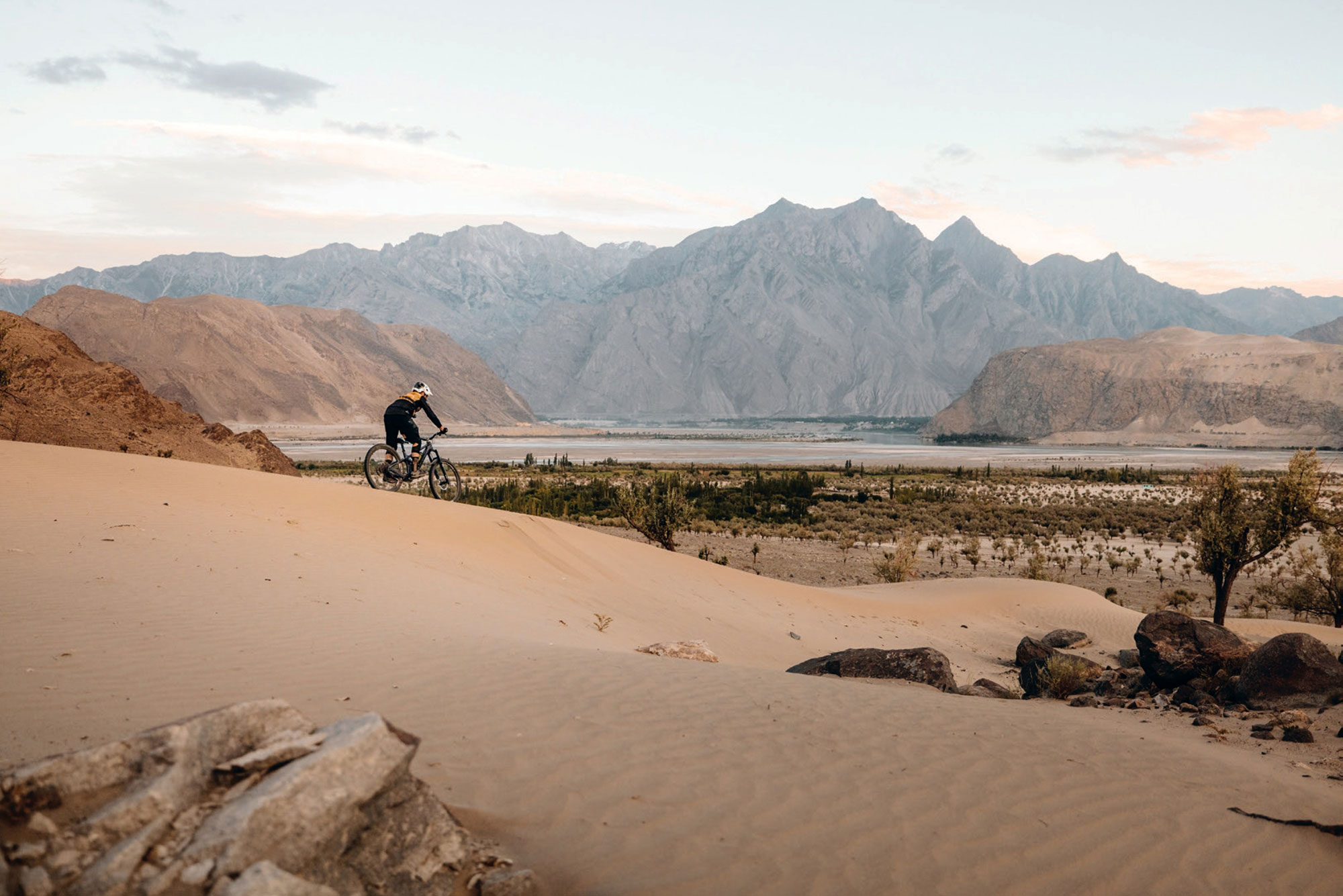

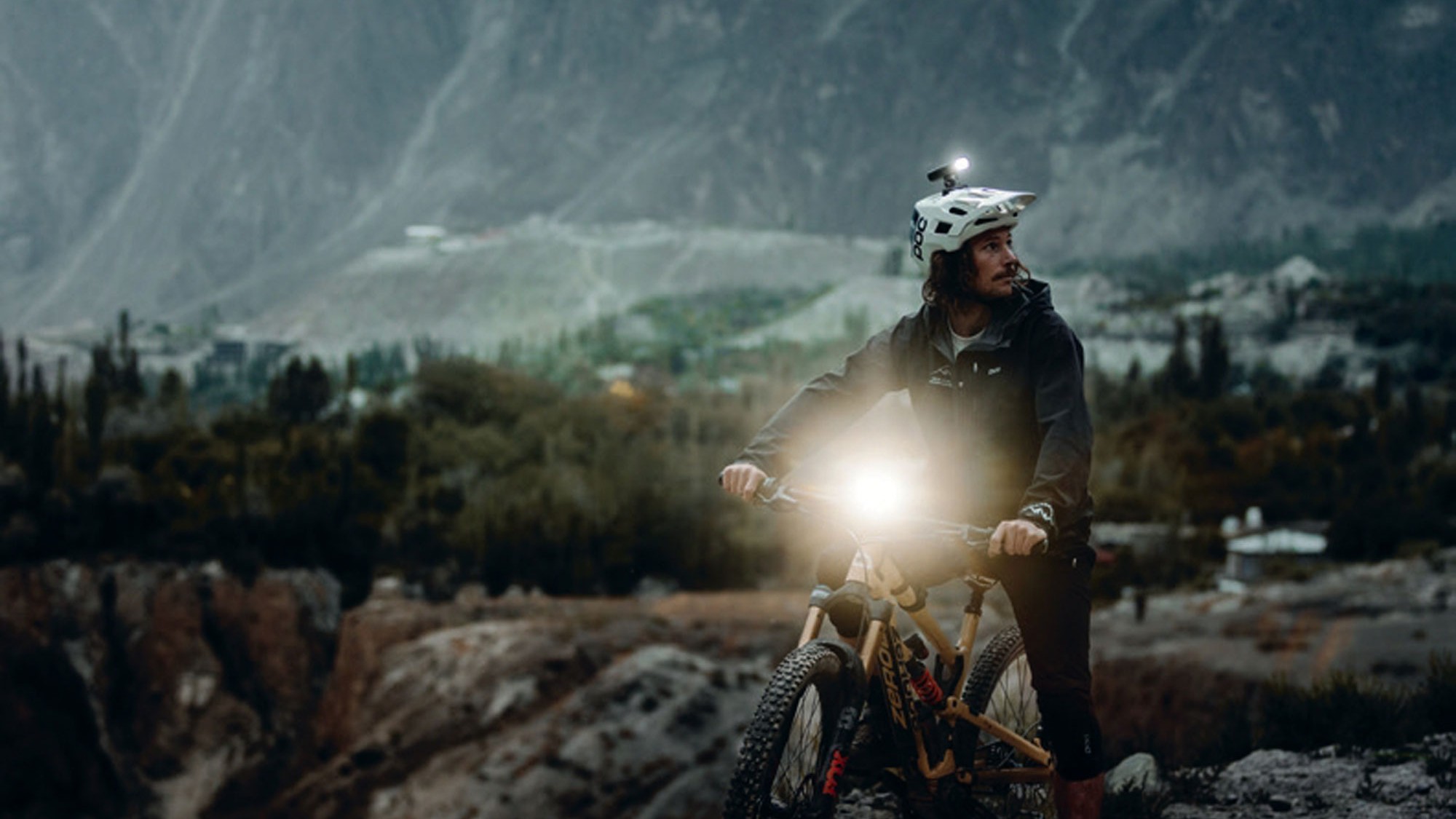

The journey up was insane—2,000m of elevation gain, bikes strapped to the back of tiny Jeeps, inching up a sheer cliffside road. By nightfall, we were hiking in complete darkness, and the altitude was hitting us hard.
The payoff? Waking up to an unreal sunrise over Nanga Parbat. Then—time to ride. The descent was absolute madness—natural flow sections, chunky rock gardens and exposed ridges. Donkeys popped out of corners, the views were unreal. By the time we hit the valley floor, high fives were flying and stoke levels were through the roof.
Pakistan delivered the adventure of a lifetime. Gilgit-Baltistan is an untamed paradise for mountain biking—huge elevation, jawdropping scenery and raw, technical terrain. But this trip was about more than just trails—it was about the people. The hospitality of northern Pakistan was unmatched—locals welcomed us like family, sharing their food, stories, and endless cups of chai.
As we packed up and boarded our flight out of Skardu, still covered in trail dust, we knew this had been no ordinary adventure. It was a fullblown expedition into the unknown—one that redefined what’s possible on a mountain bike.
The trails are untouched, the mountains are calling, and the next great ride is waiting.

Dig. Ride. Repeat
Words by Lester Perry
Images by Cameron MacKenzie & Jim Topliss
Name a sport more diverse than mountain biking. From downhill to cross-country, slopestyle to freeride – the list goes on. Each discipline demands its own unique blend of skill, fitness and creativity – yet for years, competition was the only viable way for riders to make a living, with no alternative to fall back on.
With the rise of social media, however, everything has changed. Riders were suddenly able to diversify and build their own platforms, allowing them to market themselves, promote the brands that support them, and even create their own in the process.
Flux Trail was an early adopter of this concept, leveraging their collective following and reputation to build a business with its own identity—one that combines their passion for digging and riding. Headed by Remy Morton, Jacob O’Donoghue-Price and David McMillan, this group of friends set out to fill a gap in the market while still carving their own lane in the culture, embracing the digger-rider lifestyle that has helped them to continue their careers as professional athletes.
Remy Morton’s life has revolved around bikes from the very beginning. He started racing BMX at just three years old and quickly became a prodigy. His weekends were soon spent chasing races up and down the east coast of Australia, dominating the competition at every turn. In his spare time, he began digging jumps and trails in the backyard, always looking for ways to go bigger. The backyard acted as a training ground for Remy but also allowed him to hone his own style as a rider. His passion was so infectious that even his father, Jim, got himself a bike just to keep up with the fun. Remy’s love for riding soon led him to downhill racing where, at just 11 years old, he made such an impression that the state championships had to create a new category just so he could compete. This is where Remy flourished. No longer just trying to outpace his older brother at local races, he soon found himself in Europe, competing against some of the best at World Cups. He stood out not only for his impressive results but also for his relaxed signature style on the bike, quickly becoming a favorite of the media on the track. In 2017, Remy’s love for big air and wanting to push his own limits found him at Loosefest, a freeride event in Belgium. Unfortunately, Remy overshot one of the final features on the course, resulting in a career- altering crash. The injuries he sustained meant that pursuing racing was no longer an option.
After taking some time to reflect on the accident, Remy packed up and moved to Queenstown to reset himself. He had always aspired to be the best rider he could be but, without racing, he wasn’t sure what that would look like moving forward. Inspired by the likes of Nico Vink, Loosefest founder and former World Cup racer, Remy used the social media following he’d gained from racing, along with his passion for digging, to grow a framework where he could balance creating riding content and building trails to make a living. Recognising an untapped niche in the content space, Remy began to market himself as a ‘bike park’ rider, creating edits and content for social media while simultaneously gaining more professional digging experience. In 2019, with the help of Tom Hey, Remy had the opportunity to join the Elevate Trail crew, contributing to the Crankworx Innsbruck build. While he was over in Europe, he also had the chance to work on the Loosefest build with Nico and the crew. Not only did he get redemption by riding at the same venue where he had his accident, but he also walked away with the King of Loosefest Award.
It didn’t take long for sponsors to take notice of this new lane he was carving for himself, most notably with Remy securing a deal with Red Bull in 2020. However, it wasn’t enough for him to stop working. When Covid hit, like many of us, he found himself rethinking the future. Over a few beers, he and Jacob O’Donoghue-Price brainstormed ways to fund the lifestyle they had always dreamed of. The result? Flux Trail. They set out with a goal to elevate the quality of trails in New Zealand, inspired by the world-class tracks Remy had ridden in bike parks in Europe and Canada. The timing couldn’t have been better, with several trail network expansions planned for the Queenstown area, it was the perfect moment to knuckle down and go for it. While both had trail-building experience and Jacob having worked on the Skyline Bike Park trail crew, neither had any idea about how to run a business. They also had to learn how to operate machinery themselves, as hiring an operator wasn’t feasible. Finding labor was never a challenge, however, as they could always rely on their extended group of friends to hop on board to tackle any project at hand.
One of the first to join them was David McMillan, a close friend with a similar upbringing to Remy. He’d also spent much of his youth building not- so-legal trails and jumps around his home just outside of Canberra. Dave had always dreamed of turning biking into a career which, like Remy, led him down the racing path. Competing in World Cups, he dedicated years to chasing the circuit but eventually realised his speed wasn’t quite at the level needed to win races. Rather than stepping away, he shifted his mindset—if he couldn’t win the race, he’d try to win the practice sessions by drawing as much media attention as he could. This, along with filming videos for the VANZACS brand, kept sponsors engaged and eager to continue working with Dave. However, he too found himself needing extra income to maintain a comfortable life. Wanting to stay in the industry and seeing the opportunities that trail building can bring, he bought into the company and became a co-owner of Flux Trail. Already knowing Remy from their time in the racing scene, and Jacob from summers spent in Queenstown, it was a perfect fit.
In 2021, the crew was approached by Red Bull to do a build for a video project with Remy; Seven Days and 7k. They were tasked with building a ‘DHT’-style trail from scratch, which would later be donated to Boomerang Farm Bike Park, near where Remy grew up just outside of the Gold Coast. DHT is a style synonymous with Flux Trail, blending the flow of BMX trails with the larger air of downhill riding. This was the first real test for Flux, as they had never had to work within such a tight deadline and budget. Remy’s experience with digging in this environment allowed them to leverage his knowledge of the terrain, creating a trail that was not only thrilling to ride but also visually captivating for the audience. The boys knew they really had to rip in and, after seven grueling 14-hour days, the trail was complete–all that was left was to film the segment and enjoy the fruits of their labour. This opened their eyes to what the team was capable of, not only serving as the perfect first piece in their portfolio, but also providing reassurance that they could build high-quality individual features and seamlessly connect them into a functional and cohesive trail. Confident in what they had learned in Australia, Flux took on contracts to apply their unique approach to trail design, bringing their fresh perspective to the existing networks of Skyline and Cardrona Bike Parks. The team wanted riders to flow down trails as smoothly as water on a waterslide, drawing much of their inspiration from water parks such as Wet ‘n Wild. This is where the name ‘Flux’ comes from; representing the action or process of flowing.
Flux quickly started to make a name for themselves, but what truly set them apart from other trail crews was their ability to design and build custom trails—not just for their own film projects, but for other athletes as well. One of their most ambitious projects to date came when they were once again approached by Red Bull to create a tailor-made downhill track that matched the raw style of World Cup racer, Brook MacDonald. Not only was it a dream project to collaborate with someone the team had long admired, but it was also an opportunity to showcase Flux’s work on the world stage. It was the first top-to-bottom trail they had built on a raw hillside, but the opportunity to work on an iconic video was one that couldn’t be turned down. The boys may have been slightly out of their depth taking on a project of this size, but they believe that stepping into challenges like this is the best way to grow. The exposed hillside posed a significant challenge when it came to operating machinery, especially when factoring in unpredictable weather conditions and varying terrain, however, the ability to balance these challenges while still creating a product that seamlessly and sustainably integrates with the environment has become the cornerstone of their work. The trust athlete’s place in the trail’s safety and functionality is crucial, as they know the Flux crew draw on their own riding experience to design trails they would ride themselves. This formula continued to evolve with Flux Trail using these build projects as an effective way to market their services. They went on to work on builds for Harriet Burbidge-Smith and were even scouted to contribute to a segment in Brendan Fairclough’s Death Grip 2 movie. This served as a point of recognition for both the company and Dave, who was featured in the segment riding the very features he had built.
Flux Trail has come full circle, once again securing the contract for the Crankworx Cairns build in collaboration with World Trail. This time, they’re not designing a course for just one athlete, they’re creating multiple courses for over a hundred. With plenty of opinions to navigate, ever-changing plans, and the need to adapt on the fly, the team embraces the challenge while understanding the immense pressure that comes with a job like this. Millions of dollars are on the line with an event of this scale, meaning missing a deadline is not an option. Collaborating with a world- renowned organisation like World Trail allows them to learn from their years of experience in the industry, continuing to raise their own standards and pushing their limits as builders. Remy has always stood by his goal of changing sport, but he also wants to make a lasting impact on the trail-building industry. Seeing the results Flux has achieved, he and his team recognise the business model’s potential for the future. Their vision is to build an organisation at the forefront of an ever- evolving sport—one that brands can trust and return to for delivering the highest quality trails possible. All while progressing their own riding to become the riders they have always aspired to be.

Transitions: Jayden Fleming
Words by Lester Perry
Images by Cameron MacKenzie & Jim Topliss
From “riders ready, watch the gate” and chasing milliseconds on the velodrome, to dual slalom and front flips and cash-rolls, Jayden Fleming’s career on the bike has followed many paths. Having ridden for 18 years, he’s found his lane and it seems he’s only just beginning.
Life is about taking chances and seeing where a chosen path may lead. At age six, these decisions aren’t given much thought, and interest can bounce between ideas and activities multiple times a day — or even within a single hour. At just six years old, Jayden chanced upon an invite to a BMX ‘have a go’ session while talking to someone from his school.
‘‘I remember pretty clearly, I was walking home from school and someone next to me, who I didn’t know, had a flyer that their class had been given. He handed it to me and said; ‘‘Hey, do you want this?’’ I looked at it then took it home and showed mum. The flyer promised ‘three nights free’ or something, and my mum agreed we’d go down. So I went along — and found love straight away. My sister was doing gymnastics at the time and mum said, ‘‘hey, you can do this too, but you’ve got to quit gymnastics’’ — thinking there’s no way she would do that. But, she did. And that’s how it became a pretty cool little family affair,’’ explains Jayden.
“BMX is such a family sport, and you see it with so many families. The whole family’s involved; very rarely is it just one child. We ended up spending all of our weekends together, going away, travelling and going to races. It was super cool to be involved in such a family sport. I can’t think of too many others where the whole family is at an event together. Normally, you might get one kid off to rugby while the other is going to netball. So, that’s something pretty special—not just with BMX, but bikes in general.”
By 2009 (aged nine), BMX led Jayden to trans-Tasman racing, firstly at the ‘Track Attack’ in Melbourne. Six races, over nine days, on six different race tracks. “That was a really cool way to touch the edges of what international racing was. I’m still friends with some of those guys I met then who kept on riding and, obviously, with social media and stuff now, I’ve kept those friends along the way.” Later that year, he competed in his first World Champs in Adelaide.
These early international races gave Jayden a taste for travel, and he knew he wanted more. He went on to race at the World Cup level, his BMX career taking him to more than a dozen countries. While preparing to race at the Grand Nationals, the USA’s biggest race meet, he crashed and smashed his wrist to pieces. Nine hours under the surgeon’s knife and 17 pieces of metal later, he began his build back to racing.
Once school was behind him, Jayden moved from Auckland to Cambridge in the quest to chase the highest accolades in BMX.
The NZ North Island BMX Championships in 2018 triggered another transition for Jayden. He took his first Elite win at the event, riding high, happy with his performance and enjoying his time on the bike… until his luck ended. “I had a silly crash on a pump track in Cambridge where I just looped out and put my leg out. I’d never done it before, but my knee kind of stretched and popped, and I was like, ‘I guess that’s what a ruptured ACL feels like’. And lo and behold, it was. I did my ACL, MCL, and meniscus,” says Jayden.
Eleven years of hard graft chasing the BMX dream came to a halt and, once his knee was put back together, his focus shifted to getting back to the pointy end of the sport.
With surgery complete, and unable to ride BMX during recovery, Jayden’s eyes were opened to some of the other cycling on offer in the Cambridge area, and he began riding on the Velodrome to help regain strength and fitness. “I got pretty hooked into that and eventually got invited into the track development space there. I got into it because, at the time, I wasn’t training with many people. I was still training with people now and again, but a lot of it was by myself on the BMX. I loved the whole community aspect that track gave me at the time, where everyone was training together all the time in one space. It was really social and, at the time, it felt like there was more opportunity and support to pursue track cycling from the governing body than BMX had.”
The NZ BMX High-Performance program disbanded in 2016, leaving riders scraping together their coaching, support, and funding. With no firm development pathway to the top tier in BMX from the governing body, track cycling provided Jayden with an avenue to chase his dreams of being the best in the world. “I could never realistically see myself winning Olympic medals or being the best of the best. But, to me, becoming a pro cyclist was something that I saw as potentially achievable – and a goal that I wanted to pursue.”

Jayden spent time at the ‘Regional Track Hub’, a short-lived program created to identify and develop young talent and prepare them for the High-Performance squad and, ultimately, Olympic medals.
“A lot of the people from that program have gone on to the Olympics, and a lot of people have medals. We are all really grateful for what it was, but I think we’re missing it now – that space is gone, obviously, with funding issues.”
In October of 2021, on the freshly laid asphalt of Cambridge’s Velosolutions pump track, Jayden raced in the Red Bull Pump Track World Champs qualifier event. He turned heads immediately, partly for racing in a road cycling helmet, but more for his raw power and speed. Although he’d not been on the BMX much before the event, his natural talent shone, and he mixed it with the purist BMX racers to finish third in a tightly fought battle.
“I’d still get my BMX bike out every now and then. I’d go to a gates night, but only once a month or so, and then come back just for national champs. That would have been early 2021.”
As impressive as he was on the Velodrome, Jayden’s time on the boards ended abruptly. The national track coach at that time took Jayden to a pub and sat him down: “You’re the wrong body type, you’re fully developed, you’re not going to go any faster, you’re not going to go to the Olympics; you should quit.” He explained that he’d be better suited to downhill MTB racing than track cycling.
“At the time, it was pretty brutal and not what I wanted to hear. I thought my hopes and dreams were all over, but now, looking back on it, he was trying to help me.”
After just two years of rapid progression, Jayden’s time on the track looked to be coming to an end and with no firm goals or plans ahead, Jayden felt he was a bit of a lost cause, struggling to figure out what direction to take his cycling. “I had this old crappy BMX bike that I’d had for years, and I kind of just started riding that and having fun. It was real interesting trying to learn new things.”
While still deciding if he was entirely done with track cycling, Jayden sat down with current Olympian, Sam Dakin, to try and get some clarity and answer the question; “where to from here?”
“He sat me down and said; ‘Why do we do the sport?’ And he went through this really cool explanation. ‘We do it for that six-second euphoric feeling when you win a race. How often have you felt that way with track?’ And I was like; ‘well, once or twice in the past year and a half.’ In my mind, it all clicked. I had just felt that same feeling three times in the past week learning these new tricks.”
Crankworx was six months down the road; so, toward the end of 2021, Jayden set his sights on climbing the freestyle MTB competition ladder, hoping for an entry to speed-and-style. “At the time, I could do a flip and that was about it. If I could get an entry to speed and style at Rotorua, that would keep me busy for six months.” Next up was to find a bike worthy of the task. In stepped Tim White (OG BMX and MTB industry player), who plugged Jayden into the ILABB team and connected him with Marin Bikes, who took a punt on him; an as-yet unproven quantity with big MTB dreams.
The weather played havoc with course conditions at the 2021 Crankworx Rotorua, or “Wetworx” as many dubbed it. Slalom was a tough pill to swallow as Jayden and many others battled what had become a slippery slide of a course. The result was one he’d forget, and a steep learning curve – but consistent results at the remaining Crankworx Rotorua events and Crankworx NZ Summer Series – led him to a complete the 2022 World Tour, circumnavigating the globe for the first time, gaining valuable experience in the big leagues. Although satisfying his wanderlust, the season left him wanting more.
Crankworx Whistler, in 2022, remains a highlight of Jayden’s cycling career as he slayed the pump-track competition to take third place. On a track not unlike a BMX track, four athletes raced each other side-by-side on a four-lane, 110m straight-line course. The top two progressed to the next round, and the bottom two were sent packing.
“The medal I got in Whistler was super special because there was a year’s journey to get there – and I didn’t expect to get there – but everything kind of clicked on the day. I’d qualified first, got the fastest lap of the day… and got a medal! But I knew why I had moved to mountain biking, and the reason I was there was for speed and style. That’s what interests me. That’s what I wanted to learn. That’s what I wanted to do. So that medal wasn’t completely fulfilling. It was awesome but, internally, I just wanted to do well at speed and style.”
However, unfortunately Whistler’s Speed and Style didn’t go to plan, and Jayden was out early due to a mistake in his run.
Come 2023, not long after he was the first person to throw a massive double backflip on Queenstown’s recently revamped and upsized ‘Dream Track’ jumps, Jayden put his experience and passion for all things cycling into a new job. He joined Velobike (track cycling parts specialists) as the operations and sales lead at their Cambridge base, becoming a ‘Jack of all trades’ for the small business.
His 2024 season results confirmed that Speed and Style were indeed his strengths. Focused preparation and practice meant his bag of tricks was all but overflowing and, when combined with the speed and race craft from his years as a BMXer, he became a threat at any Speed and Style competition he put his mind to.
“I spent the last year (2024) putting my absolute heart and soul into it (Speed and Style). I was struggling in it, but I knew that’s what I wanted to do. I spent all year just focusing on front flips and double flips because I knew those were the two tricks I wanted to do. Staying in Cambridge, not getting distracted and just focusing on trying to be fast and smooth. And I went from qualifying 25th, 23rd, around the mid-20s, to qualifying fourth, third and second at last year’s rounds, which was cool for me. It goes back to what the sport’s about; following the journey and getting there.”
His season began with ninth place in Rotorua, and then he backed up by fifth placings in Cairns and Innsbruck. Unfortunately, his world tour was cut short due to a wrist injury, meaning he would miss the pinnacle event and one he’d done well at before: Crankworx Whistler. “I was in Europe at the time, so I stayed and watched the Olympics. I didn’t feel comfortable going all the way to Canada when I had a half-ass wrist. I didn’t feel like I would be riding my best.”
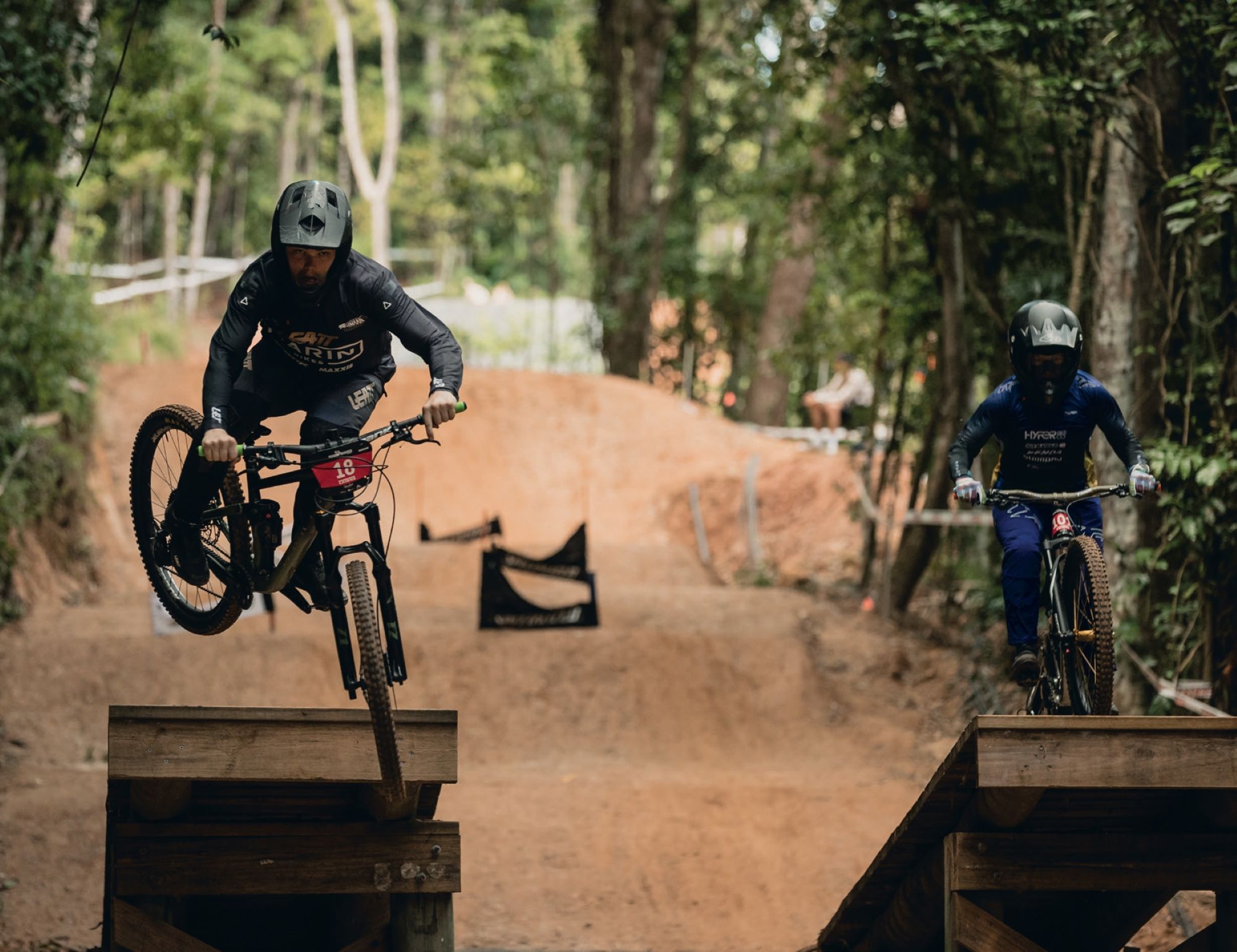
Once his wrist was ready, October 2024 saw yet another diversion for Jayden as he conquered the Whaka 100 XC Marathon. “The Whaka was awesome. I went and watched a mate do it last year, and I guess I just got bored and thought, you know what – 100k on a mountain bike; it’s a big effort, but it’d be really cool. A fun thing to say you’ve done. I think it’s a little bit like the Coast-To-Coast – it’s a very Kiwi thing. It would be so awesome to say that you’ve done the Coast-To-Coast, but I feel as far as a mountain biking event in New Zealand, the Whaka’s the equivalent. Yeah, I don’t say prestigious, but quite a well-known cool thing to do. It was awesome to get out there and do it.” Followers of the Marin Bikes Instagram account tracked Jayden’s Whaka experience as he live updated throughout his nine-plus hours out on the course.
Late in 2024, Crankworx World Tour promoters emailed athletes announcing they would discontinue Speed and Style competitions and replace them with a ‘mystery event’ at the 2025 Cairns Crankworx event. Jayden felt lost and unsure about what his season might look like now that his favourite event had been shelved, and he had minimal information on what would replace it.
With big plans for the upcoming year, Jayden filed his resignation with Velobike, packed his life into his car and drove to Queenstown to immerse himself in the thick of the MTB scene and take on an operations role with Ilabb.
The 2025 Christchurch Crankworx Summer Series was announced for February, and Jayden marked it in his calendar. Initially focussed on the pump track, after chatting to a few mates, the Slope Style competition got on his radar and he managed to secure an entry to what would be his first FMBA gold-level slopestyle event.
“I got the confirmation of a wild card at the end of December. So I had about six weeks to get ready. I had put a lot of work into cash rolls, which I really wanted to land, and I had landed a handful on airbags, but didn’t have them dialled enough! The biggest hurdle was learning a new mindset for a slope comp and being able to chill out kinda and take it jump by jump. All I had known beforehand was races and to bash my way to the bottom as fast as I could.”
The lessons learned from his time in the track program were again put to use, this time in his competition plan for the Christchurch Summer Series. Each practice and competition day was pre-planned in his phone’s Notes app, leaving his mind free to focus purely on the task at hand rather than when and where he should eat lunch. Unfortunately, even with meticulous planning, hiccups can occur. Practise morning came, and a minor infection in his finger had spread up his arm. The onsite medic suggested he go to the hospital for IV antibiotics, meaning he would miss the first practice. Not the ideal lead into a Slope Style event, but if there’s one thing Jayden can deal with, it’s adversity.
“Going into my run, I still hadn’t done the double flip on the middle jump, or my cash roll down the bottom, but I kind of just backed myself. Obviously the double flip worked, but the cash roll didn’t. But, I’d rather go all in and give everything I have and crash, than do a safe run and be like, oh shit, I wish I’d done more, you know? So, really cool. All the dudes are super friendly. I’m kind of hooked now. Like, it got more exciting the more prepared I felt. On the morning of the comp, I was shitting myself, I was so scared.
“I’ve never considered myself a proper trick or slope-style guy. But hey, an opportunity came up to put my name forward for a wild card, and I happened to get it. So I’ll go give that everything I’ve got. Before I even got into the sport, Nikolai (Rogatkin) and Eric (Fedko) and Lucas and all those guys were my idols. So, to be riding practice and competing against them is pretty cool for me, and doing it in New Zealand was pretty special; anytime we get to compete in New Zealand is sick.”
For 2025, Jayden continues to rack up air miles, again taking on the Crankworx World Tour, this time as part of Martha Gills’ ‘Lucid MTB’ team, created to support selected riders in chasing their MTB dreams. Jayden continues with previous sponsors Marin, Leatt and Ilabb, with other team sponsors adding to the roster, including Hope, Deity, Marzzocchi, Microshift, Ride Concepts and WTB.
The tour kicks off in March with Crankworx Rotorua, where he’ll be hitting the Pump Track, Whip Off, and rolling the dice at the Best Trick competition. Once Rotorua is in the bag, he’ll be back on the road again, returning to the USA, just as he did as a youngster chasing the BMX dream. Only this time, however, he’ll have a mountain bike in tow for the Sea Otter Festival, competing across Dual Slalom, Enduro and Downhill instead of listening to; “riders ready, watch the gate” on the BMX start hill.

Bosch CX-R: The Most Powerful eMTB Motor Yet
Words: Liam Friary
Images: Supplied
When Bosch says they’ve built their most powerful eMTB motor ever, you sit up and take notice. The new Performance Line CX-R isn’t just another incremental upgrade – it’s a proper beast that’s been designed with one thing in mind: unleashing pure trail energy.
As someone who’s spent plenty of time on eMTBs, I’m always curious when a major player like Bosch drops something completely new into the mix. And the CX-R definitely feels like a departure from their usual approach. While previous Bosch motors have been known for their reliability and smooth power delivery, this one’s clearly been built for riders who want to push harder and go faster.
The numbers alone tell quite a story. We’re talking 100Nm of torque, 750W of power, and support of up to 400% of your pedal input. That’s seriously impressive stuff, and puts it right up there with some of the most powerful motors on the market. But what really caught my attention was how Bosch has approached the whole package – it’s not just about raw power.
Two New Modes That Actually Make Sense
The standout feature for me is the exclusive Race mode. This is clearly aimed at riders who want immediate, uncompromising power delivery. When you’re picking your way through technical terrain or need that instant boost out of a tight corner, the Race mode doesn’t mess around. It gives you full assistance right up to maximum speed, with what Bosch calls “Extended Boost” for those moments when you’re wrestling with big rocks or gnarly root sections.
What’s clever is that they’ve also introduced an eMTB+ mode that sits between their existing eMTB setting and the new Race mode. This feels like Bosch acknowledging that not everyone wants to be pinned back in their seat every time they touch the pedals. The eMTB+ mode includes something called Dynamic Control – essentially a kind of traction control system that keeps things manageable even when the terrain gets loose or steep.
Both modes can be fine-tuned through Bosch’s eBike Flow app, which is something I really appreciate. Being able to customize how your motor responds to different situations makes a huge difference when you’re trying to dial in the perfect setup for your riding style.
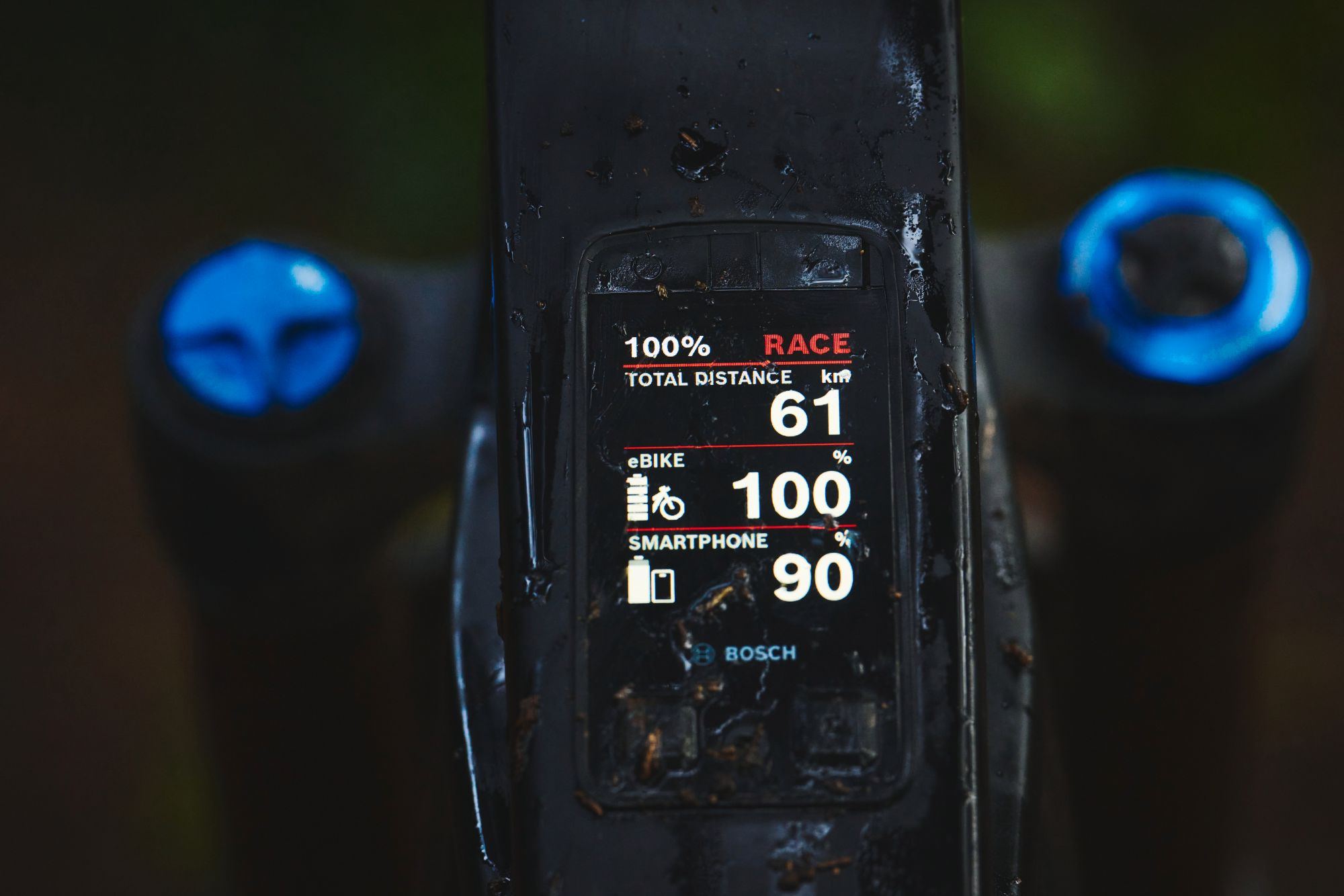
Built Like a Proper Race Machine
The materials spec on the CX-R reads like a who’s who of high-end engineering. We’re talking aerospace-grade stuff here – magnesium housing, titanium crank spindle, and ceramic ball bearings. All of this adds up to a motor that weighs just 6 pounds, which is pretty impressive when you consider the power it’s putting out.
What I find interesting is that Bosch has clearly spent time with top-level athletes during development. You can see this in the attention to detail – things like the decoupled drivetrain that reduces mechanical noise when you’re descending, and the advanced sensor technology that measures your pedal input up to a thousand times per second.
The Tech That Makes It Work
Speaking of sensors, this is where things get really interesting from a technical perspective. The CX-R uses inertial measurement units (IMUs) that track acceleration and rotation in six dimensions, plus inclination and tilt angles. Essentially, the motor knows exactly what the bike is doing at any given moment and can adjust power delivery accordingly.
This kind of sophisticated sensor tech means the motor can deliver power precisely when and where you need it – whether that’s a punchy acceleration out of a switchback, a controlled start on slippery surfaces, or sustained power on steep technical climbs.

What This Means for eMTB Riding
The CX-R feels like Bosch’s answer to the ongoing debate about full-power versus lightweight eMTBs. Rather than compromising on either front, they’ve tried to build something that gives you serious power while still maintaining the kind of responsive, lively feel that makes eMTBs fun to ride.
The fact that it’s launching with an exclusive Race mode suggests they’re specifically targeting riders who want to push boundaries – whether that’s in actual competition or just personal progression on challenging trails. At the same time, the eMTB+ mode with its Dynamic Control system shows they haven’t forgotten about riders who want that power delivered in a more manageable way.
The Bottom Line
While we’ll have to wait until fall 2025 to see the first bikes with the CX-R in shops, this feels like a significant step forward for Bosch. They’ve clearly been listening to feedback from serious eMTB riders who wanted more power and more control over how that power is delivered.
Whether the CX-R lives up to its impressive spec sheet will ultimately come down to how it feels on the trail. But based on what Bosch has achieved with their previous motors, and the clear focus on performance and customization with this one, it could well be the motor that sets the new benchmark for what a serious eMTB should be capable of.
For riders who’ve been waiting for that perfect combination of power, control, and refinement, the CX-R might just be worth the wait.
SRAM Eagle 90 Transmission
Words & Images Liam Friary
RRP $1,488
Distributor Worralls
Analogue aficionados rejoice—cable ain’t dead! In fact, it’s far from dead with the recent launch of SRAM’s new Eagle 90 Transmission. A few years back, we saw the launch of SRAM’s electronic AXS Transmission which removed the traditional derailleur hanger by hanging the derailleur directly onto the frame.
This brought the benefits of strength, shifting under load, and improved shifting performance. Well, now all of this is offered in a more affordable mechanical version, which is great news—especially in the current economic climate.
There’s two new mechanical groupsets; SRAM’s Eagle 70 and Eagle 90. These are both 12-speed, cable-operated drivetrains, offering mechanical alternatives to their electronic counterparts. Eagle 90 is basically the mechanical version of GX AXS Transmission. It uses the same cassette, chain and crank arms, but adds a new steel chainring, plus a mechanical derailleur and shifter. Eagle 70 is the step-down option that replaces NX Eagle. It’s essentially the mechanical version of the S1000 Transmission, sharing its crankset, chain and XS-1270 cassette. One advantage: the cassette works with the more common HG freehub standard. It’s difference from the Eagle90 derailleur, is that it utilises cheaper materials and a Drag Spring damper to keep costs lower. For this review, I’ll focus on the Eagle 90 Transmission which I’ve been riding for a few months. You can purchase the complete SRAM Eagle 90 Transmission groupset with exception of BB. From a pricing perspective, its more expensive than Shimano’s XT mechanical drivetrain but cheaper than SRAM’s GX AXS Transmission.
Eagle 90 Installation is a simple setup procedure. SRAM’s “Prepare. Hang. Tighten.” motto is mostly accurate, but if you’ve spent years working on traditional derailleurs, there’s definitely a learning curve—you need to forget some old habits. That said, after the first installation, the second and third will go much smoother.
The “Prepare” step involves checking SRAM’s website or using the AXS app to enter your bike details (brand, model, frame size, chainring size). The system then gives you your specific chain length, cage lock position setting (A or B), compatible chainring sizes, and which cog to use for setup. SRAM provides excellent installation videos that cover the little details that help achieve perfect performance.
Overall, installation is straightforward—any decent home mechanic can handle it. Just be aware of a few things: changing chainring size or adjusting dropouts can affect shifting. Also worth noting: SRAM emphasizes that T-type drivetrains are very sensitive to proper torque specs, so use a calibrated torque wrench when installing both cassette and derailleur.
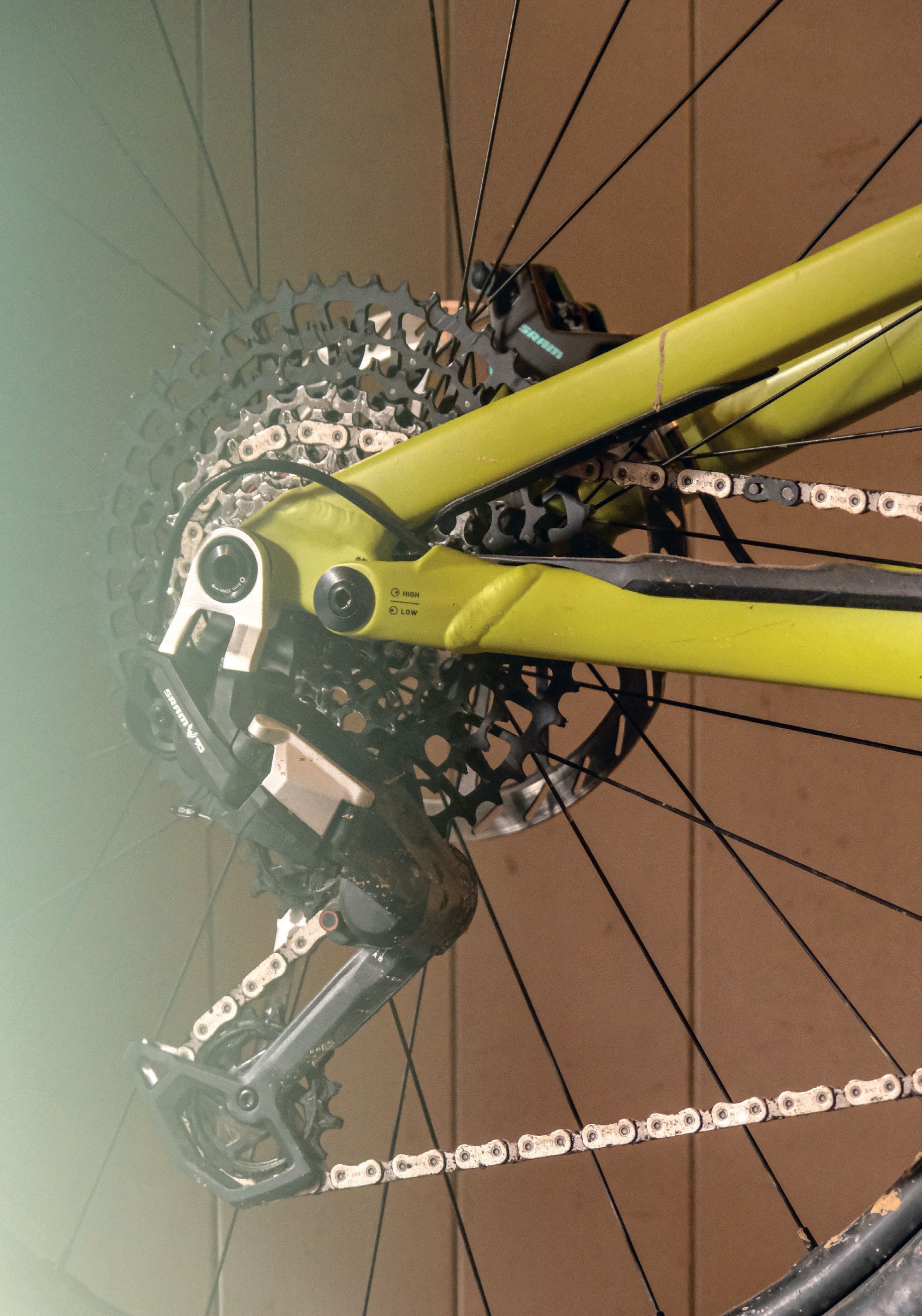
The Eagle 90 Derailleur uses a Full Mount design that connects straight to your frame without needing a separate hanger. There’s a catch though—it only works with UDH (Universal Derailleur Hanger) dropouts, so if you’ve got an older mountain bike (non-UDH), you’re out of luck. A standout feature is that the derailleur is rebuildable. If something breaks or wears out, you’ve got options: you can replace just the skid plates, get new P-Knuckle or B-Knuckle assemblies, or even grab a bushing replacement kit. The jockey wheels and inner cage are also available separately, or you can buy the complete package with the full cage and damper. This is a strong move away from the disposable culture of ‘break it, throw it, buy new’. The ‘right to repair’ movement has been gaining serious momentum lately—not just in cycling but across pretty much everything we own. From phones and laptops to cars and tractors, people are pushing back against manufacturers that make it nearly impossible to fix your own stuff without specialised tools or proprietary parts.
The cage on this derailleur is the same as the GX AXS Transmission model—steel on the outside, aluminum on the inside. Pretty cool feature: you can take off the whole assembly and damper from the main body without needing any tools. And since it’s modular, you could upgrade to a high- end version from an X0 or XX SL derailleur if you wanted. So, the Eagle 90 derailleur is a solid unit weighing in at in at 390g. However, its 100g lighter than the GX AXS version, which is welcomed.
The Eagle 90 Shifter features a brand-new trigger shifter with a specific cable-pull ratio for T-Type derailleurs and cassettes (not compatible with older Eagle systems). It comes in double-click for regular bikes or single-click for eMTBs, with a smaller plastic upper paddle for upshifting and a larger, textured aluminum lower lever for downshifting. Installation is flexible—use SRAM’s MMX system to either mount it directly on your handlebar with a standalone clamp or attach it right to a SRAM brake lever with the appropriate adapter. One nice detail: the cable runs straight and parallel to your handlebar, which looks super clean when paired with SRAM’s newest Stealth brakes.
The Eagle 90 Crankset shares the same alloy arms as the GX AXS, just with a black finish and steel bolt. It’s built for the modern 55mm chain line and uses a DUB Wide spindle. You can get arm lengths from 155-175mm, plus there’s a special eMTB version for Bosch and Brose/Specialized motors. I opted for shorter 165mm cranks on my set up.
The big difference from the GX AXS is the new one-piece steel chainring. It’s twice as heavy as aluminum but lasts three times longer and runs quieter. Thanks to the modern 8-bolt interface, you can easily swap to a lighter alloy ring or add a power meter if you want. The crankset comes in 30T, 32T, and 34T sizes, and includes standard two-piece bash plates.
The Eagle 90 Cassette uses the existing XS-1275 cassette from the GX AXS drivetrain. It needs an XD freehub body and works best with the 55mm chain line spacing. This cassette delivers a massive 520% gear range with its 10-52T spread. Construction-wise, the eight largest cogs use a pinned design while the smallest four form a single mini-cluster. The big 52T sprocket is aluminum for weight savings, and all the others are nickel-plated steel for better durability. A key feature is the narrow-wide tooth profile (X-Sync) that matches perfectly with the chain, creating better retention and specific shift gates in both directions—this is what allows for such reliable shifting even when you’re pushing hard on the pedals.
The Eagle 90 Chain uses the same GX Flattop chain from the existing lineup. It features the distinctive Flattop design that’s specific to Transmission systems and comes with a PVD coating that helps fight wear and corrosion. To keep costs down, the GX version uses solid pins instead of the lighter hollow pins found on higher-end SRAM chains. But it still includes the same convenient Powerlock master link that makes installation a breeze.
Eagle 90 Transmission Riding—to date I’ve probably done around 150-200km of riding with the new groupset. It’s plenty enough to get acquainted with its performance but not nearly enough to report on durability and longevity. However, from that first ride up until writing this review its been bloody good!
The smooth shifting does great under load, with positive engagement and a quietness to the drivetrain. Often, it’s so damn quiet you don’t even know you’ve shifted. For the last two decades, I have been used to backing off the pedals when shifting. Transmission effectively removes that from the equation, however, it does take some getting used to. I did find that the mechanical version of Transmission prefers shifting when under load. I should point out that the system shifts just two gears at a time. Interesting, perhaps, but it makes sense and is a smart design decision that likely helps keep gear transitions smooth when you’re putting power through the drivetrain. It’s a small detail, but it’s these thoughtful touches that contribute to how well the whole system performs.
There’s something about the tactile feel when thumbing the shifter up or down gears that resonates. Maybe it’s because I’ve been riding bikes since before there was electronic shifting, but there’s a certain appeal to the analogue feel. The lever ergonomics of the shift paddles are superb, especially that concave profile on the upshift paddle—it’s like it was designed specifically for my thumb. From the first ride, the natural feel, comfort and shift experience really stood out. Of course, this shifting is on par with what you’d expect from this level of groupset. It’s solid, dependable and functions really well. Sure, it’s not high-end X01—but that’s not the point here, and it keeps the price lower.
It’s been good riding the groupset at a variety of different locations. I’ve been on multiple rides in Rotorua and found that on the steeper fire roads and singletrack, shifting under load—or rather, last minute—before a feature (or if my heart rate soared too high) it found the gear without hesitation. Shifting under load is a real standout feature. Basically, it removes any thinking about gear changes and allowed me to focus on the line, putting down power to grind away up a fire road or tackle technical features.
On the descents, the silence continued—thanks to an improved clutch for Transmission—and after numerous rides, the components have only gotten better as they’ve bedded in. During my rides in Rotorua, I had a couple of stacks—nothing major—and the robustness of the derailleur meant I could dust off, grab my bike and continue on the trail without any shifting issues whatsoever. I did slam the bash guard against tree roots a couple times while rolling but, again, it just shrugged it off like it was nothing. No damage, no drama.
After tweaking the cable tension, I haven’t run into any real problems with the Eagle 90. Like any cable system, you’ll need to do regular maintenance—which is different from electronic derailleurs that generally keep shifting well for longer periods. On the plus side, there’s no battery to worry about charging— so each system has its own advantages and disadvantages. I personally like the fact that there’s nothing to charge—or remember to charge!—before heading out for a ride.
Another good addition is the advanced technology delivered to this groupset, while still being realistically serviceable. Unlike older derailleur designs that often meant replacing the entire unit after a good smack on a rock, these T-Type models let you swap out specific components—the outer parallelogram link, skid plates, derailleur cages—without throwing the whole thing. Perfect if you’re abusive with your bike and don’t want an expensive electronic mech hanging off your bike.
I noted earlier that shifting is best under load, as it can feel sluggish if soft pedalling. It actually performs better when you’re more aggressive—kind of counterintuitive but that’s how it works. This takes a bit to get used to but you soon adapt. It hasn’t skipped a beat since I’ve been on it—precise and crisp. Given how well it handles high-torque shifting, I bet it’ll be fantastic on eBikes with motors adding extra power through gear changes.
All in all, the new SRAM Eagle 90 Transmission is a pretty sweet addition to the mountain bike drivetrain scene. It basically takes all those cool features from the electronic versions— no hanger needed, super simple setup—but without emptying your bank account. The clear standout is shifting under load, which is seriously impressive. I’m also into that ‘click’ feedback that only mechanical can deliver. Sometimes, the analogue world prevails over the pressing of electronic buttons and dealing with apps and dead batteries.
Yeah, it’s a bit heavy—especially the cranks— and it’s not as boujee as the higher-end product from SRAM, but it doesn’t lack any performance benefits. It’s also pricier than other mechanical groupsets, but the Full Mount design eliminates a lot of the usual headaches that mess with shift performance and durability. The Eagle 90 Transmission is bloody good!

Trek Slash+ 9.9
Words Georgia Petrie
Images Cameron Mackenzie
RRP $19,999
Distributor Trek NZ
It’s fair to say we’ve seen a whole heap of changes within the eMTB landscape over the past few years. The last 18 months in particular have brought about the cementing of the SL (Super Light) category, and an absolute smorgasbord of full-powered options. Gone are the days of an eMTB resembling somewhat of a retro downhill bike with a motor strapped to the bottom. The wide range of battery sizes, motor options and travel means that the whole e-experience can now be more tailored than ever before.
With so much choice on the market, there’s something to be said for Goldilocks’ age-old personal tagline of “just right”. This is exactly what comes to mind when it comes to the increasingly popular SL eMTB category. Increasingly, we’re seeing more and more bikes in this class being specced with bigger batteries paired with lightweight, low-power SL motors, resulting in bigger battery range whilst maintaining a ‘not-too-heavy’ ride experience— in other words “the best of both worlds”.
The Slash+ is essentially an electrified version of Trek’s ever-popular acoustic Slash, with the high-pivot, eye-catching chassis boasting a grunty 170mm of front and rear travel, with a fork that can be up-travelled up to a whopping 190mm. No mistake made—this is a burly bike that’s right at home on the roughest of double- black trails—and, as I came to learn: the rougher and more technical the trail, the more the Slash+ thrives, all without compromising on climbing ability. By incorporating a hearty 580wH battery paired with TQ’s HPR50 motor, the Slash+ strikes a balance, enabling you to “do more”; whether it’s an extra after-work lap, a backcountry ride – or even the difference between going for a post- work spin and staying home, especially as we say goodbye to post-work daylight hours once again!

eBike Features
Although sporting the same 50Nm, 300-watt peak powered TQ-HPR50 motor as its shorter-travel Fuel EXe counterpart, a key point of difference—the defining factor of the Slash+’s place in the eMTB lineup—is it’s chunkier 580Wh battery. This stacks up well against other mid- weight contenders, punching above its weight relative to the likes of other longer-travel ~160mm options, such as Transition’s freshly released Regulator and Mondraker’s Dune, which both sport 400Wh batteries, and paired with Bosch’s grunty 55Nm, 600W peak powered SX motor. With so much choice and such subtle differences between motor and bike manufacturers, whether you’re a weekend warrior tackling technical blues or a park rat aiming to tackle every double black option in one day (and still pedal home afterward), the SL eMTB space really has expanded to cater for a wide range of rider types.
Alongside its big battery, a core outlier of the Slash+, relative to many of its SL competitors, is not only a removeable battery but the ability to swap between TQ’s 360 or 580Wh batteries, or swap in a fresh battery mid-ride. There’s also the option to purchase TQ’s 160Wh range extender, which fits snugly into the bottle cage, weighing 950g. The TQ-HPR50 is discreetly tucked away and pleasantly quiet even under load on full power mode, making the Slash+ one of the stealthiest long-travel eMTB’s I’ve ridden. The motor has three power modes and a ‘walk’ mode, rounded out with TQ’s integrated top- tube display, and two-button handlebar remote. Though the max power assist level and pedal response for each mode can be easily fine-tuned via the Trek Central and TQ apps (though I’d prefer to have one central channel for adjustment), I found the display a little unintuitive at times, and both this and the two apps almost a little tacky and clunky relative to counterparts such as Specialized’s Mission Control App, and Bosch’s eBike Flow app, both of which have undergone significant iterations and deliver a more refined and intuitive user experience. I also found the ‘walk’ button somewhat unwieldy to access and slow to kick-in, which isn’t uncommon across the wide range of eMTB brands I’ve tried and, whilst not a dealbreaker, can be rather frustrating.
Geometry and Frame Details
Make no mistake, the Slash+ is burly bike. With 170mm of front and rear travel, paired with a 63.4° head angle and 1233mm wheelbase, the Slash+ is made for steep, rough terrain—it’s fair to say that anything less is wasted upon this bike. At 77.5° the seat angle is surprisingly steep for a bike of such travel, making for a comfortable all-day climber that’s planted on steep ascents, with a particularly upright seating position making light work of long stints in the saddle – and making you second guess that you’re basically riding a mini downhill bike uphill.
This concoction of generous geometry has created a bike that descends exceptionally well with minimal compromise on climbing ability—the point of instability more or less doesn’t exist on the Slash+, with the bike instead asking for more if tackling anything below a double black technical or jump trail. Paired with a reach of 479mm, the Slash+ does feel generous relative to other SL offerings, with plenty of room to move around on the bike, whilst the 29” front and 27.5” mullet wheel size setup creates a sense of nimbleness oftentimes lost in eMTB experiences. Overall, the bike was exceptionally well-rounded, and one of the most versatile bikes I’d ridden in a long time. For how capably it descends, it almost seems wrong to climb with such comfort!
When it comes to nitty gritty frame details, the Slash+ has a plethora of thoughtful details. The integrated chainstay protector isn’t here to faff around—this thing is chunky and robust, and it means business when it comes to limiting chain slap, which is often a dinky afterthought on so many stock eMTB’s. On the Slash+, however, it’s a welcome addition—especially given the rough terrain that the bike is best suited to. The rear fender is also a nice touch—so often I’ve ruined frames with small-yet-mighty stones that work their way in between the rear wheel and chainstay, and this does a nice job of helping minimise this as well as keep mud at bay. There’s also a custom, Trek-specific chain guide which mounts directly to the motor housing—given my experience with zero chain drops, I’d say this is a well-executed addition. I found the charging port location a little odd to work with, having been so used to side-mounted ports, and often found myself having to really yank the charging cable hard to remove it once charged, which sometimes resulted in inadvertently smacking it on the underside of the top tube—oops. Having said that, this location makes sense when considering the bottle mounted TQ range extender, which fits snugly in this space when attached.
Ride Performance
For a bike with a 170mm fork up front, the Slash+ is an exceptionally comfortable climber, sitting high in the travel with a balanced centre of gravity. Not once did I find myself fighting to keep the front wheel on the ground, which is impressive considering the bike’s relatively slack head angle. It navigated tight switchbacks with surprising ease despite a long wheelbase—there was many an occasion where I was glad to have a mullet configuration, as it gave an otherwise cumbersome bike the ability to navigate tight, technical ascents. Traction isn’t an issue—in fact, this was one of the most planted bikes I’d climbed on, with a rear wheel that’s never fighting for grip. The Rockshox Vivid Air shock behaved itself well with minimal ‘bob’. Whilst the Rockshox AXS Reverb is a welcome addition on any eMTB—anybody who’s had to complete any mechanical dropper post maintenance on an eMTB will attest to how much of a headache it is—the standover on this bike is low at 77.6mm for our 17.5” sized test bike and, when paired with a 170mm dropper post, it leaves a little more seatpost exposed than desired, especially for longer limbed riders like myself!
As I’ve found with other TQ-HPR50 equipped bikes I’ve had the opportunity to ride, the power delivery is akin to a “pat on the back”—someone giving you a little push of encouragement climbing up the hill. Let’s be real, at 20.8kg, whilst the bike does fall into the SL eMTB category, the Slash+ is on the chunky side relative to the power that the motor can produce. There were numerous times where I found myself wanting more from the motor—I was surprised at the cadence level required to maintain optimal power delivery, particularly on road climbs. On a number of occasions I felt a twinge of surprise when the motor appeared to hit the point of peak power delivery—“is that it?!”, I asked myself, as I kept getting dropped by my fellow SL eMTB riding crew.
This is a great segway into battery chat; I’ve been fortunate enough to have a tasting platter of SL eMTB’s so far, and when the Slash+ showed up in my garage, I had range curiosity! My conclusion was one of uncertainty—whilst it initially seemed great to have the reassurance of a bigger battery, what I often found was that the weight of the bike required me to run the motor on a higher-than- usual mode, and I often found myself drawing battery at such a rate that it cancelled out the supposed gains of increased Wh. My experience with this motor also matched that of the Fuel EXe, in so far as the way the power is delivered seemed to draw battery at a greater rate than other SL counterparts, such as Shimano’s EP8 RS and Specialized’s SL 1.2 motor—this was even more apparent on the Slash+ with the additional bike weight the motor had to carry.
However, I was still able to tackle a solid 2.5hr long loop with 15% remaining and at no point was I unable to make it up any of Christchurch’s steepest Victoria Park fire roads—just don’t expect to be setting any Strava e-QOM’s! It should also be noted that the TQ motor continues to maintain its reputation of being without a doubt the quietest motor I’ve experienced, providing power almost silently. While it doesn’t bother me, I’m well aware that motor noise is a sensitive issue for some eMTB buyers, making this great news for those who prefer not to hear their bike humming as they ride.
The 9.9 AXS T-Type build is specced with, you guessed it, SRAM’s X0 AXS drivetrain. This performed reliably and with crisp efficiency throughout the duration of my testing, though I did notice that the drivetrain quickly became noisy unless spotlessly cleaned after almost every ride. Whilst Christchurch will provide you with an overwhelmingly dry riding experience and taking a rain jacket “just in case” is uncommon, this does equate to A LOT of dust, which for this bike means constant maintenance to ensure the drivetrain remains smooth under pedal load, and drag-free. I think we easily doubled our chain lube consumption for the duration of testing to try and avoid any ear-twitchingly uncomfortable grinding drivetrain noise. The other interesting characteristic of this particular X0 AXS drivetrain is that it’s powered by the primary battery—the plus side to this is that you don’t need to worry about swapping or monitoring batteries (let’s face it—we’ve all been “that guy” at the trail asking around for spares…) as long as the bike is charged. The flip side to this is that if you happen to find yourself in a sticky situation, or running the battery down to it’s last drop of juice, you’ll lose the ability to shift gears because once that primary battery dies, that’s your drivetrain power source gone.
Descending on the Slash+ is a dream—this has to be one of my favorite eMTB’s I’ve taken down the rocky steeps of Christchurch, and I’ve been fortunate enough to throw a few into the dustbowl! The 170mm RockShox ZEB ultimate was an absolute delight—it took minimal time to setup and performed excellently in the chunkiest of rock gardens, and was incredibly stout without feeling too stiff. This made for a comfortable descending experience that excelled on rough terrain; the more technical the trail, the more the bike ate up whatever was underneath it. The mullet setup gave the bike a touch of nimbleness that balanced out its long wheelbase and slack head angle, creating a far more agile ride than I’d ever have imagined for a 20kg, 170mmm eMTB. Whilst the bike is certainly planted and hugs the ground—and therefore tracks exceptionally well—it was still surprisingly easy to jump and move around underneath me. I was also wow’ed with the performance of the RockShox Vivid Ultimate air shock. I’ve tried a range of different shocks in SL eMTB’s and am usually committed to the coil shock cause on my long travel bikes; however, the suppleness of the Vivid and its small bump sensitivity was so confidence-instilling that it’s got me thinking I may re-explore an air shock on my next bike build. Like the Zeb, the Vivid was a once-and-done setup for me, and it provided supple comfort over big holes without the sinking “Lay-Z-Boy” feeling you can sometimes get from bigger air shocks—it sat high in travel, even through the burliest terrain. The short chainstays are also a welcome addition.
This bike eats double black trails for breakfast, and technical blues are a great complementary snack. Make no mistake—this is a BIG bike, and if not pushed hard enough or ridden on terrain that doesn’t suit it—think flow blue trails—it may tend to feel cumbersome and even stiff at times, particularly due to the suspension being on the less active side. For this reason, it’s definitely best suited to a rider who likes to push a trail bike to its limits. For the terrain I often ride, this platform was ideal; for my first foray into the high-pivot world, I was left wanting more as it created an incredibly stable ride that seemed to make the usual bone-rattling, small bumpy sections feel like I was floating on a magic carpet. When combined with the added weight of a motor and big battery, the bike feels incredibly balanced and, as is so often the case on SL eMTBs, I felt more stable—and, as a result, much quicker—on wide-open, fast, chunky descents than on my acoustic bike. People often think an eMTB is reserved for heavy, cumbersome ride feels, but I believe that with the right platform and weight balance, the ride experience is arguably more comfortable. Trek have done an exceptional job designing a platform that’s so stable and confidence-inspiring yet still maintains some degree of nimbleness and maneuverability.
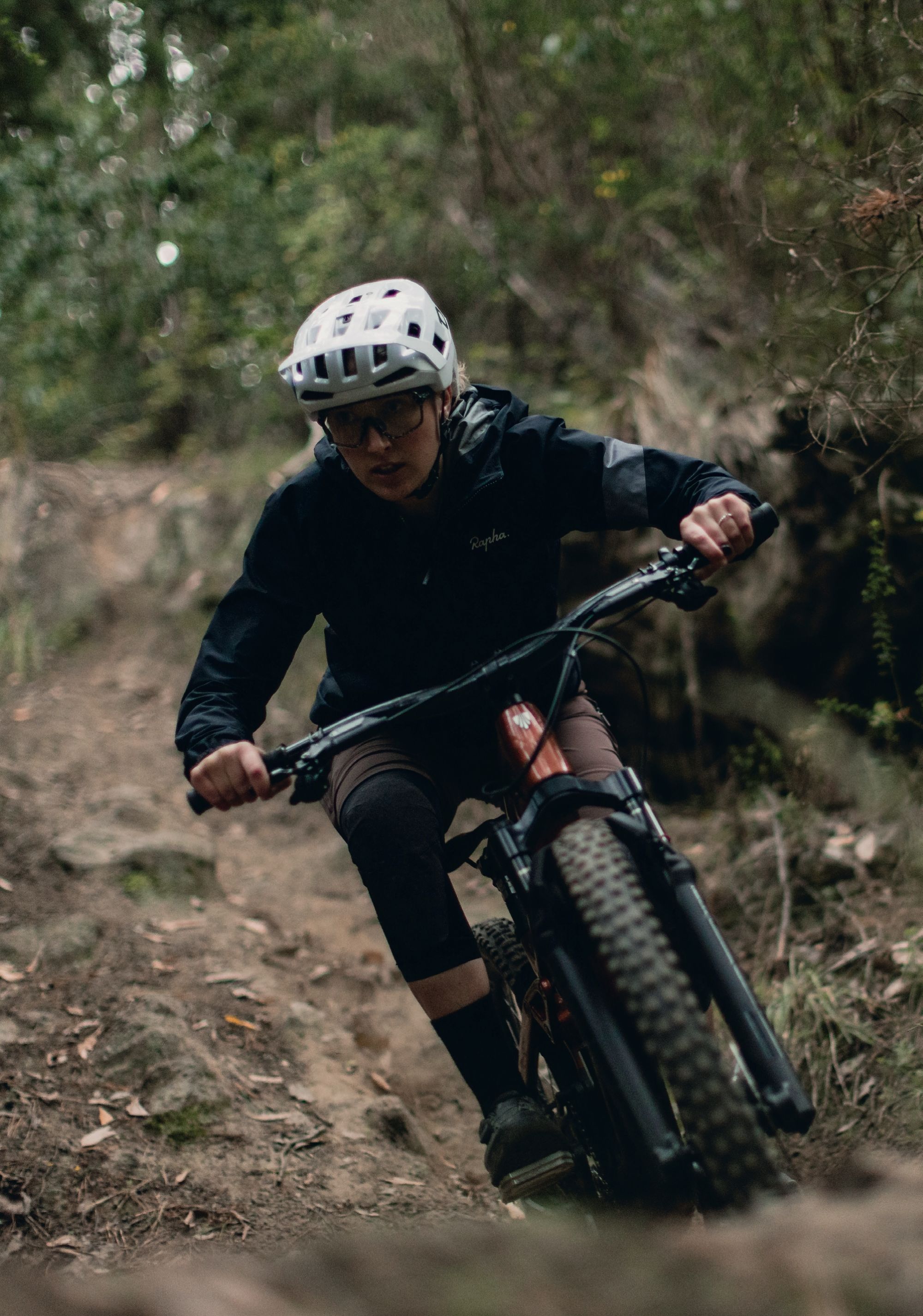
When it comes to contact points, I must admit I was a little skeptical when I noticed the SRAM Maven Silver brakes—a sore point with many stock eMTB builds is underpowered brakes, and constantly battling to control speed is taxing and creates an unnecessarily arduous ride experience, even if they’re great descenders otherwise. I was pleased to discover that this wasn’t a concern with the 4-piston Maven Silvers—when paired with hearty 200mm rotors, I didn’t once feel like the brakes were under-gunned and didn’t suffer from the sore hands I’ve so often had with other SL eMTB’s in the past. This was complemented by the levers being on the larger size with plenty of adjustability—a particularly important factor for smaller hands—and gradual modulation that allowed for increased control, which is well-suited for the steeper terrain that the Slash+ excels on. I was also pleased to report nothing but silence from these brakes, even in dry, dusty summer conditions—a welcome change from SRAM brakes of years gone by!
As was the case with the Fuel EXe, the Bontrager contact points left a little to be desired—the grips were thick, uncomfortable and incredibly slippery when wet, which I unfortunately discovered was compounded by the fact they take a long time to absorb once wet, due to their ribbed nature. Another change I’d be making immediately is the stock Bontrager SE5 Team Issue TLR tyre. Whilst a grunty 2.5” tyre such as this is a logical choice for a bike of this travel and, in theory, should be well suited to the terrain, the compound lacked grip and was a little more skatey on Victoria Park’s loose clay than was comfortable. A few “oh s***!!” moments were had as grip limits were hit a little earlier than preferred. I’m also fine compromising weight and rolling resistance to optimize grip, but this was a little on the slow side with next to no grip gains, and something I’d swap out pretty quickly for a softer compound option. I’m also pleased to say that throughout the Slash+’s tenure in our garage, not a single chain was dropped, and I didn’t experience any significant chain slap, even on the roughest of rock gardens and rooty sections.
Summary
The Slash+ is a heavy-hitting descender that delivers excellent ride performance when pointed down the most burly, technical trails in your backyard. With a bigger range than its younger brother, the Fuel EXe—but without the “chonk” of its bigger brother, the Rail—the Slash+ is Trek’s quietly capable middle child. Equipped with a quiet, subtle motor that’s so stealthily integrated that even the most eagle-eyed eMTB riders will need to look twice to see it, the Slash+ represents a well-rounded eMTB that has your back no matter what it’s pointed down. While you’re not going to lead any eMTB climbing segments on Strava, you will be making gains in your ability to ride more and squeeze in “one last lap”—even when the post-work clock is up against you. I have to agree with Goldilocks, there’s something to be said for things being “just right”, and the Slash+ might just epitomize that saying perfectly.

Specialized Levo Gen 4 Pro Carbon
Words Lester Perry
Images Cameron Mackenzie
RRP $19,900
Distributor Specialized NZ
Specialized’s eBike boffins have been at it again – this time with a revision of their marque Levo model. A 150/160mm travel trail bike, the Gen 4 builds on the Levo heritage and considers consumer feedback from riders who’ve previously Levo’d. They’ve ended up with a completely revised bike; almost every aspect has been refined, upgraded or tweaked. It’s evident that all the changes from Gen 3 have been considered and have a purpose; it’s not just change for the sake of it.
The design language is carried over from other recently released Specialized models; the Stumpjumper 15 and the Levo SL2 line. Levo Gen 4 has similar lines to the SL2, albeit with a beefier downtube and motor area, allowing for its larger, more powerful motor and larger battery. Most geometry numbers across the two bikes are within a gnat’s hair of each other. Thanks to this, I found the handling of the Gen 4 Levo very similar to the SL2 and, where characteristics differed, it was due to the extra weight of this full-powered bike. Geometry is comfortable and a great middle ground for all scenarios for a bike of this travel and intended trail use. The reach on an S4 size is 480mm, the head angle sits at 64.5 degrees, the seat tube at an acceptably steep 67 degrees, and 435mm chainstays in the stock short setting. As with the Levo SL line, there’s an adjustable head angle so, with a quick headset cup swap (only requiring an Allen key), the bike can gain or lose a degree of head angle—and flipping the hardware on the lower shock eye drops the bottom bracket -6mm from the stock high position of 350mm high. The rear end can grow by 9mm just by adjusting the chainstay flip chip, adding stability to the ride.
To keep the rear end short and put the lower suspension pivot in the optimal position, there’s no option (or clearance) to run a 29-inch rear wheel, so the bike is offered only in a mixed wheel (27.5/29”) format.
The new 3.1 motor breaks new ground for the Big S. Gone is the vulnerable, noisy internal belt, replaced by metal gears with a HardDrive coating offering increased durability and adding to the motor’s noticeably quieter running than the previous Levo. It sure is quiet – and even after it’s warm, after an hour of hard use, there’s no whining or increase in noise, just a gentle purr. Impressive.
Although it’s now 20% smaller overall, the motor hits 666W peak power across the range, with the baller S-Works edition punching up to 720W thanks to a different motor tune. Torque gets an increase, too, now 101nm with the S-Works getting 111nm. At higher cadences, where the previous Levo’s – and many other current motors – power delivery dropped off slightly, the Gen 4 maintains the peak power through a much higher cadence range.
A small but noticeable change in the width of the motor brings the Q-factor inwards 10mm; it is not massive, but it keeps the Q-factor closer to that of a standard pedal bike. For those who do a fair amount of pedalling and jump between the eBike and other rigs, it brings a more natural-feeling pedal stroke and, in some cases, should ease dodgy knees.
Battery capacity is boosted to 840Wh versus 700Wh on the previous generation Levo. A new internal battery cell layout allows for a shorter overall battery at a similar weight to the previous. A major but not noticeable change is the increase to a 48v system from 36v; apparently, this further increases the efficiency of the battery and electrics, allowing it to be more compact and extend the ride time.
The battery is now accessible from the non-drive side of the down tube; with a few rotations on a five millimetre Allen bolt, the battery door comes off. A gentle tug on a pull loop, and the battery simply slides out the side of the bike. Thanks to the shorter battery, there’s now a cavity up toward the headtube, allowing a SWAT bag to be tucked in place, held there by a magnet. There’s room to stash a tube, CO2, and Allen key in the watertight bag, which is handy.
A 600w/h battery is also available aftermarket, giving those who ride shorter times on the regular a lighter weight option. A 280w battery expander can be slid into the bottle cage in addition to the onboard 840w/h battery, offering a gargantuan 1120w/h for those who want to go on larger missions. Specialized claims an 80kg rider in Eco mode, climbing “significant elevation” could get 5.3 hours out of the system. I’d be happy to ride more aggressively, take it easy on Turbo assist, and get three rip-roaring hours out of the 1120w/h setup.
The new Mastermind controller has significant changes and upgrades from the previous version. The thumb shifter is wired to the screen tucked into the top tube, but both have had some welcome tweaks. The screen is much larger and now square, allowing for data that’s far more visible at a glance than the previous. The controller now has a power button at the top, a ‘toggle’ type lever in the middle, and a Walk Mode button beneath this. Pushing the toggle up or down scrolls the bike through its stock power modes, while pressing the toggle changes the data displayed. For those who want a bit of variation from the stock assistance levels, a long press ‘up’ on the toggle unlocks some fine-tuning options: Micro Tune and Dynamic Micro Tune. Micro Tune essentially lets you select the rider power amplify level in 10% increments, with equal bike input. Dynamic Micro tune is like Micro Tune, but enables you to choose assistance level for efficiency and battery saving while cruising, but automatically jumps back to 100% assistance when you kick up the power on the pedals, giving full assist for surprise pinch climbs or when you need some extra oomph while sprinting into a gap jump. These extra adjustments made possible by the new controller mean you can fine-tune the bike without requiring the phone app while riding—or even a phone at all if that’s your jam.
If you want even more tuning, the Specialized app has a couple of minor, but helpful, additions for the Gen 4 Levo. Overrun is a standard feature on many high-end eBike systems; the drive running on for a short period after you stop pedalling—this helps keep the bike moving forward, particularly when climbing technical trails where it’s necessary to stop pedalling over a trail feature so as not to clip a pedal or smash a crank, it also helps while climbing through high speed swooping turns, continuing to drive even when you need to stop pedalling for fear of bottoming a crank out while leaning into the turn. The ability to adjust how long the Overrun period is via the app (through Min, Default and Max) gives some interesting options for those trying to maintain maximum speed on rough, technical trails. It would be ideal for racing once you adapt your riding. I think it would take a bit more time to figure out what level is best and how to get the most out of the feature, so I was happy with the Default (middle) setting.
Cadence Coach is an interesting new feature that can be enabled in the app. When turned on, a rider can view their pedalling RPM on the Mastermind screen. As cadence changes, a circle around the RPM number changes colour and arrows appear, suggesting you should speed up or slow down your cadence to stay in the optimal zone. It’s an interesting feature for those with a history in cycling but likely a real eye-opener for those newer to the sport who are still figuring out ideal cadences. Provided a rider sits in the optimal cadence range, their battery will last longer, and power will be applied more efficiently. They’ll have to shift to the correct gear to keep their cadence ‘in the green’, minimising chain wear and saving the highest (smallest) cogs on what is a very expensive cassette.
The Specialized developed Genie Fox Float X2 takes care of rear suspension duties. The shock features standard metric 210mm x 55mm sizing, allowing for whatever aftermarket shock you would like to run, including a coil. I’m unsure why a change would be necessary, as I’m well impressed with the Genie’s performance on this bike and put time in on it during my SL2 review. It’s simple to set up and tune and has a coil- like feel. Suppleness early in the stroke helps maintain traction across all surfaces, but with enough support to still pop off and pump trail features. The bike I rode had the shock set up in its stock format but, like the SL2, I’d probably add a couple of bands into the main air spring to give a bit more support earlier in the stroke. Fox also takes care of the fork; a tried and proven Fox 38 Factory adorns the front of the bike – the perfect partner for the Genie shock, and stout enough to handle the weight of bike and rider.
Overall, the component choice is ideal for the bike, and I struggle to pick any holes. The SRAM XO Transmission drivetrain is the perfect choice for an eMTB. As stated previously, the Maven brakes are hard to beat. Dropper post duties are performed admirably by a Bike Yoke 170mm post. Handlebars are a wide Specialized option; they’re a 35mm clamp and, although the shape is comfy, I did find them harsh. Given more time with the bike, I would have swapped in a 31.8 stem and bar for comparison.
I have reservations about carbon wheels on eMTBs but, visually, these look like they’re probably up to the task. They’re plenty wide, and their 4mm thick beads should help ward off pinch flats and cracked rims. Being wrapped in the Gravity casing tyres should help, too. I guess time will tell.
Riding the Gen 4 Levo
I spent a solid couple of days putting the Gen 4 Levo through its paces and, although this gave a great window into the bike’s characteristics, it doesn’t give any idea of its longevity. My first day was on prime, dry trails in Christchurch’s Adventure Park and Vic Park. I made some minor air adjustments to suit my weight and riding style, sped up the rear end and slowed up the fork a couple of clicks. After this ride, I was happy I had a good baseline to start tweaking from. My second outing was in the Craigieburn range—firstly, a classic lap up the nice singletrack climb with some technical crux moves (no dabs!) to the Luge trail, followed by Dickson’s downhill. I dropped my fork and tyre pressure a fraction, then we were back down the road and up the gravel climb to Cheeseman’s trails for a lap of Cockayne Alley followed by Cuckoo Creek. Conditions were damp, and I was glad to have an eBike to quickly lap back up the climbs, spending minimal time outside the shelter of the tree canopy.
The more bikes I ride, the more I appreciate an easy setup; I just want to get on, adjust a couple of clicks here and there and go ride the damn thing. Granted, an eBike’s weight helps it feel better than a lousy setup or lower-end suspension may suggest, but there’s something to be said for a bike that just performs as it should without any significant effort put into setup.
Although I don’t imagine the Gen 4 is any lighter than an equivalent spec Gen 3 model, the bike doesn’t feel portly to ride, and the weight feels less on the trail than other equivalent-weight, full-powered eBikes I’ve ridden. It rides just like a similar trail bike but with more heft. I never felt that the bike had taken control, leaving me merely a passenger clinging to an overweight bike with luck choosing where it would go. I’ve been in this scenario on some bikes, and it’s a scary time.
The Gen 4’s geometry and suspension help keep things on line and in control. I found the bike to be stable and predictable over chunky rock sections, not getting deflected or pinged off-line. The bike inspired confidence when coming into steep chutes on trails I hadn’t ridden before. In a couple of these situations, I had to haul anchors to get my speed to a comfortable level; the SRAM Maven brakes highlight my thoughts that brakes can make or break an eBike riding experience. In this case, one of the most powerful brakes on the market, and massive rotors, are more than enough to bring the weighty combo of the bike and my weight to a stop in the steepest or sketchiest situations, even in the wet and on long descents.
During my two battery-draining rides, I cleaned some technical sections that were undoubtedly a stretch, and tested bike and rider to the limit. Thanks to the short 165mm cranks and the Run On mentioned above, I only bottomed out a crank once. Power is nothing if your back wheel is losing traction while climbing, and I was impressed that even on slick roots, clay or gravelly steep pinches the power in application is so smooth and consistent that it maintains traction longer than I expected—and no doubt longer than other bikes I’ve ridden in similar situations. I was impressed that even in Turbo mode, the power was applied so that it didn’t feel like it would tear my arms from their sockets, and there was no jerkiness or surprises. My whole experience with the motor, I’d term as ‘controlled’.
The Craigieburn Range trail conditions were less than ideal; heavy rain in the hours preceding our ride—and continual rain through the day— left puddles and standing water over anything flat, and descents were slipperier than ideal, with treacherous roots ready to claim anyone not 100% on the game. Bikes and riders were saturated, but the bikes didn’t skip a beat. If there were limits to the waterproofing on the bike or motor, we would have found them.
Specialized offers annual suspension pivot bearing replacement for the original owner’s lifetime. A great way to keep the bike performing at its best, particularly after a wet winter—although the tinfoil hat wearer in me thinks it may be a convenient way to get customers back into a Specialized shop more regularly. Judging by how little servicing my own bikes get, this is a good thing!
The bike’s balance was evident while flowing down some of Christchurch Adventure Park’s jump trails. It’s a predictable and confidence-inspiring bike to jump or even bunny hop. As with the Levo SL2, the Gen 4 rips turns; they’re easily initiated and the bike switches direction intuitively, no doubt a product of short chainstays, and the 27.5” rear wheel.
Fellow test rider, Nathan Petrie, had ridden this bike before I did and commented that the bike should have been specced with a 200mm dropper post, not the 170mm supplied. Nathan is a decent amount taller than me, and although a 200mm drop would be optimal for him, the 170mm drop was spot on for me. Sure, a 180mm drop would have worked for me, but that’s just splitting hairs. What would be ideal is a post with some travel adjustment, keeping everyone happy.
The Specialized Butcher Gravity T9 tyres specced on the bike I tested have been superseded since this bike was assembled. A newer version was recently launched but missed this production run. I’m glad to hear the bike will eventually come with the newer, better tyres as, although these were reasonable, they weren’t fantastic and did suffer in the wet. I’m positive there are better options out there that would perform well across a broader range of conditions. Word on the street is that the new Butcher is a decent step up from these, so hopefully, we’ll find them on production bikes soon.
Now, it’s no secret this bike will cost a buyer a decent wedge of cash and, taking that into account, is it worth all that money? Well, there are other bikes in the market at similar prices, but the few I have ridden didn’t offer the complete package we see here on the Levo Gen 4, from spec to setup to handling.
It’s no exaggeration to say this bike possesses the best overall handling and experience, beginning at setup, of any full-powered eBike I’ve ridden. My only questions regard longevity: outside of Specialized’s own internal—albeit extensive—testing, the new frame, motor, battery and controller are unproven over the long term.

Southern Comfort: Ōtepoti Dunedin
Words by Nathan Petrie
Images by Cameron MacKenzie
Despite being spoilt for choice when it comes to riding trip destinations in New Zealand, it can be hard to resist the pull of the Big Three: Queenstown, Nelson and Rotorua.
But, giving in to temptation can sometimes lead you to miss out on the great riding and memorable moments that come with seeing what else is out there. Oftentimes, it’s the trips to somewhere a bit different that deliver some of the best riding trip memories.
So, the question for us was; could we sneak in one last riding trip before summer was out? And, if we could, should we venture outside the norm and explore something different? With the sun rapidly setting on another summer of riding, it was time to tap into the unconventional and head south in search of something unique.
The destination of choice would be the South Island’s second largest city, Dunedin. It’s a place we’d all visited beforehand, to partake in something Dunedin has a rich history of: racing. However, just like going to the same old riding destination, racing only lets you catch a glimpse of what can be found when it comes to local trails. So, this time, we’d be off the clock and free to explore what Dunedin has to offer – both on and off the bike.
As a starting point for exploration of the riding on offer in Dunedin, it’s hard to go past the OG location of Signal Hill. Steeped in as much history as the streets you’ll traverse to get there from the city centre, Signal Hill’s a place that can’t really be missed.
Despite the history, the days of rolling past the back of the high school to a waiting shuttle vehicle for another lap down the famed downhill track are long gone. Now the extensive network of trails that have been carved into the hill are easily accessible via the purpose- built uphill trail; the Emerson’s Big Easy.
The climb lets riders access trails from the midpoint at The Plateau, the iconic Signal Hill summit, and a range of places in between. This easy climbing access, combined with the number of trails packed into the area, gives riders plenty of options when it comes to linking a run together.
A bit like the different access points on the way up, there’s a good range of trails on offer on the way down. While the original rocky Dunedin tech is never too far away, there’s also plenty of root laden goodness snaking through the natives, as well as some fast and flowy jumps.
With so much on offer, it’s easy to see why Signal Hill has been such a mainstay of Dunedin mountain biking and played a key role in national level races. The Otago Mountain Bike Club, with the help of supporters and sponsors such as Emerson’s, have put a lot into making Signal Hill a riding destination in itself—right on the doorstep of the central city.
This ongoing support for the local mountain bike community makes it an easy choice to head down to the Emerson’s brewery for a post ride refuel. Conveniently located between Signal Hill and the city centre, the brewery provides great beer and mountains of delicious food in an atmospheric setting. With plenty of seating both inside and out, as well as some brewery exclusives on tap, it’s an ideal place to unwind post-ride. Swapping stories from a day out on the trails and enjoying the relaxed and inviting atmosphere is a great way to round out the day.
While it’s always good to get some laps in at an expanded classic like Signal Hill, there’s plenty more on offer when it comes to Dunedin’s riding spots. A great example of this is the ever-expanding network at Whare Flat, located on the northwestern side of town. While it currently features less trails than Signal Hill, spread out over a larger area, they’re well connected by the series of gravel logging roads throughout the forest.
Once again, there’s a mix of trails to check out, from lower gradient rocky trails to steeper, root-filled trails with some fun corners and chutes. There are also a number of trails that make great use of some of the more unique features and terrain on offer in Whare Flat. From the gully, traversing turns and grade reversals on Instant Classic, to the stomach-drop-inducing rock roll on Karearea, you’re guaranteed to come away with some memories from a ride out here.
While stopping by local bike store, Off the Chain Cycles, for some supplies and a chat, we heard how this ever-growing network of trails came to be. Despite trails of some form always being present at Whare Flat, the level of development has been on the rise in recent years. A share of this comes from the location’s more recent inclusion in the Otepoti Enduro (formerly the 3 Peaks Enduro), and Signal Hill nearing capacity with trails. With some great terrain and features on offer, and a good network of roads to link things together, it’ll be interesting to see what the future holds for Whare Flat.
Going back to the Otepoti Enduro, another location that offers something a bit different is Nicols Creek. Located up in the Leith Valley and surrounded by lush native bush, Nicols Creek gives you the feeling of being immersed in nature while still being only a stone’s throw away from the city. The trails here have featured heavily in the Otepoti/3 Peaks enduros over the years and it’s easy to see why. A well graded climbing trail leads you up through the bush to an open viewpoint at the top of the descent. From here, you can either head back down or carry on up the remaining two-way track to the tussock and flax-covered tops – and an even more outstanding view of the city below.
After taking in the view and rolling back down the two-way track to the lower viewpoint, things start to get interesting as you drop into the main Nicols Enduro descent. Aside from a couple of brief stretches in the open, and a pocket of pine forest, you’re treated to an eventful descent through the dense native bush. The trail provides a long run down to the valley below and, being nestled underneath the dense canopy with plenty of leaf cover means it holds a decent amount of moisture. When you add in the serpentine roots snaking their way across the trail, you can be in for a bit of a challenge as you make your way down. Despite this, runs like these can be the highlight of a riding trip – provided everyone makes it down in passable shape!
Despite having a bit of distance between them, the lower number of trails at Whare Flat and Nicols Creek means it is possible to ride both in the same day. This ability to ride varied trails in completely different settings is something that’s not easily found in a lot of riding destinations.
After a day of sampling that much of the riding, it only makes sense to make your way back into town to sample some more of the eateries on offer in Dunedin. This time it was Moons, located on the south side of Dunedin’s famed Octagon, in the city centre. Moons taps into a bit of a common theme in Dunedin: amazingly restored historic buildings with stone and orange brick interior. Like many eateries in Dunedin, Moons does a great job sourcing a lot of their ingredients and products from smaller local suppliers. On top of this, they also brew their own beer in-house under the Dog Star label and use house-made dough in their ‘pizzettas’. Drawing on that quest for something different, you’ll be able to try out some of the more unique offerings on the menu – like the crumbed gherkins and charred tandoori octopus. With its diverse menu and great service, Moons is well worth a visit after a day’s riding.
The kind of quality, diversity and local influence isn’t just confined to Moons when it comes to eateries in Dunedin. That’s one thing you’ll notice if you do venture south for a riding trip; the hospitality options are a bit like the trails—diverse and easy to access. Whether it’s a pre-ride breakfast at The Perc, a between-ride fuel up at Beam Me Up Bagels or a post-ride unwind at Moons or Emerson’s, Dunedin’s got you pretty well covered.
After fitting in three of Dunedin’s main riding spots in our short trip, the biggest thing that stood out to us about this great southern location was probably the diversity and convenient access. With Nicols Creek, Whare Flat and Signal Hill all within a 5-15 minute drive from Dunedin’s iconic Octagon, you’re never really faced with a huge commute to access a diverse range of riding. Signal Hill is especially convenient and would be considered within riding distance from most accommodation spots in the CBD. While Whare Flat—and to a lesser degree, Nicols Creek—are easier to access by car, they’re still pretty convenient and you can easily ride both in the same day, as we did.
All three spots offer riders something different, both within and between all three of them. While there is still a bit of a common thread with more technical trails having a big presence in each location, there are also options for a good range of riders. Each spot has pretty good climbing access too, so whether you’re cutting around like us on our Specialized Levo’s (more on that later), or spinning the legs on a regular bike, it won’t be a one-and-done affair.
When it comes to thinking about your next riding trip, consider whether it might be time to switch things up a bit from the usual locations of choice. Try venturing somewhere a bit outside the norm and seeing what else is on offer out there. With its mix of trail styles, locations, features and foliage, Dunedin’s got a good range of options to pick from. Couple that with all of the trail locations lying pretty close to the city centre and you can access a lot of variety at multiple spots in a days’ riding. Add in the great food, culture, and some stunningly renovated accommodation options, and you’ve got the makings of an ideal riding destination.
Stay The Thomas Gregg Apartments
Eat Bakery on Bond, Big Lizard, Beam Me Up Bagels, Emmersons, Maggie’s, Moons
Ride Nicols Creek, Signal Hill, Whare Flat
Shop Off the Chain Cycles (local intel)



